FMS 2.0 Activity Tracking Module (2020)
Fellowship Management System
Attachment 6_FMS 2.0 Activity Tracking Module
Activity Tracking
OMB: 0920-0765
Form Approved
OMB No. 0920-0765
 Attachment
6 – FMS Activity Tracking Module
Exp. Date 01/31/2021
Attachment
6 – FMS Activity Tracking Module
Exp. Date 01/31/2021
Fellowship Management System (FMS)
FMS Activity Tracking Module
2020
Table of Contents
2.2 Sign-Up Page (For New Users) 9
3. eFMS System Help Desk Ticket 10
4. Activity Tracking Welcome Page 12
5. Activity Tracking Profile 13
6.1.3 Project Tracking Form 25
6.2.1 Conference Presentation 27
7.2.1 Summer Course Satisfaction Survey 67
7.3.1 Supervisor 1-Year Survey 108
7.3.2 Supervisor Exit Survey 119
7.5.1 Supervisor Exit Survey 145
7.5.3 Position Description Survey 166
8. Assessments & Evaluations 176
8.1.1 Supervisor Evaluation of Student Survey 176
8.2.2 6-Month CAL Assessment 190
8.3.1 Supervisor Evaluation of PE Fellow – End of Year 1 and Year 2 216
8.3.2 Accomplishment Review 229
8.4.1 Semi-Annual Activity Reporting (SAAR) 231
8.5.1 Mentor Feedback Survey 245
The purpose of this document is to list all the data elements collected online through the Fellowship Management System (FMS). The FMS activity tracking module is a streamlined mechanism for Centers for Disease Control and Prevention (CDC) fellow, program associates and host site supervisors to submit information online and track statuses of fellowship progression (e.g., CALs, competencies). The FMS is a robust flexible framework and the FMS Activity Tracking Module is tailored successfully for various CDC fellowships:
CDC E-learning Institute (ELI)
Epidemiology Elective Program (EEP)
Future Leaders in Infections and Global Health Threats (FLIGHT)
Laboratory Leadership Service (LLS)
CDC Steven M. Teutsch Prevention Effectiveness (PE) Fellowship
Public Health Associate Program (PHAP)
Public Health Informatics Fellowship Program (PHIFP)
Science Ambassador Fellowship (SAF)
1.1 Document Structure
This document is broken down by the major pages of the FMS Activity Tracking. In this document, each page of the FMS Activity Tracker has sections and some sub-sections. Instructions, login, and registration pages are included. Instructions and emails in the FMS Activity Tracker are tailored to each CDC fellowship’s requirements.
Following the screenshots in each section is a table that shows the status of the collection of data elements by each CDC fellowships. The following labels indicate the status of the collection:
“Yes” indicates that the fellowship collects the information and that applicants are required to submit this information.
“No” indicates that the fellowship does not collect this information.
“-“ indicates open text field
In addition, the table shows the data values of each data element, and for ones that have a list of dropdown values, the data value category is hyperlinked to its list located in the Appendix.
Figure 2.1-a. Sign-In Page

Figure 2.1-b. Privacy Act and Public Burden Information

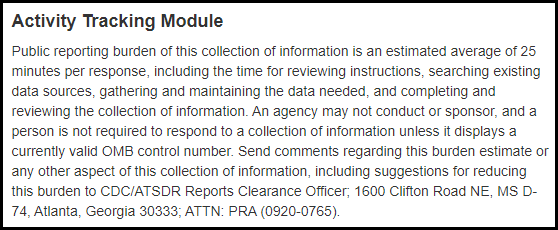
Table 2.1-a. Sign-In Fields
Field |
Values |
EIS |
LLS |
FLIGHT |
EEP |
SAF |
PHIFP |
PE |
ELI |
PHAP |
- |
Yes |
Yes |
Yes |
Yes |
Yes |
Yes |
Yes |
Yes |
Yes |
|
Password |
- |
Yes |
Yes |
Yes |
Yes |
Yes |
Yes |
Yes |
Yes |
Yes |
Figure 2.2-a. Sign-Up Fields
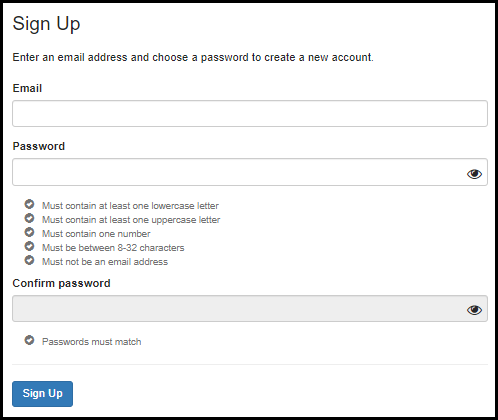
Table 2.2-a. Sign-Up Fields
Field |
Values |
EIS |
LLS |
FLIGHT |
EEP |
SAF |
PHIFP |
PE |
ELI |
PHAP |
- |
Yes |
Yes |
Yes |
Yes |
Yes |
Yes |
Yes |
Yes |
Yes |
|
Password |
- |
Yes |
Yes |
Yes |
Yes |
Yes |
Yes |
Yes |
Yes |
Yes |
Confirm Password |
- |
Yes |
Yes |
Yes |
Yes |
Yes |
Yes |
Yes |
Yes |
Yes |
Figure 3-a. eFMS System Help Desk Ticket Fields


Table 3-a. eFMS System Help Desk Ticket Fields
Field |
Values |
EIS |
LLS |
FLIGHT |
EEP |
SAF |
PHIFP |
PE |
ELI |
PHAP |
Your Name: |
- |
Yes |
Yes |
Yes |
Yes |
Yes |
Yes |
Yes |
Yes |
Yes |
Sign-In Email: |
- |
Yes |
Yes |
Yes |
Yes |
Yes |
Yes |
Yes |
Yes |
Yes |
Contact Phone Number: |
- |
Yes |
Yes |
Yes |
Yes |
Yes |
Yes |
Yes |
Yes |
Yes |
Fellowship: |
Yes |
Yes |
Yes |
Yes |
Yes |
Yes |
Yes |
Yes |
Yes |
|
What type of issue or need do you have? |
1.
System Error Message |
Yes |
Yes |
Yes |
Yes |
Yes |
Yes |
Yes |
Yes |
Yes |
URL where the issue is occurring: |
- |
Yes |
Yes |
Yes |
Yes |
Yes |
Yes |
Yes |
Yes |
Yes |
Error code message: |
- |
Yes |
Yes |
Yes |
Yes |
Yes |
Yes |
Yes |
Yes |
Yes |
Please describe your issue or need: |
- |
Yes |
Yes |
Yes |
Yes |
Yes |
Yes |
Yes |
Yes |
Yes |
Screenshot of error or issue (optional): |
- |
Yes |
Yes |
Yes |
Yes |
Yes |
Yes |
Yes |
Yes |
Yes |
Figure 4-a. Application Welcome Page
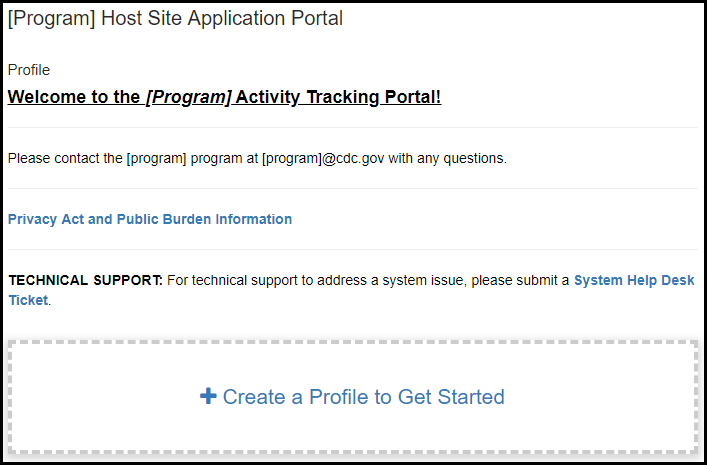
Figure 5.1-a. General Information Fields
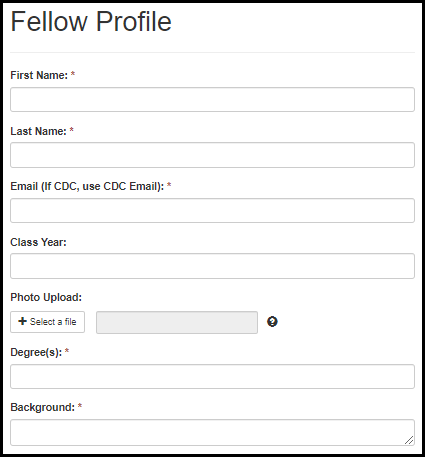
Table 5.1-a. General Information Fields
Field Name |
Values |
EIS |
LLS |
FLIGHT |
EEP |
SAF |
PHIFP |
PE |
ELI |
PHAP |
First Name: |
- |
Yes |
Yes |
Yes |
Yes |
Yes |
Yes |
Yes |
Yes |
Yes |
Last Name: |
- |
Yes |
Yes |
Yes |
Yes |
Yes |
Yes |
Yes |
Yes |
Yes |
CDC Employee? |
1.
Yes |
No |
No |
No |
No |
No |
No |
No |
No |
Yes
|
Email (If CDC, use CDC Email): |
- |
Yes |
Yes |
Yes |
Yes |
Yes |
Yes |
Yes |
Yes |
Yes |
Class Year: |
- |
Yes |
Yes |
Yes |
Yes |
Yes |
Yes |
Yes |
Yes |
Yes |
Photo Upload: |
- |
Yes |
Yes |
Yes |
Yes |
Yes |
Yes |
Yes |
Yes |
Yes |
Degree(s): |
- |
Yes |
Yes |
Yes |
Yes |
Yes |
Yes |
Yes |
Yes |
Yes |
Background: |
- |
Yes |
Yes |
Yes |
Yes |
Yes |
Yes |
Yes |
Yes |
Yes |
5.2 EEP
Figure 5.2-a. EEP Profile Fields
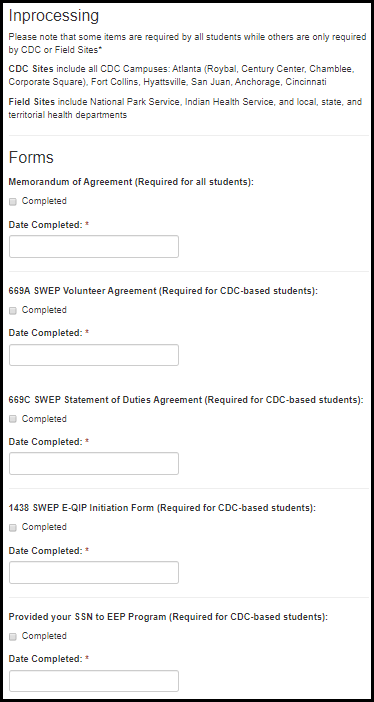
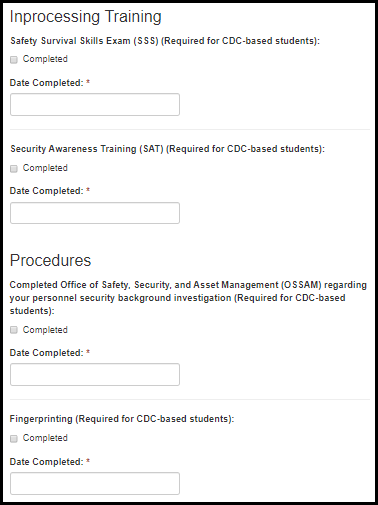
Table 5.2-a. EEP Profile Fields
Field Name |
Values |
EIS |
LLS |
FLIGHT |
EEP |
SAF |
PHIFP |
PE |
ELI |
PHAP |
Memorandum of Agreement (Required for all students): |
1. Completed |
No |
No |
No |
Yes |
No |
No |
No |
No |
No |
Date Completed: |
- |
No |
No |
No |
Yes |
No |
No |
No |
No |
No |
669A SWEP Volunteer Agreement (Required for CDC-based students): |
1. Completed |
No |
No |
No |
Yes |
No |
No |
No |
No |
No |
Date Completed: |
- |
No |
No |
No |
Yes |
No |
No |
No |
No |
No |
669C SWEP Statement of Duties Agreement (Required for CDC-based students): |
1. Completed |
No |
No |
No |
Yes |
No |
No |
No |
No |
No |
Date Completed: |
- |
No |
No |
No |
Yes |
No |
No |
No |
No |
No |
1438 SWEP E-QIP Initiation Form (Required for CDC-based students): |
1. Completed |
No |
No |
No |
Yes |
No |
No |
No |
No |
No |
Date Completed: |
- |
No |
No |
No |
Yes |
No |
No |
No |
No |
No |
Provided your SSN to EEP Program (Required for CDC-based students): |
1. Completed |
No |
No |
No |
Yes |
No |
No |
No |
No |
No |
Date Completed: |
- |
No |
No |
No |
Yes |
No |
No |
No |
No |
No |
Table 5.2-b. EEP Profile Fields
Field Name |
Values |
EIS |
LLS |
FLIGHT |
EEP |
SAF |
PHIFP |
PE |
ELI |
PHAP |
Safety Survival Skills Exam (SSS) (Required for CDC-based students): |
1. Completed |
No |
No |
No |
Yes |
No |
No |
No |
No |
No |
Date Completed: |
- |
No |
No |
No |
Yes |
No |
No |
No |
No |
No |
Security Awareness Training (SAT) (Required for CDC-based students): |
1. Completed |
No |
No |
No |
Yes |
No |
No |
No |
No |
No |
Date Completed: |
- |
No |
No |
No |
Yes |
No |
No |
No |
No |
No |
Completed Office of Safety, Security, and Asset Management (OSSAM) regarding your personnel security background investigation (Required for CDC-based students): |
1. Completed |
No |
No |
No |
Yes |
No |
No |
No |
No |
No |
Date Completed: |
- |
No |
No |
No |
Yes |
No |
No |
No |
No |
No |
Fingerprinting (Required for CDC-based students): |
1. Completed |
No |
No |
No |
Yes |
No |
No |
No |
No |
No |
Date Completed: |
- |
No |
No |
No |
Yes |
No |
No |
No |
No |
No |
Figure 5.3-b. EEP Profile Fields
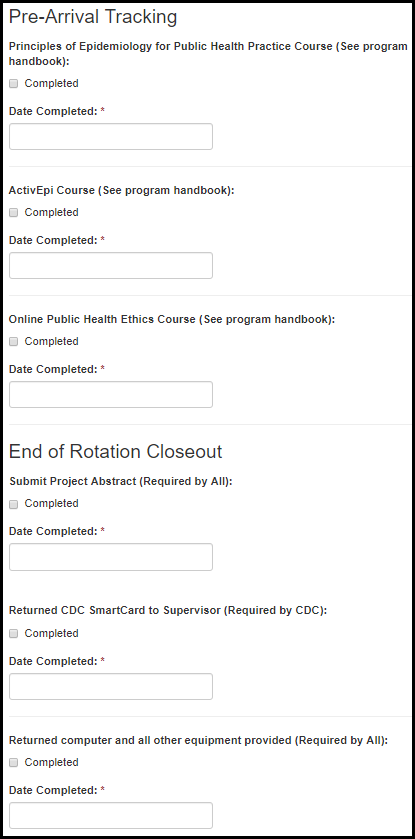
Table 5.3-c. EEP Profile Fields
Field Name |
Values |
EIS |
LLS |
FLIGHT |
EEP |
SAF |
PHIFP |
PE |
ELI |
PHAP |
Principles of Epidemiology for Public Health Practice Course (See program handbook) (Optional for all students): |
1. Completed |
No |
No |
No |
Yes |
No |
No |
No |
No |
No |
Date Completed: |
- |
No |
No |
No |
Yes |
No |
No |
No |
No |
No |
ActiEpi Course (See program handbook) (Optional for all students): |
1. Completed |
No |
No |
No |
Yes |
No |
No |
No |
No |
No |
Date Completed: |
- |
No |
No |
No |
Yes |
No |
No |
No |
No |
No |
Online Public Health Ethics Course (See program handbook) (Optional for all students): |
1. Completed |
No |
No |
No |
Yes |
No |
No |
No |
No |
No |
Date Completed: |
- |
No |
No |
No |
Yes |
No |
No |
No |
No |
No |
Submit Project Abstract (Required for all students): |
1. Completed |
No |
No |
No |
Yes |
No |
No |
No |
No |
No |
Date Completed: |
- |
No |
No |
No |
Yes |
No |
No |
No |
No |
No |
Return CDC SmartCard to Supervisor (Required for CDC-based students): |
1. Completed |
No |
No |
No |
Yes |
No |
No |
No |
No |
No |
Date Completed: |
- |
No |
No |
No |
Yes |
No |
No |
No |
No |
No |
Return computer and all other equipment provided (Required for all students): |
1. Completed |
No |
No |
No |
Yes |
No |
No |
No |
No |
No |
Date Completed: |
- |
No |
No |
No |
Yes |
No |
No |
No |
No |
No |
5.3 SAF
Figure 5.3-a. SAF Profile Fields

Figure 5.3-a. SAF Profile Fields
Field Name |
Values |
EIS |
LLS |
FLIGHT |
EEP |
SAF |
PHIFP |
PE |
ELI |
PHAP |
Public Health 101 (See program handbook) |
1. Completed |
No |
No |
No |
No |
Yes |
No |
No |
No |
No |
Date Completed: |
- |
No |
No |
No |
No |
Yes |
No |
No |
No |
No |
6.1.1 Project Goals
Figure 6.1.1-a. EEP Project Goal Fields
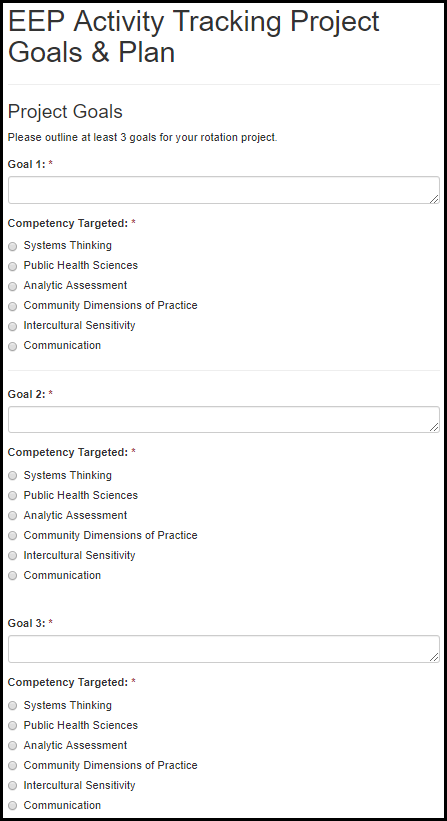
Table 6.1.1-a. EEP Project Goal Fields
Field Name |
Values |
EIS |
LLS |
FLIGHT |
EEP |
SAF |
PHIFP |
PE |
ELI |
PHAP |
Goal 1: |
- |
No |
No |
No |
Yes |
No |
No |
No |
No |
No |
Competency Domain Targeted: |
1.
Systems Thinking |
No |
No |
No |
Yes |
No |
No |
No |
No |
No |
Goal 2: |
- |
No |
No |
No |
Yes |
No |
No |
No |
No |
No |
Competency Domain Targeted: |
1.
Systems Thinking |
No |
No |
No |
Yes |
No |
No |
No |
No |
No |
Goal 3: |
- |
No |
No |
No |
Yes |
No |
No |
No |
No |
No |
Competency Domain Targeted: |
1.
Systems Thinking |
No |
No |
No |
Yes |
No |
No |
No |
No |
No |
6.1.2 Project Plan
Figure 6.1.2-a. EEP Project Plan Fields
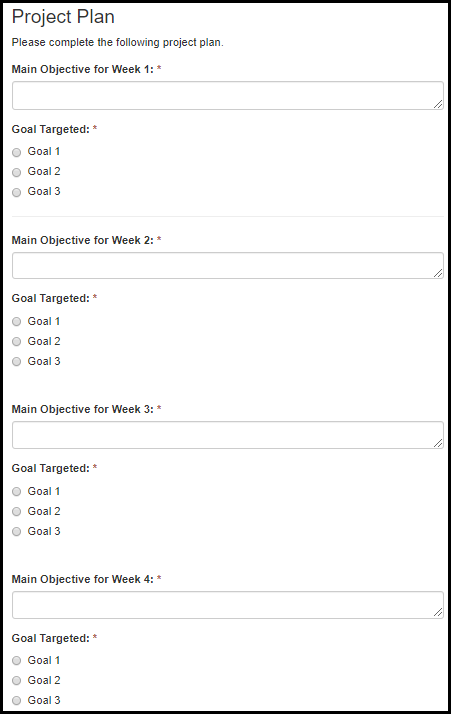
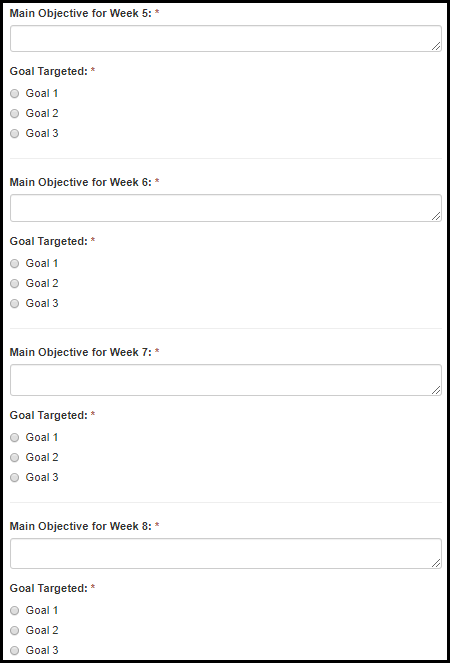
Figure 6.1.2-a. EEP Project Plan Fields
Field Name |
Values |
EIS |
LLS |
FLIGHT |
EEP |
SAF |
PHIFP |
PE |
ELI |
PHAP |
Main Objective for Week 1: |
- |
No |
No |
No |
Yes |
No |
No |
No |
No |
No |
Goal Targeted: |
1.
Goal 1 |
No |
No |
No |
Yes |
No |
No |
No |
No |
No |
Main Objective for Week 2: |
- |
No |
No |
No |
Yes |
No |
No |
No |
No |
No |
Goal Targeted: |
1.
Goal 1 |
No |
No |
No |
Yes |
No |
No |
No |
No |
No |
Main Objective for Week 3: |
- |
No |
No |
No |
Yes |
No |
No |
No |
No |
No |
Goal Targeted: |
1.
Goal 1 |
No |
No |
No |
Yes |
No |
No |
No |
No |
No |
Main Objective for Week 4: |
- |
No |
No |
No |
Yes |
No |
No |
No |
No |
No |
Goal Targeted: |
1.
Goal 1 |
No |
No |
No |
Yes |
No |
No |
No |
No |
No |
Main Objective for Week 5: |
- |
No |
No |
No |
Yes |
No |
No |
No |
No |
No |
Goal Targeted: |
1.
Goal 1 |
No |
No |
No |
Yes |
No |
No |
No |
No |
No |
Main Objective for Week 6: |
- |
No |
No |
No |
Yes |
No |
No |
No |
No |
No |
Goal Targeted: |
1.
Goal 1 |
No |
No |
No |
Yes |
No |
No |
No |
No |
No |
Main Objective for Week 7: |
- |
No |
No |
No |
Yes |
No |
No |
No |
No |
No |
Goal Targeted: |
1.
Goal 1 |
No |
No |
No |
Yes |
No |
No |
No |
No |
No |
Main Objective for Week 8: |
- |
No |
No |
No |
Yes |
No |
No |
No |
No |
No |
Goal Targeted: |
1.
Goal 1 |
No |
No |
No |
Yes |
No |
No |
No |
No |
No |
6.1.3 Project Tracking Form
Figure 6.1.3-a. EEP Project Tracking Form Fields
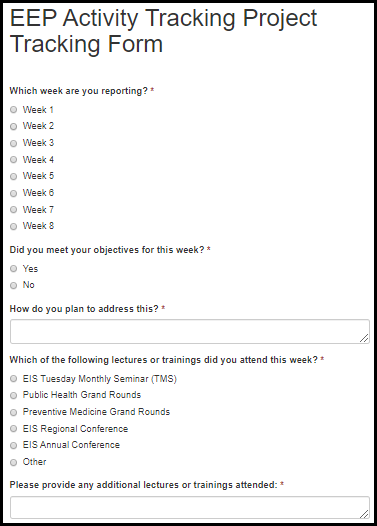
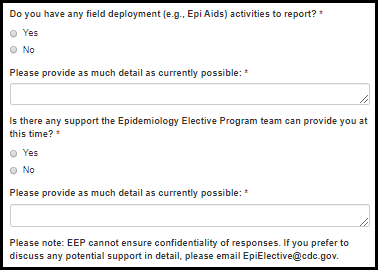
Table 6.1.3-a. EEP Project Tracking Form Fields
Field Name |
Values |
EIS |
LLS |
FLIGHT |
EEP |
SAF |
PHIFP |
PE |
ELI |
PHAP |
Which week are you reporting? |
1.
Week 1 |
No |
No |
No |
Yes |
No |
No |
No |
No |
No |
Did you meet your objectives for this week? |
1.
Yes |
No |
No |
No |
Yes |
No |
No |
No |
No |
No |
How do you plan to address this? |
- |
No |
No |
No |
Yes |
No |
No |
No |
No |
No |
Which of the following lectures or trainings did you attend this week? |
1.
EIS Tuesday Monthly Seminar (TMS) |
No |
No |
No |
Yes |
No |
No |
No |
No |
No |
Please provide any additional lectures or trainings attended: |
- |
No |
No |
No |
Yes |
No |
No |
No |
No |
No |
Do you have any field deployment (e.g., Epi Aids) activities to report? |
1.
Yes |
No |
No |
No |
Yes |
No |
No |
No |
No |
No |
Please provide as much detail as currently possible: |
- |
No |
No |
No |
Yes |
No |
No |
No |
No |
No |
Is there any support the Epidemiology Elective Program team can provide you at this time? |
1.
Yes |
No |
No |
No |
Yes |
No |
No |
No |
No |
No |
Please provide as much detail as currently possible: |
|
No |
No |
No |
Yes |
No |
No |
No |
No |
No |
Figure 6.2.1-a. Conference Presentation Fields
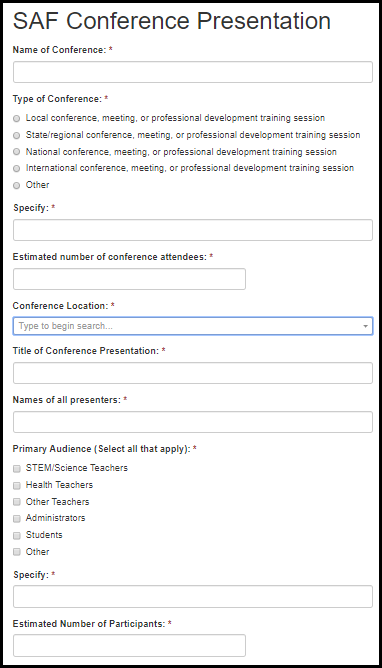
Table 6.2.1-a. Conference Presentation Fields
Field Name |
Values |
EIS |
LLS |
FLIGHT |
EEP |
SAF |
PHIFP |
PE |
ELI |
PHAP |
Name of Conference: |
- |
No |
No |
No |
No |
Yes |
No |
No |
No |
No |
Type of Conference: |
1. Local conference, meeting, or professional development training session 2. State/regional conference, meeting, or professional development training session 3. National conference, meeting, or professional development training session 4. International conference, meeting, or professional development training session 5. Other |
No |
No |
No |
No |
Yes |
No |
No |
No |
No |
Specify: |
- |
No |
No |
No |
No |
Yes |
No |
No |
No |
No |
Estimated number of conference attendees: |
- |
No |
No |
No |
No |
Yes |
No |
No |
No |
No |
Conference Location: |
No |
No |
No |
No |
Yes |
No |
No |
No |
No |
|
Title of Conference Presentation: |
- |
No |
No |
No |
No |
Yes |
No |
No |
No |
No |
Number of Presenters: |
- |
No |
No |
No |
No |
Yes |
No |
No |
No |
No |
Primary Audience (Select all that apply): |
1. STEM/Science Teachers 2. Health Teachers 3. Other Teachers 4. Administrators 5. Students 6. Other |
No |
No |
No |
No |
Yes |
No |
No |
No |
No |
Specify: |
- |
No |
No |
No |
No |
Yes |
No |
No |
No |
No |
Estimated number of presentation attendees: |
- |
No |
No |
No |
No |
Yes |
No |
No |
No |
No |
Figure 6.3.1-a. Success Story Fields
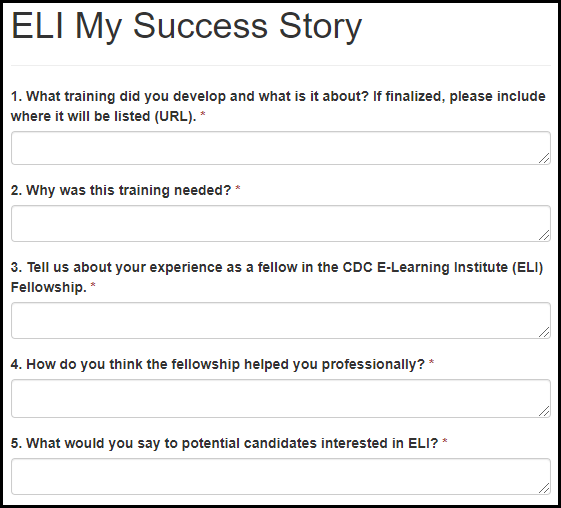
Table 6.3.1-a. Success Story Fields
Field Name |
Values |
EIS |
LLS |
FLIGHT |
EEP |
SAF |
PHIFP |
PE |
ELI |
PHAP |
1. What training did you develop and what is it about? If finalized, please include where it will be listed (URL). |
- |
No |
No |
No |
No |
No |
No |
No |
Yes |
No |
2. Why was this training needed? |
- |
No |
No |
No |
No |
No |
No |
No |
Yes |
No |
3. Tell us about your experience as a fellow in the CDC E-Learning Institute (ELI) Fellowship. |
- |
No |
No |
No |
No |
No |
No |
No |
Yes |
No |
4. How do you think the fellowship helped you professionally? |
- |
No |
No |
No |
No |
No |
No |
No |
Yes |
No |
5. What would you say to potential candidates interested in ELI? |
- |
No |
No |
No |
No |
No |
No |
No |
Yes |
No |
Figure 6.3.2-a. Photo Release Fields

Table 6.3.2-a. Photo Release Fields
Field Name |
Values |
EIS |
LLS |
FLIGHT |
EEP |
SAF |
PHIFP |
PE |
ELI |
PHAP |
Digital Signature: (Full Name) |
- |
No |
No |
No |
No |
No |
No |
No |
Yes |
No |
Figure 7.1.1.1.a. Introduction & Orientation Experience Fields
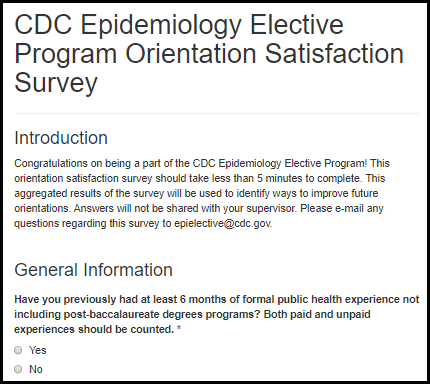
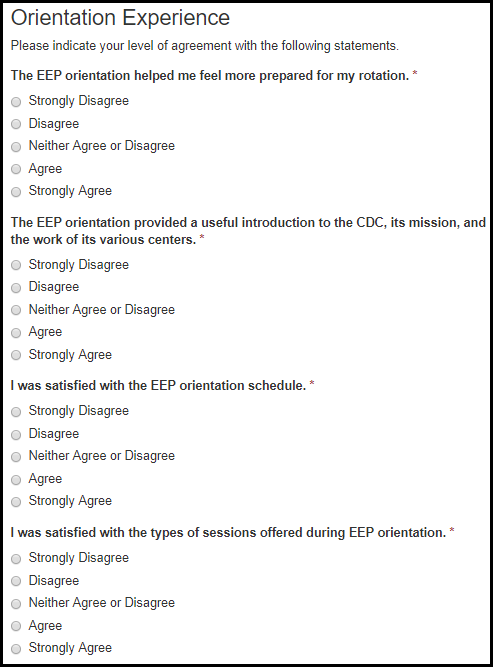
Table 7.1.1.1.a. Introduction & Orientation Experience Fields
Field Name |
Values |
EIS |
LLS |
FLIGHT |
EEP |
SAF |
PHIFP |
PE |
ELI |
PHAP |
Have you previously had at least 6 months of formal public health experience not including post-baccalaureate degrees programs? Both paid and unpaid experiences should be counted. |
1.
Yes |
No |
No |
No |
Yes |
No |
No |
No |
No |
No |
The EEP orientation helped me feel more prepared for my rotation. |
1.
Strongly Disagree |
No |
No |
No |
Yes |
No |
No |
No |
No |
No |
The EEP orientation provided a useful introduction to the CDC, its mission, and the work of its various centers. |
1.
Strongly Disagree |
No |
No |
No |
Yes |
No |
No |
No |
No |
No |
I was satisfied with the EEP orientation schedule. |
1.
Strongly Disagree |
No |
No |
No |
Yes |
No |
No |
No |
No |
No |
I was satisfied with the types of sessions offered during EEP orientation. |
1.
Strongly Disagree |
No |
No |
No |
Yes |
No |
No |
No |
No |
No |
Orientation Curriculum
Figure 7.1.1.2.a. Orientation Curriculum Fields

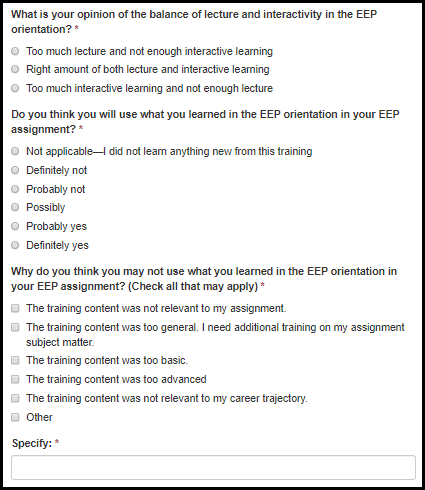
Table 7.1.1.2.a. Orientation Curriculum Fields
Field Name |
Values |
EIS |
LLS |
FLIGHT |
EEP |
SAF |
PHIFP |
PE |
ELI |
PHAP |
Please comment on which sessions were the most helpful in terms of best preparing you for the start of your EEP rotation: |
- |
No |
No |
No |
Yes |
No |
No |
No |
No |
No |
Please comment on which sessions were the least helpful in terms of best preparing you for the start of your EEP rotation and provide any suggestions for improvement: |
- |
No |
No |
No |
Yes |
No |
No |
No |
No |
No |
What were you hoping to learn in this training that was not covered? |
- |
No |
No |
No |
Yes |
No |
No |
No |
No |
No |
What is your opinion of the balance of lecture and interactivity in the EEP orientation? |
1.
Too much lecture and not enough interactive learning |
No |
No |
No |
Yes |
No |
No |
No |
No |
No |
Do you think you will use what you learned in the EEP orientation in your EEP assignment? |
1.
Not applicable—I did not learn anything new from this
training |
No |
No |
No |
Yes |
No |
No |
No |
No |
No |
Why do you think you may not use what you learned in the EEP orientation in your EEP assignment? (Check all that may apply) |
1.
The training content was not relevant to my assignment. |
No |
No |
No |
Yes |
No |
No |
No |
No |
No |
Please specify: |
- |
No |
No |
No |
Yes |
No |
No |
No |
No |
No |
Future Considerations
Figure 7.1.1.3.a. Future Consideration Fields
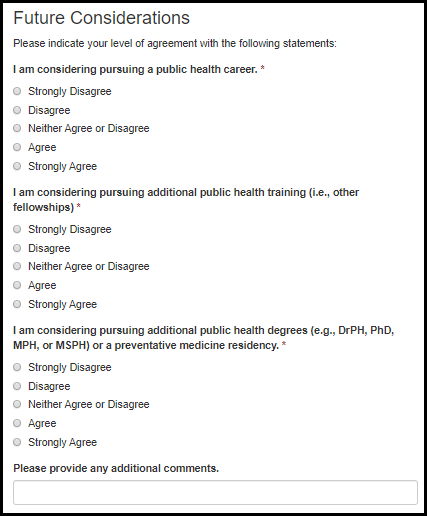
Table 7.1.1.3.a. Future Consideration Fields
Field Name |
Values |
EIS |
LLS |
FLIGHT |
EEP |
SAF |
PHIFP |
PE |
ELI |
PHAP |
I am considering pursuing a public health career. |
1.
Strongly Disagree |
No |
No |
No |
Yes |
No |
No |
No |
No |
No |
I am considering pursuing additional public health training (i.e., other fellowships) |
1.
Strongly Disagree |
No |
No |
No |
Yes |
No |
No |
No |
No |
No |
I am considering pursuing additional public health degrees (e.g., DrPH, PhD, MPH, or MSPH) or a preventative medicine residency. |
1.
Strongly Disagree |
No |
No |
No |
Yes |
No |
No |
No |
No |
No |
Please provide any additional comments. |
- |
No |
No |
No |
Yes |
No |
No |
No |
No |
No |
Getting Started
Figure 7.1.1.4.a. Getting Started Fields

Table 7.1.1.4.a. Getting Started Fields
Field Name |
Values |
EIS |
LLS |
FLIGHT |
EEP |
SAF |
PHIFP |
PE |
ELI |
PHAP |
Did you receive your computer? |
1.
Yes |
No |
No |
No |
Yes |
No |
No |
No |
No |
No |
When did you receive your computer? |
- |
No |
No |
No |
Yes |
No |
No |
No |
No |
No |
When do you expect to receive your computer? |
1.
This week |
No |
No |
No |
Yes |
No |
No |
No |
No |
No |
Did you receive your SmartCard? |
1.
Yes |
No |
No |
No |
Yes |
No |
No |
No |
No |
No |
When did you receive your SmartCard? |
- |
No |
No |
No |
Yes |
No |
No |
No |
No |
No |
When do you expect to receive your SmartCard? |
1.
This week |
No |
No |
No |
Yes |
No |
No |
No |
No |
No |
Please confirm that the email provided in your Profile is current and permanent: |
1. I confirm that the email on my Profile is current and permanent |
No |
No |
No |
Yes |
No |
No |
No |
No |
No |
Main Project and Supervisor
Figure 7.1.2.1.a. Main Project and Supervisor Fields
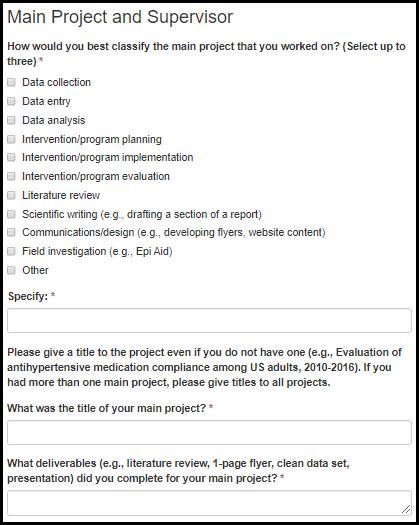
Table 7.1.2.1.a. Main Project and Supervisor Fields
Field Name |
Values |
EIS |
LLS |
FLIGHT |
EEP |
SAF |
PHIFP |
PE |
ELI |
PHAP |
How would you best classify the main project that you worked on? (Select up to three) |
1. Data collection 2. Data entry 3. Data analysis 4. Intervention/program planning 5. Intervention/program implementation 6. Intervention/program evaluation 7. Literature review 8. Scientific writing (e.g., drafting a section of a report) 9. Communications/design (e.g., developing flyers, website content) 10. Field investigation (e.g., Epi Aid) 11. Other |
No |
No |
No |
Yes |
No |
No |
No |
No |
No |
Specify: |
- |
No |
No |
No |
Yes |
No |
No |
No |
No |
No |
What was the title of your main project? |
- |
No |
No |
No |
Yes |
No |
No |
No |
No |
No |
What deliverables (e.g., literature review, 1-page flyer, clean data set, presentation) did you complete for your main project? |
- |
No |
No |
No |
Yes |
No |
No |
No |
No |
No |
Figure 7.1.2.1.b. Main Project and Supervisor Fields
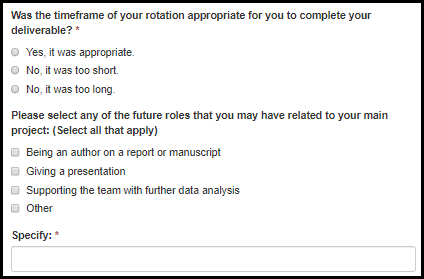
Table 7.1.2.1.b. Main Project and Supervisor Fields
Field Name |
Values |
EIS |
LLS |
FLIGHT |
EEP |
SAF |
PHIFP |
PE |
ELI |
PHAP |
Was the timeframe of your rotation appropriate for you to complete your deliverables? |
1.
Yes, it was appropriate. |
No |
No |
No |
Yes |
No |
No |
No |
No |
No |
Please select any of the future roles that you may have related to your main project: (Select all that apply) |
1.
Being an author on a report or manuscript |
No |
No |
No |
Yes |
No |
No |
No |
No |
No |
Specify: |
- |
No |
No |
No |
Yes |
No |
No |
No |
No |
No |
Figure 7.1.2.1.c. Main Project and Supervisor Fields
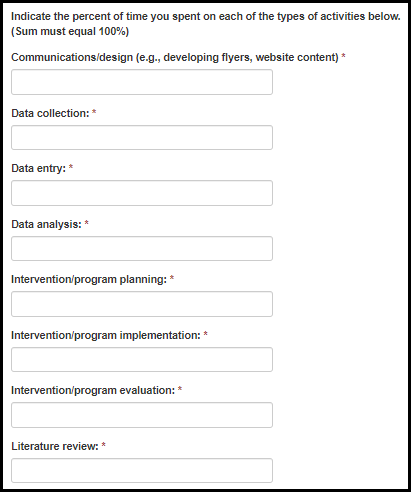

Table 7.1.2.1.c. Main Project and Supervisor Fields
Field Name |
Values |
EIS |
LLS |
FLIGHT |
EEP |
SAF |
PHIFP |
PE |
ELI |
PHAP |
Data collection: |
- |
No |
No |
No |
Yes |
No |
No |
No |
No |
No |
Data entry: |
- |
No |
No |
No |
Yes |
No |
No |
No |
No |
No |
Data analysis: |
- |
No |
No |
No |
Yes |
No |
No |
No |
No |
No |
Intervention/program planning: |
- |
No |
No |
No |
Yes |
No |
No |
No |
No |
No |
Intervention/program implementation: |
- |
No |
No |
No |
Yes |
No |
No |
No |
No |
No |
Intervention/program evaluation: |
- |
No |
No |
No |
Yes |
No |
No |
No |
No |
No |
Literature review: |
- |
No |
No |
No |
Yes |
No |
No |
No |
No |
No |
Scientific writing (e.g., drafting a section of a report): |
- |
No |
No |
No |
Yes |
No |
No |
No |
No |
No |
Communications/design (e.g., developing flyers, website content): |
- |
No |
No |
No |
Yes |
No |
No |
No |
No |
No |
Field investigation (e.g., Epi Aid): |
- |
No |
No |
No |
Yes |
No |
No |
No |
No |
No |
Other: Administrative duties |
- |
No |
No |
No |
Yes |
No |
No |
No |
No |
No |
Other: Meetings |
- |
No |
No |
No |
Yes |
No |
No |
No |
No |
No |
Other: Strategic planning |
- |
No |
No |
No |
Yes |
No |
No |
No |
No |
No |
Figure 7.1.2.1.e. Main Project and Supervisor Fields
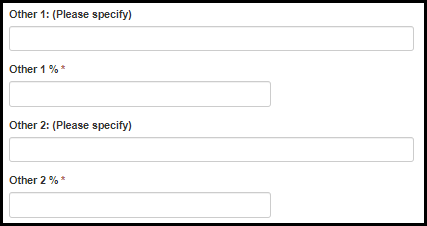
Table 7.1.2.1.e. Main Project and Supervisor Fields
Field Name |
Values |
EIS |
LLS |
FLIGHT |
EEP |
SAF |
PHIFP |
PE |
ELI |
PHAP |
Other 1: (Please specify) |
- |
No |
No |
No |
Yes |
No |
No |
No |
No |
No |
Other 1: % |
- |
No |
No |
No |
Yes |
No |
No |
No |
No |
No |
Other 2: (Please specify) |
- |
No |
No |
No |
Yes |
No |
No |
No |
No |
No |
Other 2: % |
- |
No |
No |
No |
Yes |
No |
No |
No |
No |
No |
Figure 7.1.2.1.f. Main Project and Supervisor Fields
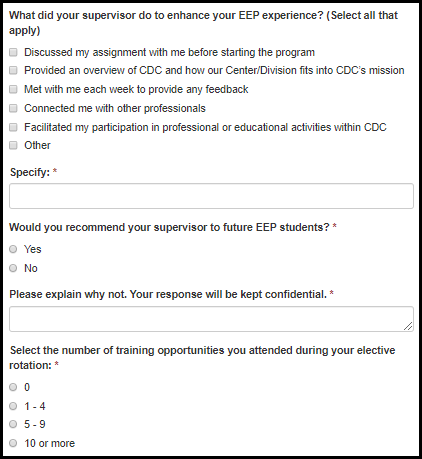
Table 7.1.2.1.f. Main Project and Supervisor Fields
Field Name |
Values |
EIS |
LLS |
FLIGHT |
EEP |
SAF |
PHIFP |
PE |
ELI |
PHAP |
What did your supervisor do to enhance your EEP experience? (Select all that apply) |
1.
Discussed my assignment with me before starting the program |
No |
No |
No |
Yes |
No |
No |
No |
No |
No |
Specify: |
- |
No |
No |
No |
Yes |
No |
No |
No |
No |
No |
Would you recommend your supervisor to future EEP students? |
1.
Yes |
No |
No |
No |
Yes |
No |
No |
No |
No |
No |
Please explain why not. Your response will be kept confidential. |
- |
No |
No |
No |
Yes |
No |
No |
No |
No |
No |
Select the number of training opportunities you attended during your elective rotation: |
1.
0 |
No |
No |
No |
Yes |
No |
No |
No |
No |
No |
Figure 7.1.2.1.g. Main Project and Supervisor Fields

Table 7.1.2.1.g. Main Project and Supervisor Fields
Field Name |
Values |
EIS |
LLS |
FLIGHT |
EEP |
SAF |
PHIFP |
PE |
ELI |
PHAP |
EEP communications provided useful information for additional training and networking opportunities. |
1.
Agree |
No |
No |
No |
Yes |
No |
No |
No |
No |
No |
Did you assist in a field investigation (e.g., an Epi-Aid)? |
1.
Yes |
No |
No |
No |
Yes |
No |
No |
No |
No |
No |
What CDC Center/Institute/Office conducted the field investigation (e.g., Epi-Aid)? (Select all that apply) |
No |
No |
No |
Yes |
No |
No |
No |
No |
No |
|
Division/Branch: |
- |
No |
No |
No |
Yes |
No |
No |
No |
No |
No |
Location of Investigation: |
No |
No |
No |
Yes |
No |
No |
No |
No |
No |
Figure 7.1.2.1.h. Main Project and Supervisor Fields

Table 7.1.2.1.h. Main Project and Supervisor Fields
Field Name |
Values |
EIS |
LLS |
FLIGHT |
EEP |
SAF |
PHIFP |
PE |
ELI |
PHAP |
Briefly describe your responsibilities in the field investigation (e.g., Epi Aid): |
- |
No |
No |
No |
Yes |
No |
No |
No |
No |
No |
Participation in a field investigation (e.g., Epi-Aid) increased my understanding of public health concepts through hands-on experience. |
1.
Strongly Disagree |
No |
No |
No |
Yes |
No |
No |
No |
No |
No |
Participation in a field investigation (e.g., Epi-Aid) increased my interest in pursuing a public health career. |
1.
Strongly Disagree |
No |
No |
No |
Yes |
No |
No |
No |
No |
No |
Participation in a field investigation (e.g, Epi-Aid) connected me with additional public health professionals. |
1.
Strongly Disagree |
No |
No |
No |
Yes |
No |
No |
No |
No |
No |
Competencies
Figure 7.1.2.2.a. Competency Fields

Figure 7.1.2.2.b. Competency Fields
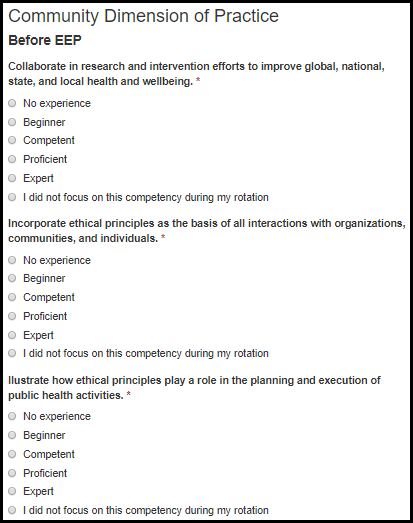

Table 7.1.2.2.a. Competency Fields
Field Name |
Values |
EIS |
LLS |
FLIGHT |
EEP |
SAF |
PHIFP |
PE |
ELI |
PHAP |
Collaborate in research and intervention efforts to improve global, national, state, and local health and wellbeing. |
1. No experience 2. Beginner 3. Competent 4. Proficient 5. Expert 6. I did not focus on this competency during my rotation |
No |
No |
No |
Yes |
No |
No |
No |
No |
No |
Incorporate ethical principles as the basis of all interactions with organizations, communities, and individuals. |
1. No experience 2. Beginner 3. Competent 4. Proficient 5. Expert 6. I did not focus on this competency during my rotation |
No |
No |
No |
Yes |
No |
No |
No |
No |
No |
Illustrate how ethical principles play a role in the planning and execution of public health activities. |
1. No experience 2. Beginner 3. Competent 4. Proficient 5. Expert 6. I did not focus on this competency during my rotation |
No |
No |
No |
Yes |
No |
No |
No |
No |
No |
Figure 7.1.2.2.b. Competency Fields
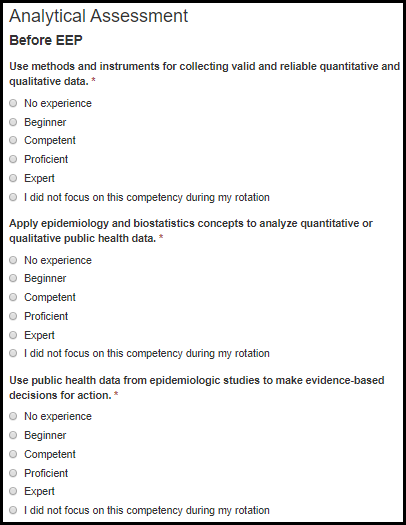
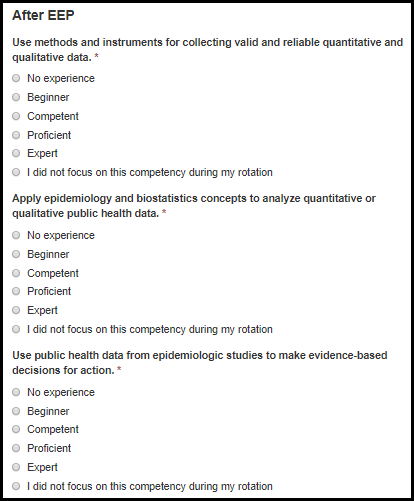
Table 7.1.2.2.b. Competency Fields
Field Name |
Values |
EIS |
LLS |
FLIGHT |
EEP |
SAF |
PHIFP |
PE |
ELI |
PHAP |
Use methods and instruments for collecting valid and reliable quantitative and qualitative data. |
1. No experience 2. Beginner 3. Competent 4. Proficient 5. Expert 6. I did not focus on this competency during my rotation |
No |
No |
No |
Yes |
No |
No |
No |
No |
No |
Apply epidemiology and biostatistics concepts to analyze quantitative or qualitative public health data. |
1. No experience 2. Beginner 3. Competent 4. Proficient 5. Expert 6. I did not focus on this competency during my rotation |
No |
No |
No |
Yes |
No |
No |
No |
No |
No |
Use public health data from epidemiologic studies to make evidence-based decisions for action. |
1. No experience 2. Beginner 3. Competent 4. Proficient 5. Expert 6. I did not focus on this competency during my rotation |
No |
No |
No |
Yes |
No |
No |
No |
No |
No |
Figure 7.1.2.2.c. Competency Fields
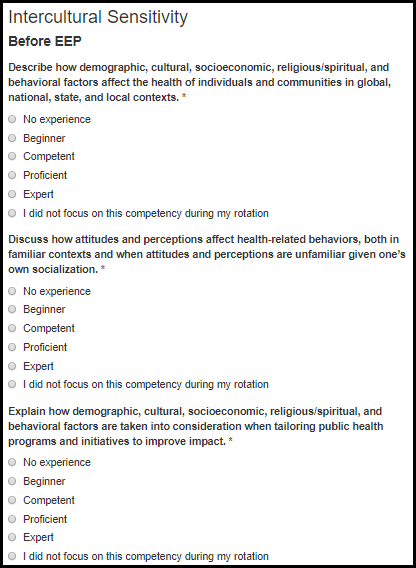

Table 7.1.2.2.c. Competency Fields
Field Name |
Values |
EIS |
LLS |
FLIGHT |
EEP |
SAF |
PHIFP |
PE |
ELI |
PHAP |
Describe how demographic, cultural, socioeconomic, religious/spiritual, and behavioral factors affect the health of individuals and communities in global, national, state, and local contexts. |
1. No experience 2. Beginner 3. Competent 4. Proficient 5. Expert 6. I did not focus on this competency during my rotation |
No |
No |
No |
Yes |
No |
No |
No |
No |
No |
Discuss how attitudes and perceptions affect health-related behaviors, both in familiar contexts and when attitudes and perceptions are unfamiliar given one’s own socialization. |
1. No experience 2. Beginner 3. Competent 4. Proficient 5. Expert 6. I did not focus on this competency during my rotation |
No |
No |
No |
Yes |
No |
No |
No |
No |
No |
Explain how demographic, cultural, socioeconomic, religious/spiritual, and behavioral factors are taken into consideration when tailoring public health programs and initiatives to improve impact. |
1. No experience 2. Beginner 3. Competent 4. Proficient 5. Expert 6. I did not focus on this competency during my rotation |
No |
No |
No |
Yes |
No |
No |
No |
No |
No |
Figure 7.1.2.2.d. Competency Fields
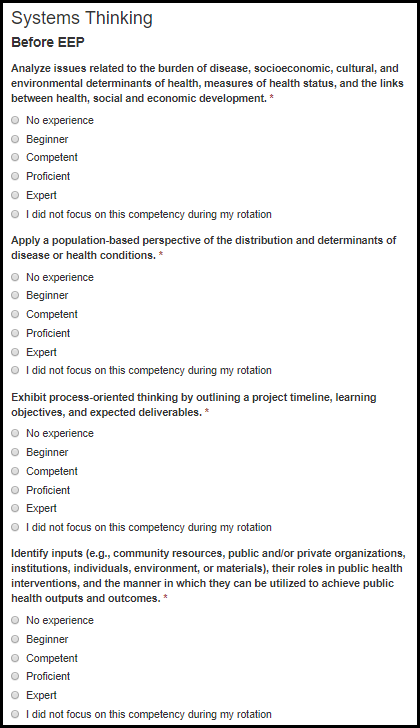

Table 7.1.2.2.d. Competency Fields
Field Name |
Values |
EIS |
LLS |
FLIGHT |
EEP |
SAF |
PHIFP |
PE |
ELI |
PHAP |
Analyze issues related to the burden of disease, socioeconomic, cultural, and environmental determinants of health, measures of health status, and the links between health, social and economic development. |
1. No experience 2. Beginner 3. Competent 4. Proficient 5. Expert 6. I did not focus on this competency during my rotation
|
No |
No |
No |
Yes |
No |
No |
No |
No |
No |
Apply a population-based perspective of the distribution and determinants of disease or health conditions. |
1. No experience 2. Beginner 3. Competent 4. Proficient 5. Expert 6. I did not focus on this competency during my rotation
|
No |
No |
No |
Yes |
No |
No |
No |
No |
No |
Exhibit process-oriented thinking by outlining a project timeline, learning objectives, and expected deliverables. |
1. No experience 2. Beginner 3. Competent 4. Proficient 5. Expert 6. I did not focus on this competency during my rotation
|
No |
No |
No |
Yes |
No |
No |
No |
No |
No |
Identify inputs (e.g., community resources, public and/or private organizations, institutions, individuals, environment, or materials), their roles in public health interventions, and the manner in which they can be utilized to achieve public health outputs and outcomes. |
1. No experience 2. Beginner 3. Competent 4. Proficient 5. Expert 6. I did not focus on this competency during my rotation
|
No |
No |
No |
Yes |
No |
No |
No |
No |
No |
Figure 7.1.2.2.e. Competency Fields
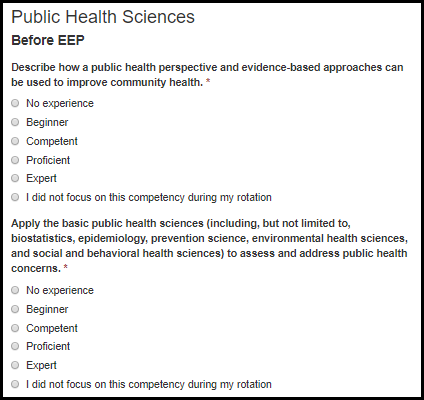
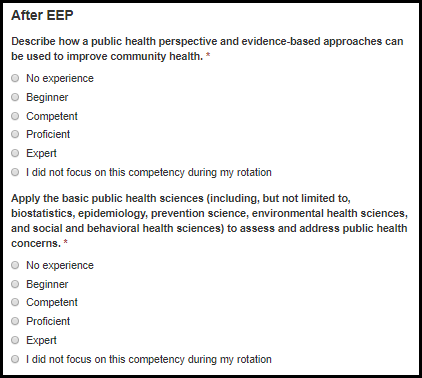
Table 7.1.2.2.e. Competency Fields
Field Name |
Values |
EIS |
LLS |
FLIGHT |
EEP |
SAF |
PHIFP |
PE |
ELI |
PHAP |
Describe how a public health perspective and evidence-based approaches can be used to improve community health. |
1. No experience 2. Beginner 3. Competent 4. Proficient 5. Expert 6. I did not focus on this competency during my rotation
|
No |
No |
No |
Yes |
No |
No |
No |
No |
No |
Apply the basic public health sciences (including, but not limited to, biostatistics, epidemiology, prevention science, environmental health sciences, and social and behavioral health sciences) to assess and address public health concerns. |
1. No experience 2. Beginner 3. Competent 4. Proficient 5. Expert 6. I did not focus on this competency during my rotation
|
No |
No |
No |
Yes |
No |
No |
No |
No |
No |
Figure 7.1.2.2.f. Competency Fields


Table 7.1.2.2.f. Competency Fields
Field Name |
Values |
EIS |
LLS |
FLIGHT |
EEP |
SAF |
PHIFP |
PE |
ELI |
PHAP |
Use the standard scientific format to clearly and concisely report research findings. |
1. No experience 2. Beginner 3. Competent 4. Proficient 5. Expert 6. I did not focus on this competency during my rotation
|
No |
No |
No |
Yes |
No |
No |
No |
No |
No |
Participate in teams as a member and/or leader. |
1. No experience 2. Beginner 3. Competent 4. Proficient 5. Expert 6. I did not focus on this competency during my rotation
|
No |
No |
No |
Yes |
No |
No |
No |
No |
No |
Communicate orally, electronically, and in writing with linguistic and cultural proficiency. |
1. No experience 2. Beginner 3. Competent 4. Proficient 5. Expert 6. I did not focus on this competency during my rotation
|
No |
No |
No |
Yes |
No |
No |
No |
No |
No |
Solicit and discuss feedback from supervisors and colleagues to improve personal learning. |
1. No experience 2. Beginner 3. Competent 4. Proficient 5. Expert 6. I did not focus on this competency during my rotation
|
No |
No |
No |
Yes |
No |
No |
No |
No |
No |
Future Considerations
Figure 7.1.2.3.a. Future Consideration Fields
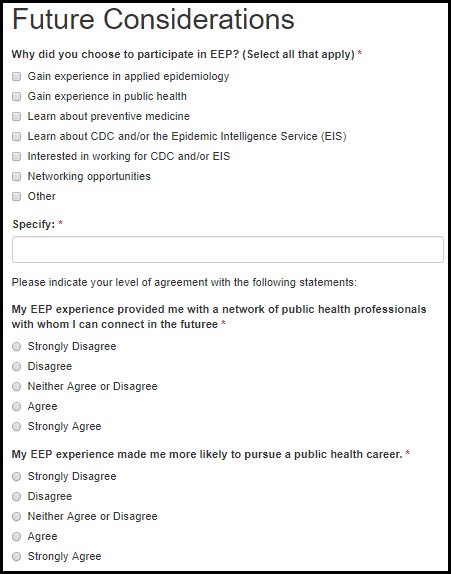
Table 7.1.2.3.a. Future Consideration Fields
Field Name |
Values |
EIS |
LLS |
FLIGHT |
EEP |
SAF |
PHIFP |
PE |
ELI |
PHAP |
Why did you choose to participate in EEP? (Select all that apply) |
1.
Gain experience in applied epidemiology |
No |
No |
No |
Yes |
No |
No |
No |
No |
No |
Please specify: |
- |
No |
No |
No |
Yes |
No |
No |
No |
No |
No |
My EEP experience provided me with a network of public health professionals with whom I can connect in the future. |
1.
Strongly Disagree |
No |
No |
No |
Yes |
No |
No |
No |
No |
No |
My EEP experience made me more likely to pursue a public health career. |
1.
Strongly Disagree |
No |
No |
No |
Yes |
No |
No |
No |
No |
No |
My EEP experience made me more likely to incorporate public health perspectives into clinical practice. |
1.
Strongly Disagree |
No |
No |
No |
Yes |
No |
No |
No |
No |
No |
My EEP experience made me more likely to pursue additional public health training. |
1.
Strongly Disagree |
No |
No |
No |
Yes |
No |
No |
No |
No |
No |
Figure 7.1.2.3.b. Future Consideration Fields
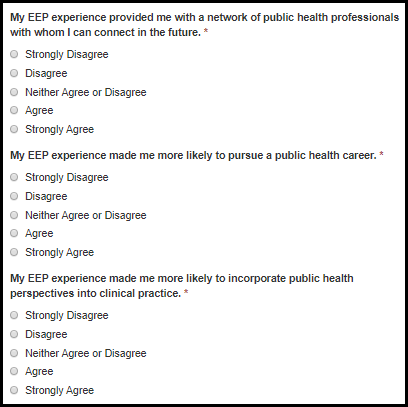
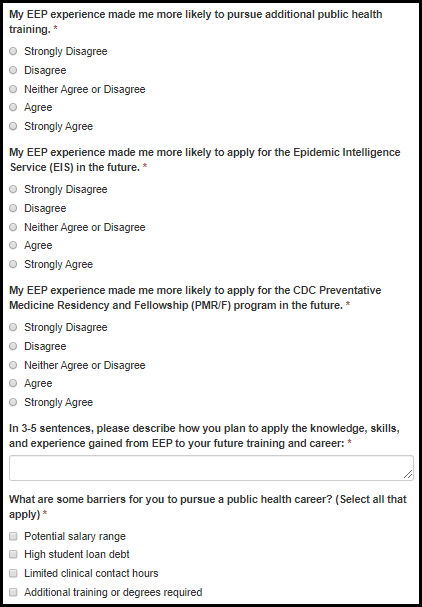
Table 7.1.3.4.b. Future Consideration Fields
Field Name |
Values |
EIS |
LLS |
FLIGHT |
EEP |
SAF |
PHIFP |
PE |
ELI |
PHAP |
My EEP experience made me more likely to apply for the Epidemic Intelligence Service (EIS) in the future. |
1.
Strongly Disagree |
No |
No |
No |
Yes |
No |
No |
No |
No |
No |
My EEP experience made me more likely to apply for the CDC Preventative Medicine Residency and Fellowship (PMR/F) program in the future. |
1.
Strongly Disagree |
No |
No |
No |
Yes |
No |
No |
No |
No |
No |
In 3-5 sentences, please describe how you plan to apply the knowledge, skills, and experience gained from EEP to your future training and career: |
- |
No |
No |
No |
Yes |
No |
No |
No |
No |
No |
What are some barriers for you to pursue a public health career? (Select all that apply) |
1. Potential salary range 2. High student loan debt 3. Limited clinical contact hours 4.
Additional training or degrees required |
No |
No |
No |
Yes |
No |
No |
No |
No |
No |
Figure 7.2.1.1.a. Introduction Fields

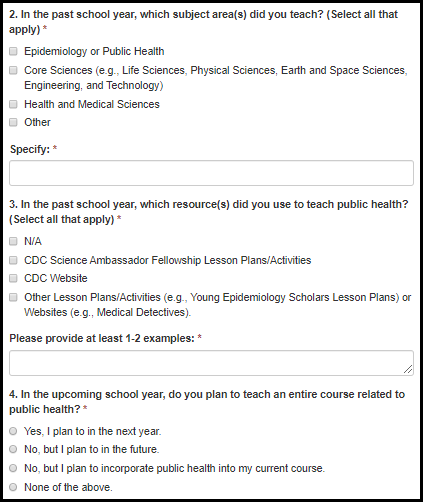
Table 7.2.1.1.a. Introduction Fields
Field Name |
Values |
EIS |
LLS |
FLIGHT |
EEP |
SAF |
PHIFP |
PE |
ELI |
PHAP |
1. In the past school year, which grade(s) did you teach? (Select all that apply) |
1. Elementary School (grades K-5) 2. Middle School (grades 6-8) 3. High School (grades 9-12) 2. Community College 3. College (Undergraduate) 4. College (Graduate) 5. Other: Curriculum Development 6. Other: Professional Development 7. Other (Specify) |
No |
No |
No |
No |
Yes |
No |
No |
No |
No |
Specify: |
- |
No |
No |
No |
No |
Yes |
No |
No |
No |
No |
2. In the past school year, which subject area(s) did you teach? (Select all that apply) |
1.
Epidemiology or Public Health |
No |
No |
No |
No |
Yes |
No |
No |
No |
No |
Specify: |
- |
No |
No |
No |
No |
Yes |
No |
No |
No |
No |
3. In the past school year, which resource(s) did you use to teach public health? (Select all that apply) |
1.
N/A |
No |
No |
No |
No |
Yes |
No |
No |
No |
No |
Examples: |
- |
No |
No |
No |
No |
Yes |
No |
No |
No |
No |
4. In the upcoming school year, do you plan to teach an entire course related to public health? |
1.
Yes, I plan to in the next year. |
No |
No |
No |
No |
Yes |
No |
No |
No |
No |
Figure 7.2.1.1.b. Introduction Fields
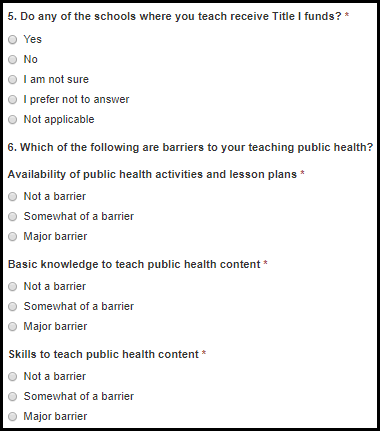

Table 7.2.1.1.b. Introduction Fields
Field Name |
Values |
EIS |
LLS |
FLIGHT |
EEP |
SAF |
PHIFP |
PE |
ELI |
PHAP |
5. Do any of the schools where you teach receive Title I funds? |
1.
Yes |
No |
No |
No |
No |
Yes |
No |
No |
No |
No |
Availability of public health activities and lesson plans |
1.
Not a barrier |
No |
No |
No |
No |
Yes |
No |
No |
No |
No |
Basic knowledge to teach public health content |
1.
Not a barrier |
No |
No |
No |
No |
Yes |
No |
No |
No |
No |
Skills to teach public health content |
1.
Not a barrier |
No |
No |
No |
No |
Yes |
No |
No |
No |
No |
Confidence in teaching public health content |
1.
Not a barrier |
No |
No |
No |
No |
Yes |
No |
No |
No |
No |
School support for teaching public health content |
1.
Not a barrier |
No |
No |
No |
No |
Yes |
No |
No |
No |
No |
Student interest in public health |
1.
Not a barrier |
No |
No |
No |
No |
Yes |
No |
No |
No |
No |
Other (Specify) |
1.
Not a barrier |
No |
No |
No |
No |
Yes |
No |
No |
No |
No |
Specify: |
|
No |
No |
No |
No |
Yes |
No |
No |
No |
No |
Figure 7.2.1.1.c. Introduction Fields
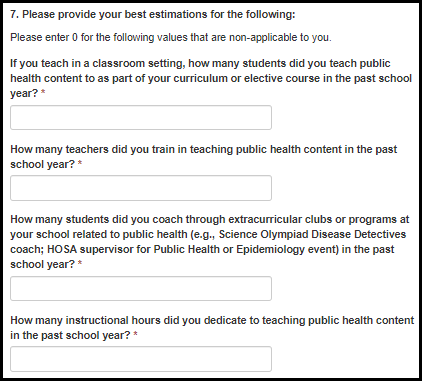
Table 7.2.1.1.c. Introduction Fields
Field Name |
Values |
EIS |
LLS |
FLIGHT |
EEP |
SAF |
PHIFP |
PE |
ELI |
PHAP |
If you teach in a classroom setting, how many students did you teach public health content to as part of your curriculum or elective course in the past school year? |
- |
No |
No |
No |
No |
Yes |
No |
No |
No |
No |
How many teachers did you train in teaching public health content in the past school year? |
- |
No |
No |
No |
No |
Yes |
No |
No |
No |
No |
How many students did you coach through extracurricular clubs or programs at your school related to public health (e.g., Science Olympiad Disease Detectives coach; HOSA supervisor for Public Health or Epidemiology event) in the past school year? |
- |
No |
No |
No |
No |
Yes |
No |
No |
No |
No |
How many instructional hours did you dedicate to teaching public health content in the past school year? |
- |
No |
No |
No |
No |
Yes |
No |
No |
No |
No |
Figure 7.2.1.1.d. Introduction Fields
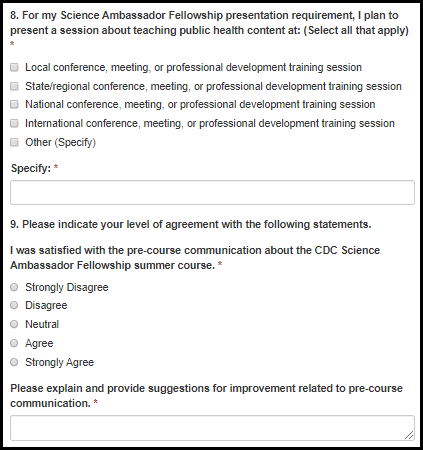
Table 7.2.1.1.d. Introduction Fields
Field Name |
Values |
EIS |
LLS |
FLIGHT |
EEP |
SAF |
PHIFP |
PE |
ELI |
PHAP |
8. For my Science Ambassador Fellowship presentation requirement, I plan to present a session about teaching public health content at: (Select all that apply) |
1.
Local conference, meeting, or professional development training
session |
No |
No |
No |
No |
Yes |
No |
No |
No |
No |
Specify: |
- |
No |
No |
No |
No |
Yes |
No |
No |
No |
No |
I was satisfied with the pre-course communication about the CDC Science Ambassador Fellowship summer course. |
1.
Strongly Disagree |
No |
No |
No |
No |
Yes |
No |
No |
No |
No |
Please explain and provide suggestions for improvement related to pre-course communication. |
- |
No |
No |
No |
No |
Yes |
No |
No |
No |
No |
Figure 7.2.1.1.e. Introduction Fields
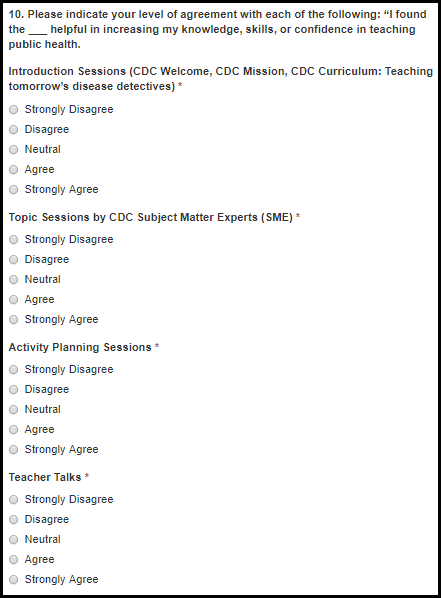
Table 7.2.1.1.e. Introduction Fields
Field Name |
Values |
EIS |
LLS |
FLIGHT |
EEP |
SAF |
PHIFP |
PE |
ELI |
PHAP |
Introduction Sessions (CDC Welcome, CDC Mission, CDC Curriculum: Teaching tomorrow’s disease detectives) |
1.
Strongly Disagree |
No |
No |
No |
No |
Yes |
No |
No |
No |
No |
Topic Sessions by CDC Subject Matter Experts (SME) |
1.
Strongly Disagree |
No |
No |
No |
No |
Yes |
No |
No |
No |
No |
Activity Planning Sessions |
1.
Strongly Disagree |
No |
No |
No |
No |
Yes |
No |
No |
No |
No |
Teacher Talks |
1.
Strongly Disagree |
No |
No |
No |
No |
Yes |
No |
No |
No |
No |
Figure 7.2.1.1.f. Introduction Fields
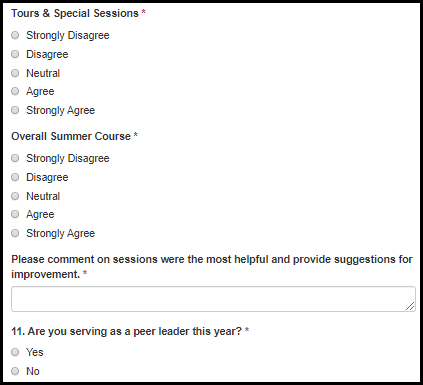
Table 7.2.1.1.f. Introduction Fields
Field Name |
Values |
EIS |
LLS |
FLIGHT |
EEP |
SAF |
PHIFP |
PE |
ELI |
PHAP |
Tours & Special Sessions |
1.
Strongly Disagree |
No |
No |
No |
No |
Yes |
No |
No |
No |
No |
Overall Summer Course |
1.
Strongly Disagree |
No |
No |
No |
No |
Yes |
No |
No |
No |
No |
Please comment on sessions were the most helpful and provide suggestions for improvement. |
- |
No |
No |
No |
No |
Yes |
No |
No |
No |
No |
11. Are you serving as a peer leader this year? |
1.
Yes |
No |
No |
No |
No |
Yes |
No |
No |
No |
No |
Reflection on Fellowship – Fellows
Figure 7.2.1.2.a. Reflection on Fellowship - Fellow Fields
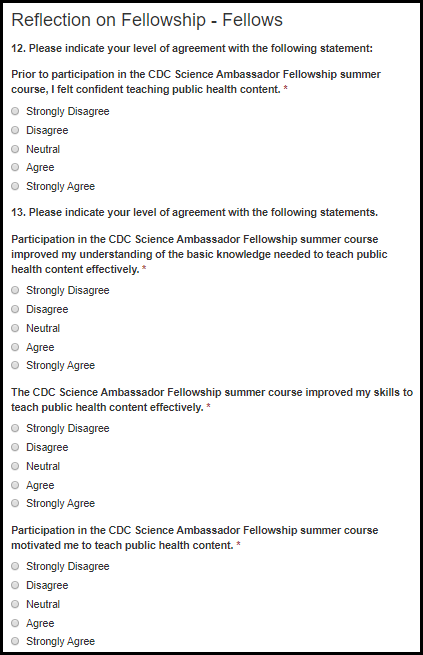
Table 7.2.1.2.a. Reflection on Fellowship - Fellow Fields
Field Name |
Values |
EIS |
LLS |
FLIGHT |
EEP |
SAF |
PHIFP |
PE |
ELI |
PHAP |
Prior to participation in the CDC Science Ambassador Fellowship summer course, I felt confident teaching public health content. |
1.
Strongly Disagree |
No |
No |
No |
No |
Yes |
No |
No |
No |
No |
Participation in the CDC Science Ambassador Fellowship summer course improved my understanding of the basic knowledge needed to teach public health content effectively. |
1.
Strongly Disagree |
No |
No |
No |
No |
Yes |
No |
No |
No |
No |
The CDC Science Ambassador Fellowship summer course improved my skills to teach public health content effectively. |
1.
Strongly Disagree |
No |
No |
No |
No |
Yes |
No |
No |
No |
No |
Participation in the CDC Science Ambassador Fellowship summer course motivated me to teach public health content. |
1.
Strongly Disagree |
No |
No |
No |
No |
Yes |
No |
No |
No |
No |
Figure 7.2.1.2.b. Reflection on Fellowship - Fellow Fields
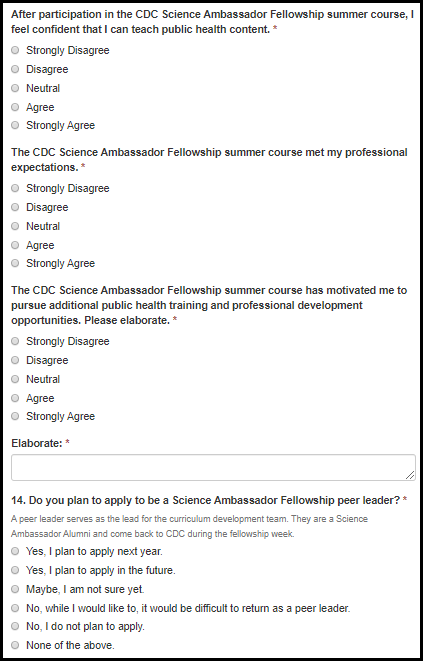
Table 7.2.1.2.b. Reflection on Fellowship - Fellow Fields
Field Name |
Values |
EIS |
LLS |
FLIGHT |
EEP |
SAF |
PHIFP |
PE |
ELI |
PHAP |
After participation in the CDC Science Ambassador Fellowship summer course, I feel confident that I can teach public health content. |
1.
Strongly Disagree |
No |
No |
No |
No |
Yes |
No |
No |
No |
No |
The CDC Science Ambassador Fellowship summer course met my professional expectations. |
1.
Strongly Disagree |
No |
No |
No |
No |
Yes |
No |
No |
No |
No |
The CDC Science Ambassador Fellowship summer course has motivated me to pursue additional public health training and professional development opportunities. Please elaborate. |
1.
Strongly Disagree |
No |
No |
No |
No |
Yes |
No |
No |
No |
No |
Elaborate: |
- |
No |
No |
No |
No |
Yes |
No |
No |
No |
No |
14. Do you plan to apply to be a Science Ambassador Fellowship peer leader? |
1.
Yes, I plan to apply next year. 4.
No, while I would like to, it would be difficult to return as a
peer leader. |
No |
No |
No |
No |
Yes |
No |
No |
No |
No |
Reflection on Fellowship – Peer Leaders
Figure 7.2.1.3.a. Reflection on Fellowship – Peer Leader Fields
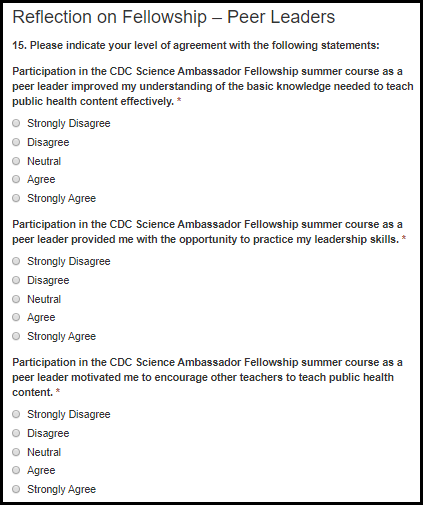
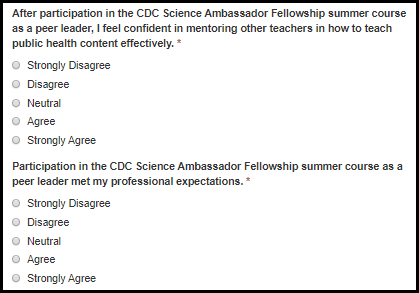
Table 7.2.1.3.a. Reflection on Fellowship – Peer Leader Fields
Field Name |
Values |
EIS |
LLS |
FLIGHT |
EEP |
SAF |
PHIFP |
PE |
ELI |
PHAP |
|
|
|
|
|
|
|
|
|
|
|
Participation in the CDC Science Ambassador Fellowship summer course as a peer leader improved my understanding of the basic knowledge needed to teach public health content effectively. |
1.
Strongly Disagree |
No |
No |
No |
No |
Yes |
No |
No |
No |
No |
Participation in the CDC Science Ambassador Fellowship summer course as a peer leader provided me with the opportunity to practice my leadership skills. |
1.
Strongly Disagree |
No |
No |
No |
No |
Yes |
No |
No |
No |
No |
Participation in the CDC Science Ambassador Fellowship summer course as a peer leader motivated me to encourage other teachers to teach public health content. |
1.
Strongly Disagree |
No |
No |
No |
No |
Yes |
No |
No |
No |
No |
After participation in the CDC Science Ambassador Fellowship summer course as a peer leader, I feel confident in mentoring other teachers in how to teach public health content effectively. |
1.
Strongly Disagree |
No |
No |
No |
No |
Yes |
No |
No |
No |
No |
Participation in the CDC Science Ambassador Fellowship summer course as a peer leader met my professional expectations. |
1.
Strongly Disagree |
No |
No |
No |
No |
Yes |
No |
No |
No |
No |
Figure 7.2.2.1.a. Introduction Fields
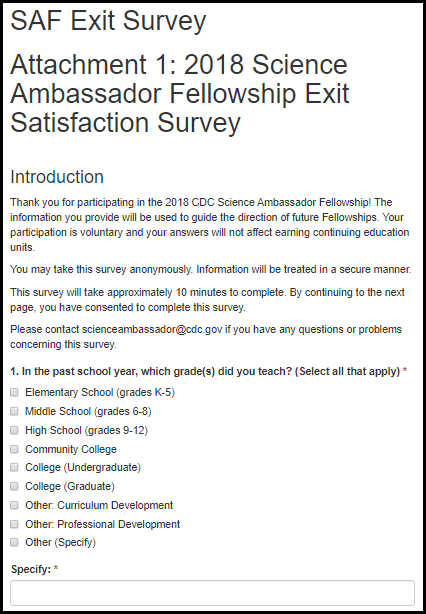
Table 7.2.2.1.a. Introduction Fields
Field Name |
Values |
EIS |
LLS |
FLIGHT |
EEP |
SAF |
PHIFP |
PE |
ELI |
PHAP |
1. In the past school year, which grade(s) did you teach? (Select all that apply) |
1. Elementary School (grades K-5) 2. Middle School (grades 6-8) 3. High School (grades 9-12) 2. Community College 3. College (Undergraduate) 4. College (Graduate) 5. Other: Curriculum Development 6. Other: Professional Development 7. Other (Specify) |
No |
No |
No |
No |
Yes |
No |
No |
No |
No |
Specify: |
- |
No |
No |
No |
No |
Yes |
No |
No |
No |
No |
Figure 7.2.2.1.b. Introduction Fields
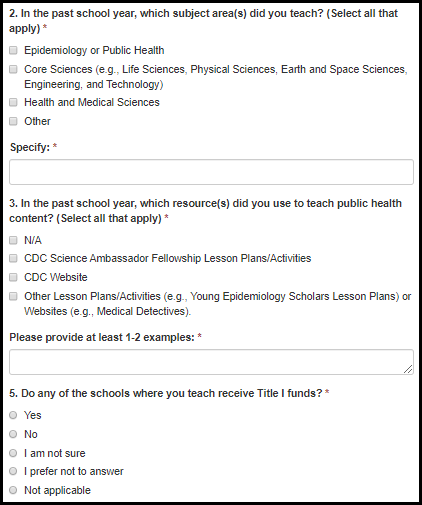
Table 7.2.2.1.b. Introduction Fields
Field Name |
Values |
EIS |
LLS |
FLIGHT |
EEP |
SAF |
PHIFP |
PE |
ELI |
PHAP |
2. In the past school year, which subject area(s) did you teach? (Select all that apply) |
1.
Epidemiology or Public Health |
No |
No |
No |
No |
Yes |
No |
No |
No |
No |
Specify: |
|
No |
No |
No |
No |
Yes |
No |
No |
No |
No |
3. In the past school year, which resource(s) did you use to teach public health content? (Select all that apply) |
1.
N/A |
No |
No |
No |
No |
Yes |
No |
No |
No |
No |
Examples: |
|
No |
No |
No |
No |
Yes |
No |
No |
No |
No |
4. In the upcoming school year, do you plan to teach an entire course related to public health? |
1.
Yes, I plan to in the next year. |
No |
No |
No |
No |
Yes |
No |
No |
No |
No |
5. Do any of the schools where you teach receive Title I funds? |
1.
Yes |
No |
No |
No |
No |
Yes |
No |
No |
No |
No |
Figure 7.2.2.1.c. Introduction Fields

Table 7.2.2.1.c. Introduction Fields
Field Name |
Values |
EIS |
LLS |
FLIGHT |
EEP |
SAF |
PHIFP |
PE |
ELI |
PHAP |
Availability of public health activities and lesson plans |
1.
Not a barrier |
No |
No |
No |
No |
Yes |
No |
No |
No |
No |
Basic knowledge to teach public health content |
1.
Not a barrier |
No |
No |
No |
No |
Yes |
No |
No |
No |
No |
Skills to teach public health content |
1.
Not a barrier |
No |
No |
No |
No |
Yes |
No |
No |
No |
No |
Confidence in teaching public health content |
1.
Not a barrier |
No |
No |
No |
No |
Yes |
No |
No |
No |
No |
School support for teaching public health content |
1.
Not a barrier |
No |
No |
No |
No |
Yes |
No |
No |
No |
No |
Student interest in public health |
1.
Not a barrier |
No |
No |
No |
No |
Yes |
No |
No |
No |
No |
Figure 7.2.2.1.d. Introduction Fields
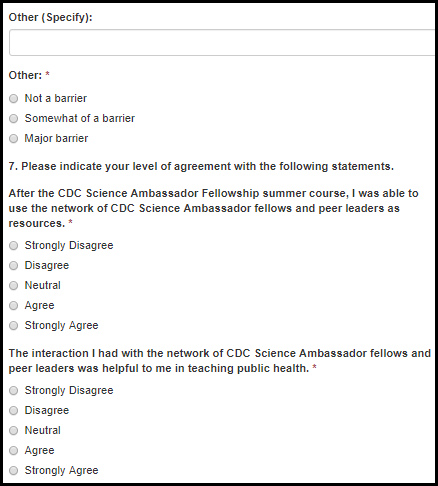
Table 7.2.2.1.d. Introduction Fields
Field Name |
Values |
EIS |
LLS |
FLIGHT |
EEP |
SAF |
PHIFP |
PE |
ELI |
PHAP |
Other (Specify) |
1.
Not a barrier |
No |
No |
No |
No |
Yes |
No |
No |
No |
No |
Specify: |
- |
No |
No |
No |
No |
Yes |
No |
No |
No |
No |
After the CDC Science Ambassador Fellowship summer course, I was able to use the network of CDC Science Ambassador fellows and peer leaders as resources. |
1.
Strongly Disagree |
No |
No |
No |
No |
Yes |
No |
No |
No |
No |
The interaction I had with the network of CDC Science Ambassador fellows and peer leaders was helpful to me in teaching public health. |
1.
Strongly Disagree |
No |
No |
No |
No |
Yes |
No |
No |
No |
No |
Figure 7.2.2.1.e. Introduction Fields

Table 7.2.2.1.e. Introduction Fields
Field Name |
Values |
EIS |
LLS |
FLIGHT |
EEP |
SAF |
PHIFP |
PE |
ELI |
PHAP |
If you teach in a classroom setting, how many students did you teach public health content to as part of your curriculum or elective course in the past school year? |
- |
No |
No |
No |
No |
Yes |
No |
No |
No |
No |
How many teachers did you train in teaching public health content in the past school year? |
- |
No |
No |
No |
No |
Yes |
No |
No |
No |
No |
How many students did you coach through extracurricular clubs or programs at your school related to public health (e.g., Science Olympiad Disease Detectives coach; HOSA supervisor for Public Health or Epidemiology event) in the past school year? |
- |
No |
No |
No |
No |
Yes |
No |
No |
No |
No |
How many instructional hours did you dedicate to teaching public health in the past school year? |
- |
No |
No |
No |
No |
Yes |
No |
No |
No |
No |
How many teachers/colleagues did you share your team’s CDC Science Ambassador Fellowship activity within the past school year? |
- |
No |
No |
No |
No |
Yes |
No |
No |
No |
No |
How many teachers/colleagues have you recommended the CDC Science Ambassador Fellowship to in the past school year? |
- |
No |
No |
No |
No |
Yes |
No |
No |
No |
No |
Figure 7.2.2.1.f. Introduction Fields

Table 7.2.2.1.f. Introduction Fields
Field Name |
Values |
EIS |
LLS |
FLIGHT |
EEP |
SAF |
PHIFP |
PE |
ELI |
PHAP |
Apart from your CDC Science Ambassador Fellowship activity, did you develop any new public health content (e.g., activities, lesson plans, or curricula) in the past school year? |
1.
Yes |
No |
No |
No |
No |
Yes |
No |
No |
No |
No |
In the past school year, did you teach the activity that you developed as part of the Science Ambassador Fellowship summer course? |
1.
Yes |
No |
No |
No |
No |
Yes |
No |
No |
No |
No |
Figure 7.2.2.1.g. Introduction Fields
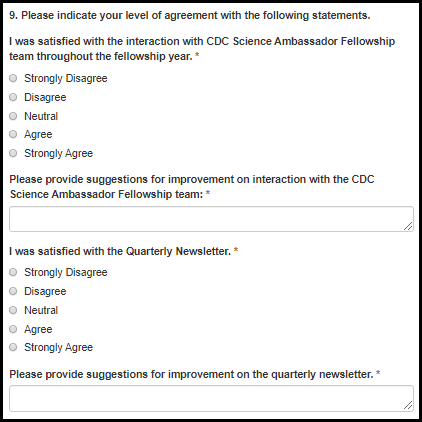
Table 7.2.2.1.g. Introduction Fields
Field Name |
Values |
EIS |
LLS |
FLIGHT |
EEP |
SAF |
PHIFP |
PE |
ELI |
PHAP |
I was satisfied with the interaction with CDC Science Ambassador Fellowship team throughout the fellowship year. |
1.
Strongly Disagree |
No |
No |
No |
No |
Yes |
No |
No |
No |
No |
Please provide suggestions for improvement on interaction with the CDC Science Ambassador Fellowship team. |
- |
No |
No |
No |
No |
Yes |
No |
No |
No |
No |
I was satisfied with the Quarterly Newsletter. |
1.
Strongly Disagree |
No |
No |
No |
No |
Yes |
No |
No |
No |
No |
Please provide suggestions for improvement on the quarterly newsletter. |
|
No |
No |
No |
No |
Yes |
No |
No |
No |
No |
Figure 7.2.2.1.h. Introduction Fields

Table 7.2.2.1.h. Introduction Fields
Field Name |
Values |
EIS |
LLS |
FLIGHT |
EEP |
SAF |
PHIFP |
PE |
ELI |
PHAP |
Which aspects of the CDC Science Ambassador Fellowship were most helpful to you? |
- |
No |
No |
No |
No |
Yes |
No |
No |
No |
No |
What could be improved to make the CDC Science Ambassador Fellowship a more effective learning experience? |
- |
No |
No |
No |
No |
Yes |
No |
No |
No |
No |
11. Did you serve as a peer leader this year? |
1.
Yes |
No |
No |
No |
No |
Yes |
No |
No |
No |
No |
7.2.2.2 Reflections on Fellowship – Fellows
Figure 7.2.2.2.a. Reflections on Fellowship - Fellow Fields
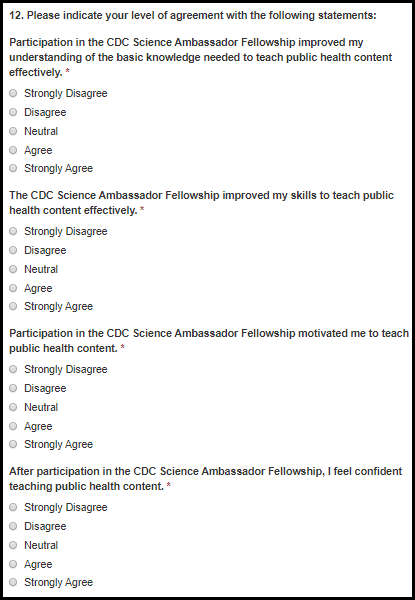
Table 7.2.2.2.a. Reflections on Fellowship - Fellow Fields
Field Name |
Values |
EIS |
LLS |
FLIGHT |
EEP |
SAF |
PHIFP |
PE |
ELI |
PHAP |
Participation in the CDC Science Ambassador Fellowship improved my understanding of the basic knowledge needed to teach public health content effectively. |
1.
Strongly Disagree |
No |
No |
No |
No |
Yes |
No |
No |
No |
No |
The CDC Science Ambassador Fellowship improved my skills to teach public health content effectively. |
1.
Strongly Disagree |
No |
No |
No |
No |
Yes |
No |
No |
No |
No |
Participation in the CDC Science Ambassador Fellowship motivated me to teach public health content. |
1.
Strongly Disagree |
No |
No |
No |
No |
Yes |
No |
No |
No |
No |
After participation in the CDC Science Ambassador Fellowship, I feel confident teaching public health content. |
1.
Strongly Disagree |
No |
No |
No |
No |
Yes |
No |
No |
No |
No |
Figure 7.2.2.2.b. Reflections on Fellowship - Fellow Fields
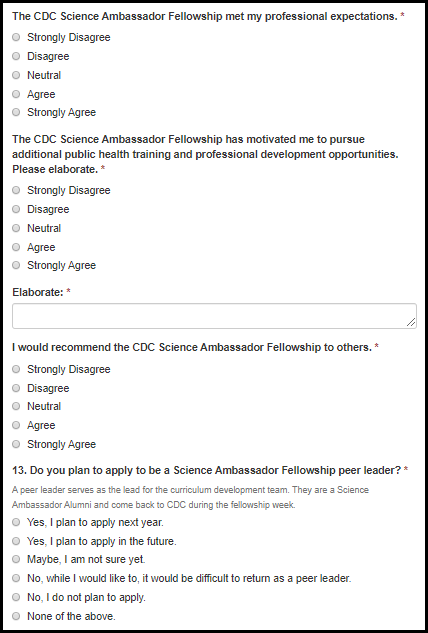
Table 7.2.2.2.b. Reflections on Fellowship - Fellow Fields
Field Name |
Values |
EIS |
LLS |
FLIGHT |
EEP |
SAF |
PHIFP |
PE |
ELI |
PHAP |
The CDC Science Ambassador Fellowship met my professional expectations. |
1.
Strongly Disagree |
No |
No |
No |
No |
Yes |
No |
No |
No |
No |
The CDC Science Ambassador Fellowship has motivated me to pursue additional public health training and professional development opportunities. Please elaborate. |
1.
Strongly Disagree |
No |
No |
No |
No |
Yes |
No |
No |
No |
No |
Elaborate: |
- |
No |
No |
No |
No |
Yes |
No |
No |
No |
No |
I would recommend the CDC Science Ambassador Fellowship to others. |
1.
Strongly Disagree |
No |
No |
No |
No |
Yes |
No |
No |
No |
No |
13. Do you plan to apply to be a Science Ambassador Fellowship peer leader? |
1.
Yes, I plan to apply next year. 3.
Maybe, I am not sure yet. |
No |
No |
No |
No |
Yes |
No |
No |
No |
No |
7.2.2.3 Reflections on Fellowship – Peer Leaders
Figure 7.2.2.3.a. Reflections on Fellowship – Peer Leader Fields

Table 7.2.2.3.a. Reflections on Fellowship – Peer Leader Fields
Field Name |
Values |
EIS |
LLS |
FLIGHT |
EEP |
SAF |
PHIFP |
PE |
ELI |
PHAP |
14. In what year did you first participate in the Science Ambassador Fellowship or Science Ambassador Workshop? |
- |
No |
No |
No |
No |
Yes |
No |
No |
No |
No |
Participation in the CDC Science Ambassador Fellowship as a peer leader improved my understanding of the basic knowledge needed to teach public health effectively. |
1.
Strongly Disagree |
No |
No |
No |
No |
Yes |
No |
No |
No |
No |
Participation in the CDC Science Ambassador Fellowship as a peer leader provided me with the opportunity to practice my leadership skills. |
1.
Strongly Disagree |
No |
No |
No |
No |
Yes |
No |
No |
No |
No |
Participation in the CDC Science Ambassador Fellowship as a peer leader motivated me to encourage other teachers to teach public health. |
1.
Strongly Disagree |
No |
No |
No |
No |
Yes |
No |
No |
No |
No |
Figure 7.2.2.3.b. Reflections on Fellowship – Peer Leader Fields
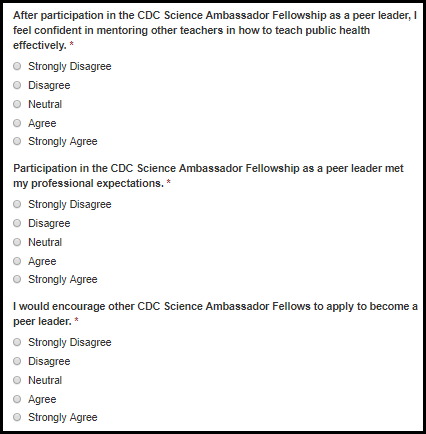
Table 7.2.2.3.b. Reflections on Fellowship – Peer Leader Fields
Field Name |
Values |
EIS |
LLS |
FLIGHT |
EEP |
SAF |
PHIFP |
PE |
ELI |
PHAP |
After participation in the CDC Science Ambassador Fellowship as a peer leader, I feel confident in mentoring other teachers in how to teach public health effectively. |
1.
Strongly Disagree |
No |
No |
No |
No |
Yes |
No |
No |
No |
No |
Participation in the CDC Science Ambassador Fellowship as a peer leader met my professional expectations. |
1.
Strongly Disagree |
No |
No |
No |
No |
Yes |
No |
No |
No |
No |
I would encourage other CDC Science Ambassador Fellows to apply to become a peer leader. |
1.
Strongly Disagree |
No |
No |
No |
No |
Yes |
No |
No |
No |
No |
Figure 7.3.1.1.a. Introduction Fields
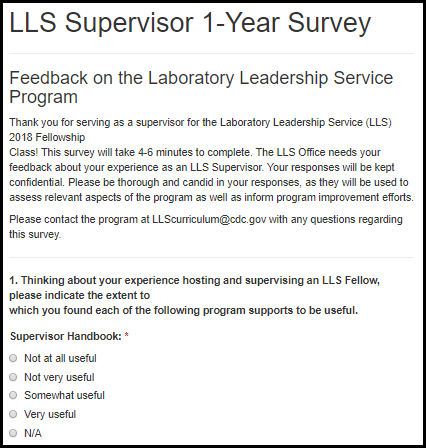
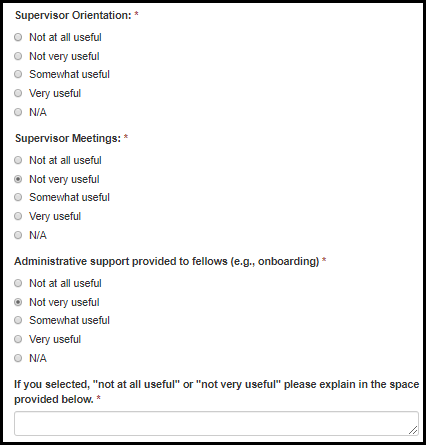
Table 7.3.1.1.a. Introduction Fields
Field Name |
Values |
EIS |
LLS |
FLIGHT |
EEP |
SAF |
PHIFP |
PE |
ELI |
PHAP |
Supervisor Handbook |
1.
Not at all useful |
No |
Yes |
No |
No |
No |
No |
No |
No |
No |
Supervisor Orientation |
1.
Not at all useful |
No |
Yes |
No |
No |
No |
No |
No |
No |
No |
Supervisor Meetings |
1.
Not at all useful |
No |
Yes |
No |
No |
No |
No |
No |
No |
No |
Administrative support provided to fellows (e.g., onboarding) |
1.
Not at all useful |
No |
Yes |
No |
No |
No |
No |
No |
No |
No |
If you selected, "not at all useful" or "not very useful" please explain in the space provided below. |
|
No |
Yes |
No |
No |
No |
No |
No |
No |
No |
Figure 7.3.1.1.b. Introduction Fields

Table 7.3.1.1.b. Introduction Fields
Field Name |
Values |
EIS |
LLS |
FLIGHT |
EEP |
SAF |
PHIFP |
PE |
ELI |
PHAP |
Selecting an LLS Fellow |
1.
Less Support |
No |
Yes |
No |
No |
No |
No |
No |
No |
No |
Ensuring the LLS Fellow completes CALs (Core Activities of Learning) |
1.
Less Support |
No |
Yes |
No |
No |
No |
No |
No |
No |
No |
Assistance with planning projects for LLS Fellow |
1.
Less Support |
No |
Yes |
No |
No |
No |
No |
No |
No |
No |
If you selected, "less support" or "more support" please specify in the space provided below. |
- |
No |
Yes |
No |
No |
No |
No |
No |
No |
No |
3. Reflecting back on your experience as a supervisor for the past year, please identify any support services that you did not receive from the LLS program that would have been beneficial or that you wish you had. |
- |
No |
Yes |
No |
No |
No |
No |
No |
No |
No |
Figure 7.3.1.1.c. Introduction Fields
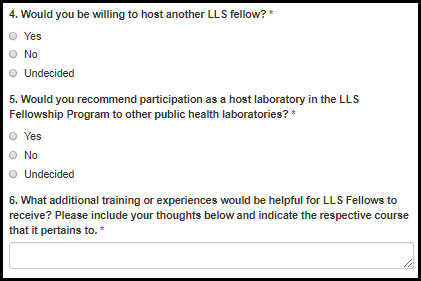
Table 7.3.1.1.c. Introduction Fields
Field Name |
Values |
EIS |
LLS |
FLIGHT |
EEP |
SAF |
PHIFP |
PE |
ELI |
PHAP |
4. Would you be willing to host another LLS fellow? |
1.
No |
No |
Yes |
No |
No |
No |
No |
No |
No |
No |
If you selected, "no" or "undecided" please explain. |
- |
No |
Yes |
No |
No |
No |
No |
No |
No |
No |
5. Would you recommend participation as a host laboratory in the LLS Fellowship Program to other public health laboratories? |
1.
No |
No |
Yes |
No |
No |
No |
No |
No |
No |
No |
If you selected, "no" or "undecided" please explain. |
- |
No |
Yes |
No |
No |
No |
No |
No |
No |
No |
6. What additional training or experiences would be helpful for LLS Fellows to receive? Please include your thoughts below and indicate the respective course that it pertains to. |
|
No |
Yes |
No |
No |
No |
No |
No |
No |
No |
Communication
Figure 7.3.1.2.a. Communication Fields
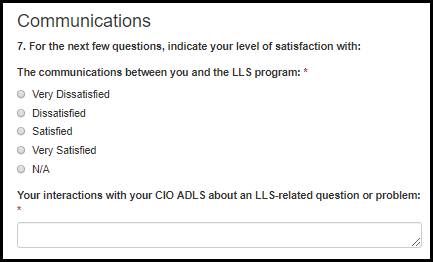
Table 7.3.1.2.a. Communication Fields
Field Name |
Values |
EIS |
LLS |
FLIGHT |
EEP |
SAF |
PHIFP |
PE |
ELI |
PHAP |
The communications between you and the LLS program. |
1.
Very Dissatisfied |
No |
Yes |
No |
No |
No |
No |
No |
No |
No |
Your interactions with your CIO ADLS about an LLS-related question or problem. |
- |
No |
Yes |
No |
No |
No |
No |
No |
No |
No |
Feedback on Hosting an LLS Fellow
Figure 7.3.1.3.a. Feedback on Hosting an LLS Fellow Fields
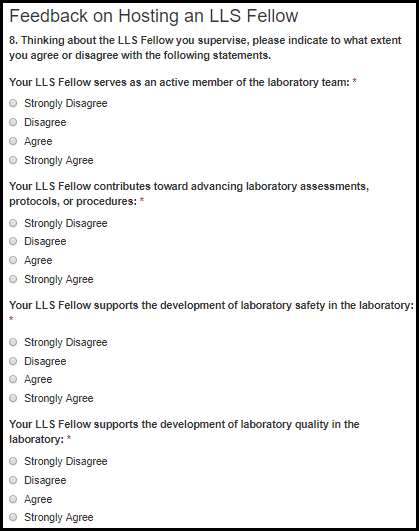
Table 7.3.1.3.a. Feedback on Hosting an LLS Fellow Fields
Field Name |
Values |
EIS |
LLS |
FLIGHT |
EEP |
SAF |
PHIFP |
PE |
ELI |
PHAP |
Your LLS Fellow serves as an active member of the laboratory team. |
1.
Strongly Disagree |
No |
Yes |
No |
No |
No |
No |
No |
No |
No |
Your LLS Fellow contributes toward advancing laboratory assessments, protocols, or procedures. |
1.
Strongly Disagree |
No |
Yes |
No |
No |
No |
No |
No |
No |
No |
Your LLS Fellow supports the development of laboratory safety in the laboratory. |
1.
Strongly Disagree |
No |
Yes |
No |
No |
No |
No |
No |
No |
No |
Your LLS Fellow supports the development of laboratory quality in the laboratory. |
1.
Strongly Disagree |
No |
Yes |
No |
No |
No |
No |
No |
No |
No |
Figure 7.3.1.3.b. Feedback on Hosting an LLS Fellow Fields
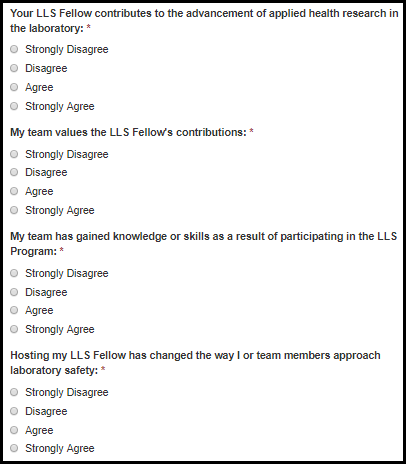
Table 7.3.1.3.b. Feedback on Hosting an LLS Fellow Fields
Field Name |
Values |
EIS |
LLS |
FLIGHT |
EEP |
SAF |
PHIFP |
PE |
ELI |
PHAP |
Your LLS Fellow contributes to the advancement of applied health research in the laboratory. |
1.
Strongly Disagree |
No |
Yes |
No |
No |
No |
No |
No |
No |
No |
My team values the LLS Fellow's contributions. |
1.
Strongly Disagree |
No |
Yes |
No |
No |
No |
No |
No |
No |
No |
My team has gained knowledge or skills as a result of participating in the LLS Program. |
1.
Strongly Disagree |
No |
Yes |
No |
No |
No |
No |
No |
No |
No |
Hosting my LLS Fellow has changed the way I or team members approach laboratory safety. |
1.
Strongly Disagree |
No |
Yes |
No |
No |
No |
No |
No |
No |
No |
Figure 7.3.1.3.c. Feedback on Hosting an LLS Fellow Fields
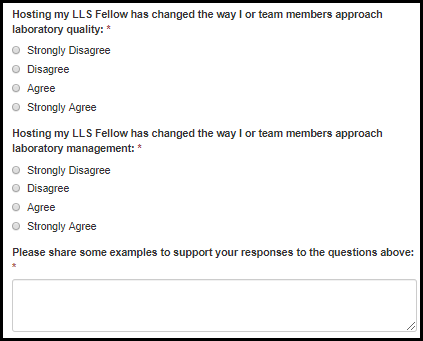
Table 7.3.1.3.c. Feedback on Hosting an LLS Fellow Fields
Field Name |
Values |
EIS |
LLS |
FLIGHT |
EEP |
SAF |
PHIFP |
PE |
ELI |
PHAP |
Hosting my LLS Fellow has changed the way I or team members approach laboratory quality. |
1.
Strongly Disagree |
No |
Yes |
No |
No |
No |
No |
No |
No |
No |
Hosting my LLS Fellow has changed the way I or team members approach laboratory management. |
1.
Strongly Disagree |
No |
Yes |
No |
No |
No |
No |
No |
No |
No |
Please share some examples to support your responses to the questions above. |
- |
No |
Yes |
No |
No |
No |
No |
No |
No |
No |
Figure 7.3.2.1.a. Introduction Fields
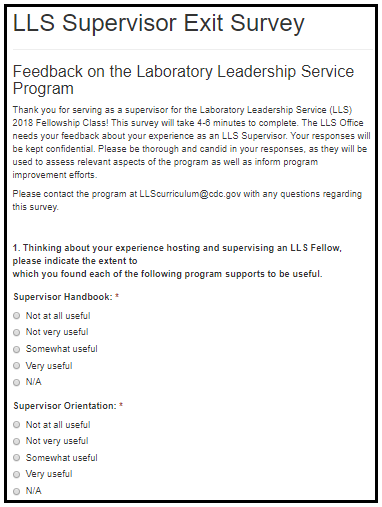
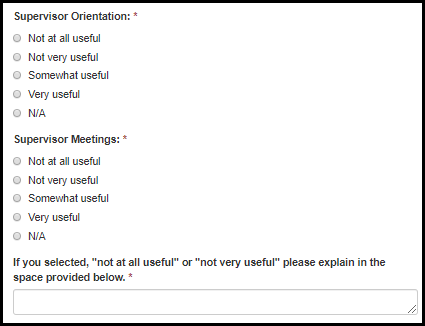
Table 7.3.2.1.a. Introduction Fields
Field Name |
Values |
EIS |
LLS |
FLIGHT |
EEP |
SAF |
PHIFP |
PE |
ELI |
PHAP |
Supervisor Handbook |
1.
Not at all useful |
No |
Yes |
No |
No |
No |
No |
No |
No |
No |
Supervisor Orientation |
1.
Not at all useful |
No |
Yes |
No |
No |
No |
No |
No |
No |
No |
Supervisor Meetings |
1.
Not at all useful |
No |
Yes |
No |
No |
No |
No |
No |
No |
No |
If you selected, "not at all useful" or "not very useful" please explain in the space provided below. |
- |
No |
Yes |
No |
No |
No |
No |
No |
No |
No |
Figure 7.3.2.1.b. Introduction Fields

Table 7.3.2.1.b. Introduction Fields
Field Name |
Values |
EIS |
LLS |
FLIGHT |
EEP |
SAF |
PHIFP |
PE |
ELI |
PHAP |
Selecting an LLS Fellow |
1.
Less Support |
No |
Yes |
No |
No |
No |
No |
No |
No |
No |
Ensuring the LLS Fellow completes CALs (Core Activities of Learning) |
1.
Less Support |
No |
Yes |
No |
No |
No |
No |
No |
No |
No |
Assistance with planning projects for LLS Fellow |
1.
Less Support |
No |
Yes |
No |
No |
No |
No |
No |
No |
No |
If you selected, "less support" or "more support" please specify in the space provided below. |
- |
No |
Yes |
No |
No |
No |
No |
No |
No |
No |
Figure 7.3.2.1.c. Introduction Fields

Figure 7.3.2.1.c. Introduction Fields
Field Name |
Values |
EIS |
LLS |
FLIGHT |
EEP |
SAF |
PHIFP |
PE |
ELI |
PHAP |
3. Reflecting back on your experience as a supervisor for the past two years, please identify any support services that you did not receive from the LLS program that would have been beneficial or that you'd wished you had. |
- |
No |
Yes |
No |
No |
No |
No |
No |
No |
No |
Are there any CALs that you would recommend removing from the list? |
1.
Yes |
No |
Yes |
No |
No |
No |
No |
No |
No |
No |
If you selected, "yes" to either question, please explain. |
- |
No |
Yes |
No |
No |
No |
No |
No |
No |
No |
Figure 7.3.2.1.d. Introduction Fields
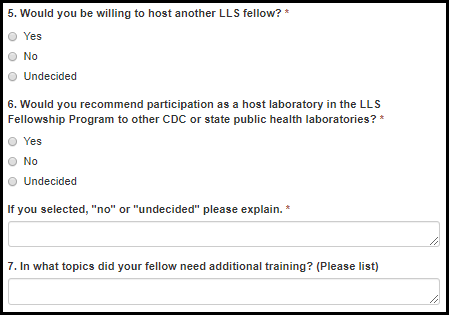
Table 7.3.2.1.d. Introduction Fields
Field Name |
Values |
EIS |
LLS |
FLIGHT |
EEP |
SAF |
PHIFP |
PE |
ELI |
PHAP |
5. Would you be willing to host another LLS fellow? |
1.
Yes |
No |
Yes |
No |
No |
No |
No |
No |
No |
No |
If you selected, "no" or "undecided" please explain. |
- |
No |
Yes |
No |
No |
No |
No |
No |
No |
No |
6. Would you recommend participation as a host laboratory in the LLS Fellowship Program to other CDC or state public health laboratories? |
1.
Yes |
No |
Yes |
No |
No |
No |
No |
No |
No |
No |
If you selected, "no" or "undecided" please explain. |
- |
No |
Yes |
No |
No |
No |
No |
No |
No |
No |
7. In what topics did your fellow need additional training? (Please list) |
- |
No |
Yes |
No |
No |
No |
No |
No |
No |
No |
Communications
Figure 7.3.2.1.a. Communications Fields

Table 7.3.2.1.a. Communications Fields
Field Name |
Values |
EIS |
LLS |
FLIGHT |
EEP |
SAF |
PHIFP |
PE |
ELI |
PHAP |
The communication between you and the LLS program. |
1.
Very Dissatisfied |
No |
Yes |
No |
No |
No |
No |
No |
No |
No |
Your interactions with your CIO ADLS about an LLS-related question or problem. |
1.
Very Dissatisfied |
No |
Yes |
No |
No |
No |
No |
No |
No |
No |
9.
Please share any suggestions that you have to help LLS Fellows
obtain public health laboratory |
- |
No |
Yes |
No |
No |
No |
No |
No |
No |
No |
Feedback on Hosting an LLS Fellow
Figure 7.3.2.3.a. Feedback on Hosting an LLS Fellow Fields

Table 7.3.2.3.a. Feedback on Hosting an LLS Fellow Fields
Field Name |
Values |
EIS |
LLS |
FLIGHT |
EEP |
SAF |
PHIFP |
PE |
ELI |
PHAP |
10. Would you like to provide feedback regarding LLS Fellow accomplishments? If you do not have any feedback please write, N/A. |
- |
No |
Yes |
No |
No |
No |
No |
No |
No |
No |
Your LLS Fellow serves as an active member of the laboratory team. |
1.
Strongly Disagree |
No |
Yes |
No |
No |
No |
No |
No |
No |
No |
Your LLS Fellow contributes toward advancing laboratory assessments, protocols, or procedures. |
1.
Strongly Disagree |
No |
Yes |
No |
No |
No |
No |
No |
No |
No |
Your LLS Fellow supports the development of laboratory safety in the laboratory. |
1.
Strongly Disagree |
No |
Yes |
No |
No |
No |
No |
No |
No |
No |
Figure 7.3.2.3.b. Feedback on Hosting an LLS Fellow Fields
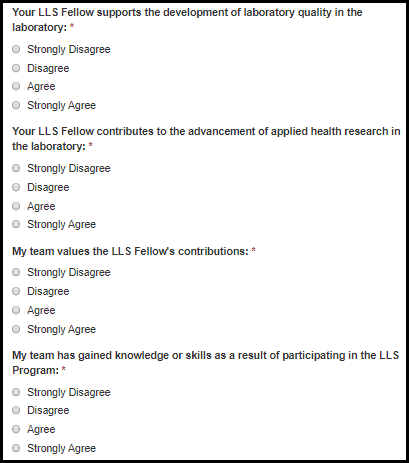

Table 7.3.2.3.b. Feedback on Hosting an LLS Fellow Fields
Field Name |
Values |
EIS |
LLS |
FLIGHT |
EEP |
SAF |
PHIFP |
PE |
ELI |
PHAP |
Your LLS Fellow supports the development of laboratory quality in the laboratory. |
1.
Strongly Disagree |
No |
Yes |
No |
No |
No |
No |
No |
No |
No |
Your LLS Fellow contributes to the advancement of applied health research in the laboratory. |
1.
Strongly Disagree |
No |
Yes |
No |
No |
No |
No |
No |
No |
No |
My team values the LLS Fellow's contributions. |
1.
Strongly Disagree |
No |
Yes |
No |
No |
No |
No |
No |
No |
No |
My team has gained knowledge or skills as a result of participating in the LLS Program. |
1.
Strongly Disagree |
No |
Yes |
No |
No |
No |
No |
No |
No |
No |
Hosting my LLS Fellow has changed the way I or team members approach laboratory safety. |
1.
Strongly Disagree |
No |
Yes |
No |
No |
No |
No |
No |
No |
No |
Hosting my LLS Fellow has changed the way I or team members approach laboratory quality. |
1.
Strongly Disagree |
No |
Yes |
No |
No |
No |
No |
No |
No |
No |
Hosting my LLS Fellow has changed the way I or team members approach laboratory management. |
1.
Strongly Disagree |
No |
Yes |
No |
No |
No |
No |
No |
No |
No |
Please share some examples to support your responses to the question above.
|
- |
No |
Yes |
No |
No |
No |
No |
No |
No |
No |
I had a good working relationship with my fellow. |
1.
Strongly Disagree |
No |
Yes |
No |
No |
No |
No |
No |
No |
No |
What were the most challenging parts of hosting an LLSF? |
- |
No |
Yes |
No |
No |
No |
No |
No |
No |
No |
Please describe how you approached supervising your LLSF (i.e., how do you interact with your officer, what is your management style)? |
- |
No |
Yes |
No |
No |
No |
No |
No |
No |
No |
Figure 7.4.1.1.a Introduction Fields

Increases in Knowledge, Skill, Self-Efficacy
Figure 7.4.1.2.a Increases in Knowledge, Skill, Self-Efficacy Fields
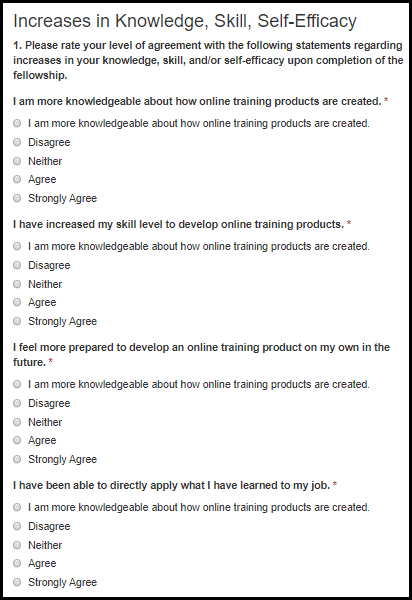
Table 7.4.1.2.a Increases in Knowledge, Skill, Self-Efficacy Fields
Field Name |
Values |
EIS |
LLS |
FLIGHT |
EEP |
SAF |
PHIFP |
PE |
ELI |
PHAP |
I am more knowledgeable about how online training products are created. |
1.
Strongly Disagree |
No |
No |
No |
No |
No |
No |
No |
Yes |
No |
I have increased my skill level to develop online training products. |
1.
Strongly Disagree |
No |
No |
No |
No |
No |
No |
No |
Yes |
No |
I feel more prepared to develop an online training product on my own in the future. |
1.
Strongly Disagree |
No |
No |
No |
No |
No |
No |
No |
Yes |
No |
I have been able to directly apply what I have learned to my job. |
1.
Strongly Disagree |
No |
No |
No |
No |
No |
No |
No |
Yes |
No |
Instructional Design Competencies
Figure 7.4.1.3.a Instructional Design Competencies Fields
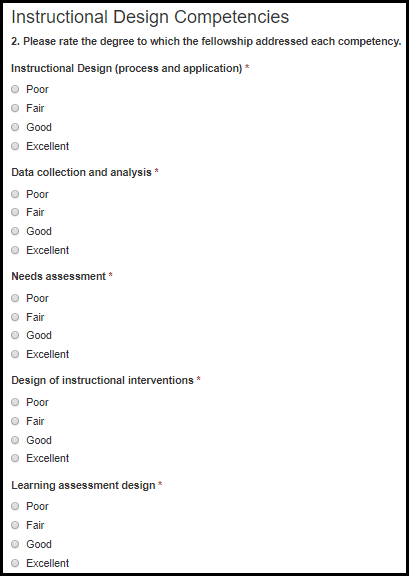

Table 7.4.1.3.a Instructional Design Competencies Fields
Field Name |
Values |
EIS |
LLS |
FLIGHT |
EEP |
SAF |
PHIFP |
PE |
ELI |
PHAP |
Instructional Design (process and application) |
1.
Poor |
No |
No |
No |
No |
No |
No |
No |
Yes |
No |
Data collection and analysis |
1.
Poor |
No |
No |
No |
No |
No |
No |
No |
Yes |
No |
Needs assessment |
1.
Poor |
No |
No |
No |
No |
No |
No |
No |
Yes |
No |
Design of instructional interventions |
1.
Poor |
No |
No |
No |
No |
No |
No |
No |
Yes |
No |
Learning assessment design |
1.
Poor |
No |
No |
No |
No |
No |
No |
No |
Yes |
No |
Formative evaluation |
1.
Poor |
No |
No |
No |
No |
No |
No |
No |
Yes |
No |
Summative evaluation |
1.
Poor |
No |
No |
No |
No |
No |
No |
No |
Yes |
No |
Project management |
1.
Poor |
No |
No |
No |
No |
No |
No |
No |
Yes |
No |
Capacity Increases Attributed to Fellowship
Figure 7.4.1.4.a. Capacity Increases Attributed to Fellowship Fields

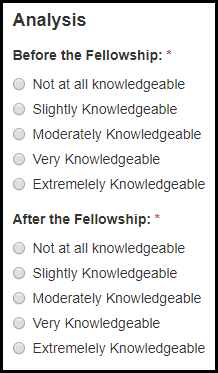

Figure 7.4.1.4.b Capacity Increases Attributed to Fellowship Fields

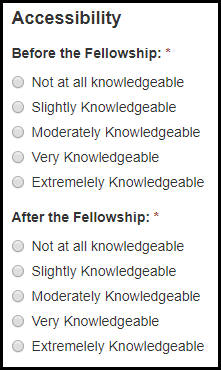

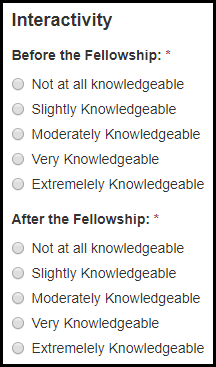
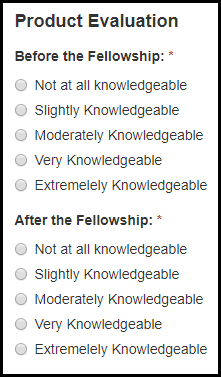
Table 7.4.1.4.a. Capacity Increases Attributed to Fellowship Fields
Field Name |
Values |
EIS |
LLS |
FLIGHT |
EEP |
SAF |
PHIFP |
PE |
ELI |
PHAP |
Before the Fellowship: |
1.
Not at all knowledgeable |
No |
No |
No |
No |
No |
No |
No |
Yes |
No |
After the Fellowship: |
1.
Not at all knowledgeable |
No |
No |
No |
No |
No |
No |
No |
Yes |
No |
Post-Fellowship Implementation
Figure 7.4.1.5.a Post-Fellowship Implementation Fields
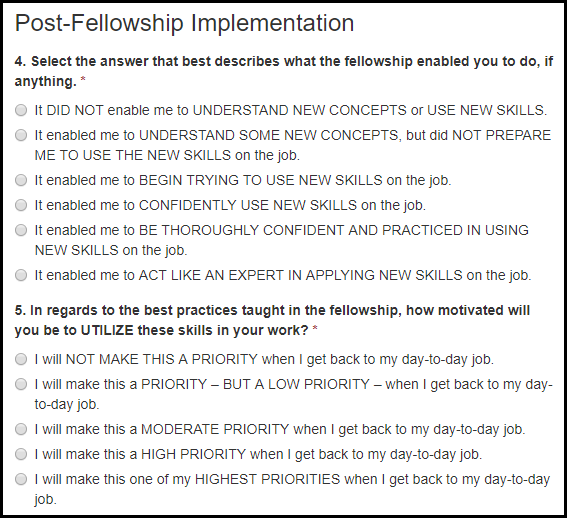
Table 7.4.1.5.a Post-Fellowship Implementation Fields
Field Name |
Values |
EIS |
LLS |
FLIGHT |
EEP |
SAF |
PHIFP |
PE |
ELI |
PHAP |
4. Select the answer that best describes what the fellowship enabled you to do, if anything. |
1.
It DID NOT enable me to UNDERSTAND NEW CONCEPTS or USE NEW
SKILLS. |
No |
No |
No |
No |
No |
No |
No |
Yes |
No |
5. In regards to the best practices taught in the fellowship, how motivated will you be to UTILIZE these skills in your work? |
1.
I will NOT MAKE THIS A PRIORITY when I get back to my day-to-day
job. |
No |
No |
No |
No |
No |
No |
No |
Yes |
No |
Overall
Figure 7.4.1.6.a Overall Fields

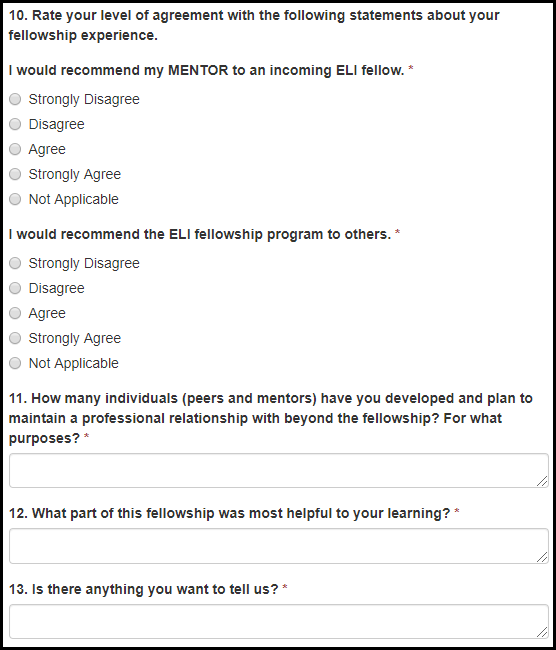
Table 7.4.1.6.a Overall Fields
Field Name |
Values |
EIS |
LLS |
FLIGHT |
EEP |
SAF |
PHIFP |
PE |
ELI |
PHAP |
6. How relevant is this fellowship to your current work? |
1.
Not at all relevant |
No |
No |
No |
No |
No |
No |
No |
Yes |
No |
7. What is your opinion of the balance of written material, webinars, and interactivity in this fellowship? |
1.
Too much written materials and webinars, and not enough
interactive learning |
No |
No |
No |
No |
No |
No |
No |
Yes |
No |
8. How much of what you learned during the fellowship do you expect to use in your position? |
1.
None |
No |
No |
No |
No |
No |
No |
No |
Yes |
No |
Table 7.4.1.6.b Overall Fields
Field Name |
Values |
EIS |
LLS |
FLIGHT |
EEP |
SAF |
PHIFP |
PE |
ELI |
PHAP |
I would recommend my MENTOR to an incoming ELI fellow. |
1.
Strongly Disagree |
No |
No |
No |
No |
No |
No |
No |
Yes |
No |
I would recommend the ELI fellowship program to others. |
1.
Strongly Disagree |
No |
No |
No |
No |
No |
No |
No |
Yes |
No |
11. How many individuals (peers and mentors) have you developed and plan to maintain a professional relationship with beyond the fellowship? For what purposes? |
- |
No |
No |
No |
No |
No |
No |
No |
Yes |
No |
12. What part of this fellowship was most helpful to your learning? |
- |
No |
No |
No |
No |
No |
No |
No |
Yes |
No |
13. Is there anything you want to tell us? |
- |
No |
No |
No |
No |
No |
No |
No |
Yes |
No |
Figure 7.5.1.1.a Feedback on General EIS Program Support Fields
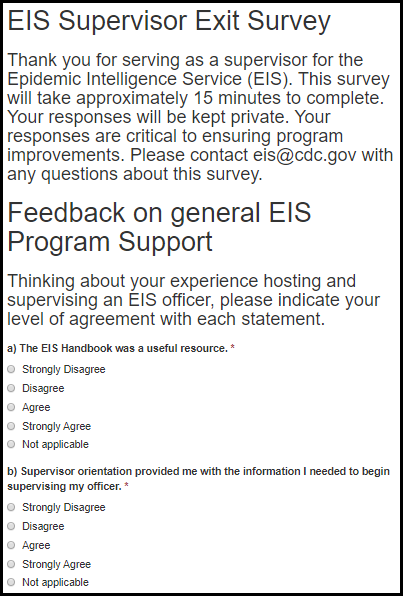
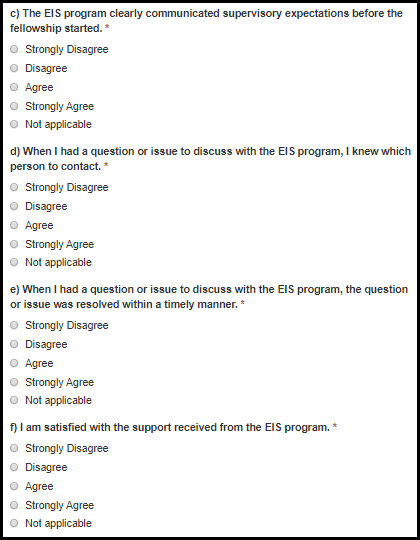
Figure 7.5.1.1.b Feedback on General EIS Program Support Fields
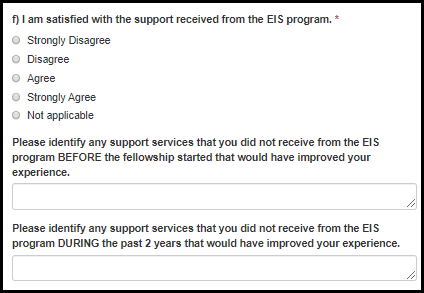
Table 7.5.1.1.a Feedback on General EIS Program Support Fields
Field Name |
Values |
EIS |
LLS |
FLIGHT |
EEP |
SAF |
PHIFP |
PE |
ELI |
PHAP |
a) The EIS Handbook was a useful resource. |
1.
Strongly Disagree |
Yes |
No |
No |
No |
No |
No |
No |
No |
No |
b) Supervisor orientation provided me with the information I needed to begin supervising my officer. |
1.
Strongly Disagree |
Yes |
No |
No |
No |
No |
No |
No |
No |
No |
c) The EIS program clearly communicated supervisory expectations before the fellowship started. |
1.
Strongly Disagree |
Yes |
No |
No |
No |
No |
No |
No |
No |
No |
d) When I had a question or issue to discuss with the EIS program, I knew which person to contact. |
1.
Strongly Disagree |
Yes |
No |
No |
No |
No |
No |
No |
No |
No |
e) When I had a question or issue to discuss with the EIS program, the question or issue was resolved within a timely manner. |
1.
Strongly Disagree |
Yes |
No |
No |
No |
No |
No |
No |
No |
No |
Table 7.5.1.1.b Feedback on General EIS Program Support Fields
Field Name |
Values |
EIS |
LLS |
FLIGHT |
EEP |
SAF |
PHIFP |
PE |
ELI |
PHAP |
f) I am satisfied with the support received from the EIS program. |
1.
Strongly Disagree |
Yes |
No |
No |
No |
No |
No |
No |
No |
No |
If you selected “strongly disagree” or “disagree,” please explain in the space provided below. |
- |
Yes |
No |
No |
No |
No |
No |
No |
No |
No |
Please identify any support services that you did not receive from the EIS program before the fellowship started that would have improved your experience. |
-
|
Yes |
No |
No |
No |
No |
No |
No |
No |
No |
Please identify any support services that you did not receive from the EIS program during the past 2 years that would have improved your experience. |
- |
Yes |
No |
No |
No |
No |
No |
No |
No |
No |
Feedback on Supervisor Training
Figure 7.5.1.2.a Feedback on Supervisor Training Fields
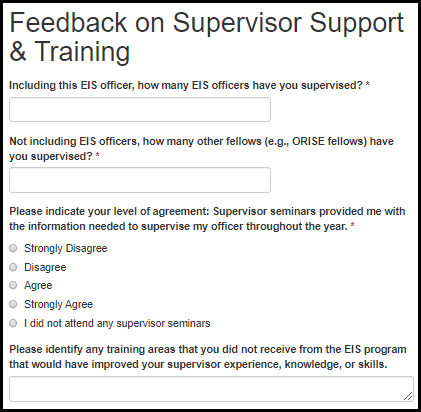
Table 7.5.1.2.a Feedback on Supervisor Training Fields
Field Name |
Values |
EIS |
LLS |
FLIGHT |
EEP |
SAF |
PHIFP |
PE |
ELI |
PHAP |
Including this EIS officer, how many EIS officers have you supervised? |
- |
Yes |
No |
No |
No |
No |
No |
No |
No |
No |
Not including EIS officers, how many other fellows (e.g., ORISE fellows) have you supervised? |
- |
Yes |
No |
No |
No |
No |
No |
No |
No |
No |
Please indicate your level of agreement: Supervisor seminars provided me with the information needed to supervise my officer throughout the year. |
1.
Strongly Disagree |
Yes |
No |
No |
No |
No |
No |
No |
No |
No |
If you selected “strongly disagree,” “disagree,” or “I did not attend any supervisor seminars,” please explain in the space provided below. |
- |
Yes |
No |
No |
No |
No |
No |
No |
No |
No |
Please identify any training areas that you did not receive from the EIS program that would have improved your supervisor experience, knowledge, or skills. |
- |
Yes |
No |
No |
No |
No |
No |
No |
No |
No |
Feedback on EIS Officer
Figure 7.5.1.3.a Feedback on EIS Officer Fields
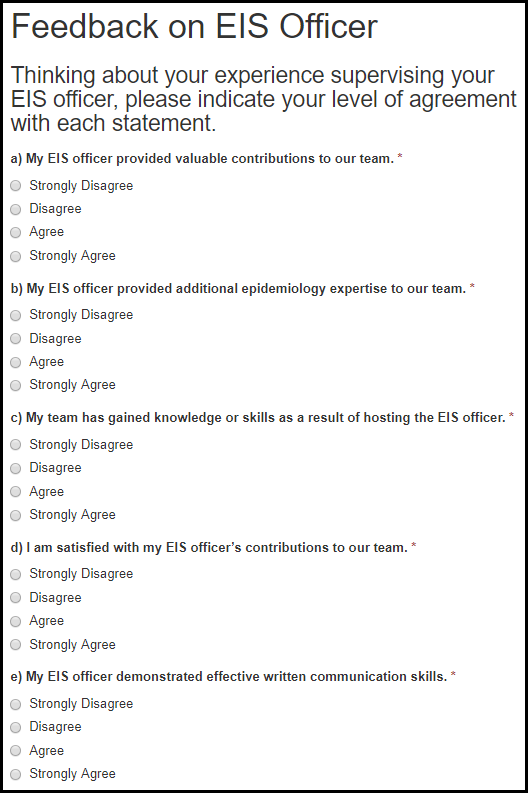

Figure 7.5.1.3.b Feedback on EIS Officer Fields
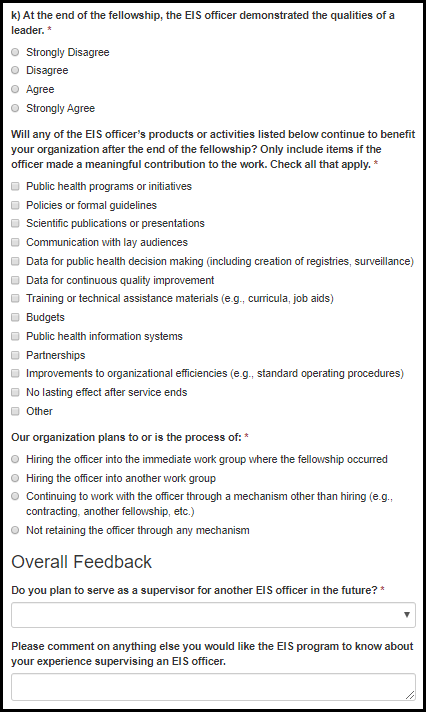
Table 7.5.1.3.a Feedback on EIS Officer Fields
Field Name |
Values |
EIS |
LLS |
FLIGHT |
EEP |
SAF |
PHIFP |
PE |
ELI |
PHAP |
a) The EIS officer provided valuable contributions to the host site. |
1.
Strongly Disagree |
Yes |
No |
No |
No |
No |
No |
No |
No |
No |
b) The EIS officer provided additional epidemiology expertise to the host site. |
1.
Strongly Disagree |
Yes |
No |
No |
No |
No |
No |
No |
No |
No |
c) The host site has gained knowledge or skills as a result of hosting the EIS officer. |
1.
Strongly Disagree |
Yes |
No |
No |
No |
No |
No |
No |
No |
No |
d) I had a good working relationship with my officer. |
1.
Strongly Disagree |
Yes |
No |
No |
No |
No |
No |
No |
No |
No |
e) At the end of the fellowship, the EIS officer demonstrated effective written communication skills. |
1.
Strongly Disagree |
Yes |
No |
No |
No |
No |
No |
No |
No |
No |
f) At the end of the fellowship, the EIS officer demonstrated effective oral communication skills. |
1.
Strongly Disagree |
Yes |
No |
No |
No |
No |
No |
No |
No |
No |
g) At the end of the fellowship, the EIS officer had a desire to learn and improve. |
1.
Strongly Disagree |
Yes |
No |
No |
No |
No |
No |
No |
No |
No |
Figure 7.5.1.3.b Feedback on EIS Officer Fields
Field Name |
Values |
EIS |
LLS |
FLIGHT |
EEP |
SAF |
PHIFP |
PE |
ELI |
PHAP |
h) At the end of the fellowship, the EIS officer was able to quickly adapt to changing needs and priorities. |
1.
Strongly Disagree |
Yes |
No |
No |
No |
No |
No |
No |
No |
No |
i) At the end of the fellowship, the EIS officer was effective at solving problems. |
1.
Strongly Disagree |
Yes |
No |
No |
No |
No |
No |
No |
No |
No |
j) At the end of the fellowship, the EIS officer was able to resolve conflicts effectively. |
1.
Strongly Disagree |
Yes |
No |
No |
No |
No |
No |
No |
No |
No |
k) At the end of the fellowship, the EIS officer demonstrated the qualities of a leader. |
1.
Strongly Disagree |
Yes |
No |
No |
No |
No |
No |
No |
No |
No |
If you selected “strongly disagree” or “disagree,” please explain in the space provided below. |
- |
Yes |
No |
No |
No |
No |
No |
No |
No |
No |
Figure 7.5.1.3.c Feedback on EIS Officer Fields
Field Name |
Values |
EIS |
LLS |
FLIGHT |
EEP |
SAF |
PHIFP |
PE |
ELI |
PHAP |
15. Will any of the EIS officer’s products or activities listed below continue to benefit your organization after the end of the fellowship? Only include items if the officer made a meaningful contribution to the work. (Check all that apply) |
1.
Public health programs or initiatives |
Yes |
No |
No |
No |
No |
No |
No |
No |
No |
Specify: |
|
Yes |
No |
No |
No |
No |
No |
No |
No |
No |
16. Our organization plans to or is the process of: |
1.
Hiring the officer into the immediate work group where the
fellowship occurred |
Yes |
No |
No |
No |
No |
No |
No |
No |
No |
Figure 7.5.1.3.d Feedback on EIS Officer Fields
Field Name |
Values |
EIS |
LLS |
FLIGHT |
EEP |
SAF |
PHIFP |
PE |
ELI |
PHAP |
17. Which of these are reasons why your organization is not planning to hire the officer or continue to work with the officer through another mechanism? (Check all that apply) |
1.
No position available |
Yes |
No |
No |
No |
No |
No |
No |
No |
No |
Specify: |
- |
Yes |
No |
No |
No |
No |
No |
No |
No |
No |
18. Which of these are reasons why your organization is planning to work with your officer? (Check all that apply) |
1.
Officer has the knowledge and skills needed for the work |
Yes |
No |
No |
No |
No |
No |
No |
No |
No |
Specify: |
- |
Yes |
No |
No |
No |
No |
No |
No |
No |
No |
Overall Feedback
Figure 7.5.1.4.a Overall Feedback Fields
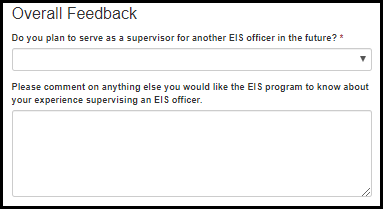
Table 7.5.1.4.a Overall Feedback Fields
Field Name |
Values |
EIS |
LLS |
FLIGHT |
EEP |
SAF |
PHIFP |
PE |
ELI |
PHAP |
Do you plan to serve as a supervisor for another EIS officer in the future? |
1.
Yes |
Yes |
No |
No |
No |
No |
No |
No |
No |
No |
If you selected “No” or “Undecided,” please explain: |
- |
Yes |
No |
No |
No |
No |
No |
No |
No |
No |
Please comment on anything else you would like the EIS program to know about your experience supervising an EIS officer. |
- |
Yes |
No |
No |
No |
No |
No |
No |
No |
No |
Figure 7.5.2.1.a Introduction Fields
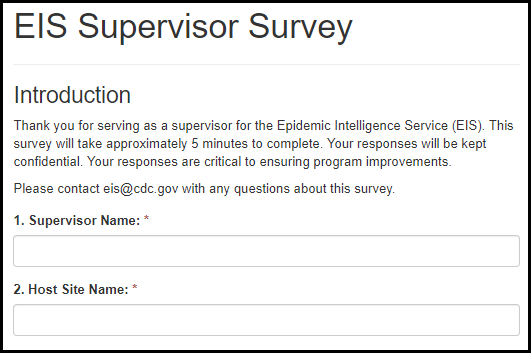
Table 7.5.2.1.a Introduction Fields
Field Name |
Values |
EIS |
LLS |
FLIGHT |
EEP |
SAF |
PHIFP |
PE |
ELI |
PHAP |
1. Supervisor Name: |
- |
Yes |
No |
No |
No |
No |
No |
No |
No |
No |
2. Host Site Name: |
- |
Yes |
No |
No |
No |
No |
No |
No |
No |
No |
Feedback on EIS Program Support
Figure 7.5.2.2.a. Feedback on EIS Program Support Fields


Figure 7.5.2.2.b. Feedback on EIS Program Support Fields

Table 7.5.2.2.a. Feedback on EIS Program Support Fields
Field Name |
Values |
EIS |
LLS |
FLIGHT |
EEP |
SAF |
PHIFP |
PE |
ELI |
PHAP |
a) The EIS Handbook is a useful resource. |
1.
Strongly Disagree |
Yes |
No |
No |
No |
No |
No |
No |
No |
No |
b) Supervisor orientation provided me with the information I needed to begin supervising my officer. |
1.
Strongly Disagree |
Yes |
No |
No |
No |
No |
No |
No |
No |
No |
c) The EIS program clearly communicated supervisory expectations before the fellowship started. |
1.
Strongly Disagree |
Yes |
No |
No |
No |
No |
No |
No |
No |
No |
d) When I have a question or issue to discuss with the EIS program, I know which person to contact. |
1.
Strongly Disagree |
Yes |
No |
No |
No |
No |
No |
No |
No |
No |
Table 7.5.2.2.b. Feedback on EIS Program Support Fields
Field Name |
Values |
EIS |
LLS |
FLIGHT |
EEP |
SAF |
PHIFP |
PE |
ELI |
PHAP |
e) When I have a question or issue to discuss with the EIS program, the question or issue is resolved within a timely manner. |
1.
Strongly Disagree |
Yes |
No |
No |
No |
No |
No |
No |
No |
No |
f) I am satisfied with the support that I am receiving from the EIS program. |
1.
Strongly Disagree |
Yes |
No |
No |
No |
No |
No |
No |
No |
No |
4. If you selected “strongly disagree” or “disagree,” please explain in the space provided below. |
- |
Yes |
No |
No |
No |
No |
No |
No |
No |
No |
5. Please identify any support services that you have not received from the EIS program before the fellowship started that would have improved your experience. |
- |
Yes |
No |
No |
No |
No |
No |
No |
No |
No |
6. Please identify any support services that you have not received from the EIS program during the past year that would have improved your experience. |
- |
Yes |
No |
No |
No |
No |
No |
No |
No |
No |
Feedback on Supervisor Training
Figure 7.5.2.3.a. Feedback on Supervisor Training Fields

Table 7.5.2.3.a. Feedback on Supervisor Training Fields
Field Name |
Values |
EIS |
LLS |
FLIGHT |
EEP |
SAF |
PHIFP |
PE |
ELI |
PHAP |
7. Please indicate your level of agreement: Supervisor seminars provided me with the information needed to supervise my officer throughout the year. |
1.
Strongly Disagree |
Yes |
No |
No |
No |
No |
No |
No |
No |
No |
8. If you selected “strongly disagree,” “disagree,” or “I have not attended any supervisor seminars,” please explain in the space provided below. |
- |
Yes |
No |
No |
No |
No |
No |
No |
No |
No |
9. Please identify any training areas that you have not received from the EIS program that would improve your supervisor experience, knowledge, or skills. |
- |
Yes |
No |
No |
No |
No |
No |
No |
No |
No |
10. Describe your management style: |
- |
Yes |
No |
No |
No |
No |
No |
No |
No |
No |
Overall Feedback
Figure 7.5.2.4.a. Overall Feedback Fields

Table 7.5.2.4.a. Overall Feedback Fields
Field Name |
Values |
EIS |
LLS |
FLIGHT |
EEP |
SAF |
PH-TIPP |
PHIFP |
PE |
ELI |
PHAP |
11. Please comment on anything else you would like the EIS program to know about your experience supervising an EIS officer. |
- |
Yes |
No |
No |
No |
No |
No |
No |
No |
No |
No |
Figure 7.5.3.1.a Introduction Fields
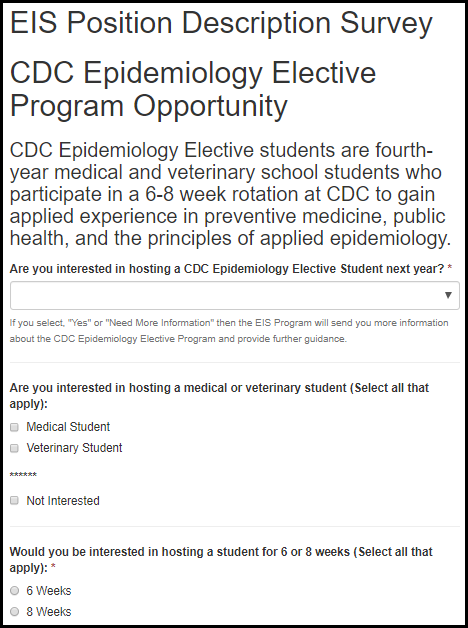
Table 7.5.3.1.a Introduction Fields
Field Name |
Values |
EIS |
LLS |
FLIGHT |
EEP |
SAF |
PHIFP |
PE |
ELI |
PHAP |
2. Are you interested in hosting a CDC Epidemiology Elective student next year? |
1.
Yes |
Yes |
No |
No |
No |
No |
No |
No |
No |
No |
3. Are you interested in hosting a medical or veterinary student (Select all that apply): |
1.
Medical Student 3. Not Interested |
Yes |
No |
No |
No |
No |
No |
No |
No |
No |
4. Would you be interested in hosting a student for 6 or 8 weeks (Select all that apply): |
1. 6 weeks 2. 8 weeks |
Yes |
No |
No |
No |
No |
No |
No |
No |
No |
EIS Officer Professional Category Needs Assessment
Figure 7.5.3.2.a EIS Officer Professional Category Needs Assessment Fields
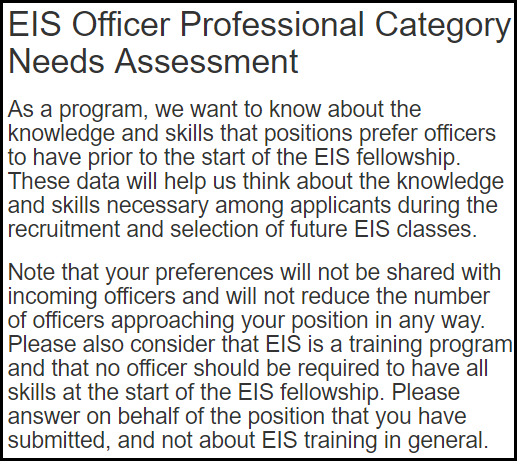
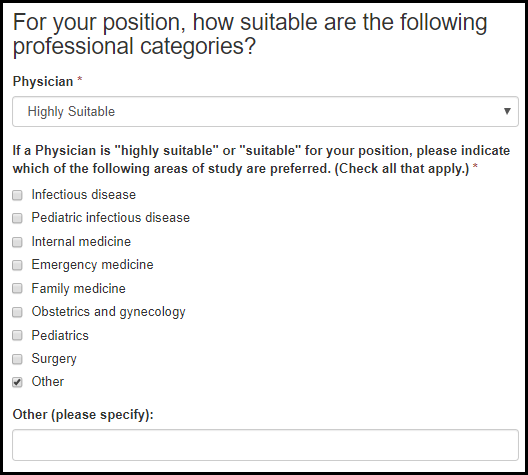
Figure 7.5.3.2.b EIS Officer Professional Category Needs Assessment Fields

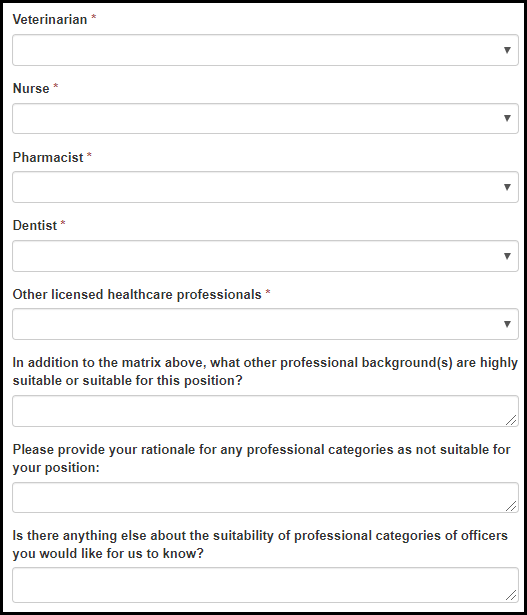
Table 7.5.3.2.a EIS Officer Professional Category Needs Assessment Fields
Field Name |
Values |
EIS |
LLS |
FLIGHT |
EEP |
SAF |
PHIFP |
PE |
ELI |
PHAP |
Physician: |
1.
Highly Suitable |
Yes |
No |
No |
No |
No |
No |
No |
No |
No |
9. If a Physician is "highly suitable" or "suitable" for your position, please indicate which of the following areas of study are preferred. (Check all that apply) |
1.
Infectious disease |
Yes |
No |
No |
No |
No |
No |
No |
No |
No |
Please List: |
- |
Yes |
No |
No |
No |
No |
No |
No |
No |
No |
Doctoral Scientist: |
1.
Highly Suitable |
Yes |
No |
No |
No |
No |
No |
No |
No |
No |
8. If a Doctoral Scientist is "highly suitable" or "suitable" for your position, please indicate which of the following areas of study are preferred. (Select all that apply) |
1.
Epidemiology, general |
Yes |
No |
No |
No |
No |
No |
No |
No |
No |
Please List: |
- |
Yes |
No |
No |
No |
No |
No |
No |
No |
No |
Figure 7.5.3.2.b EIS Officer Professional Category Needs Assessment Fields
Field Name |
Values |
EIS |
LLS |
FLIGHT |
EEP |
SAF |
PHIFP |
PE |
ELI |
PHAP |
Veterinarian: |
1.
Highly Suitable |
Yes |
No |
No |
No |
No |
No |
No |
No |
No |
Nurse: |
1.
Highly Suitable |
Yes |
No |
No |
No |
No |
No |
No |
No |
No |
Pharmacist: |
1.
Highly Suitable |
Yes |
No |
No |
No |
No |
No |
No |
No |
No |
Dentist: |
1.
Highly Suitable |
Yes |
No |
No |
No |
No |
No |
No |
No |
No |
Other licensed healthcare professionals: |
1.
Highly Suitable |
Yes |
No |
No |
No |
No |
No |
No |
No |
No |
6. In addition to the matrix above, what other professional background(s) are highly suitable or suitable for this position? |
- |
Yes |
No |
No |
No |
No |
No |
No |
No |
No |
7. Please provide your rationale for any professional categories as not suitable for your position: |
- |
Yes |
No |
No |
No |
No |
No |
No |
No |
No |
10. Is there anything else about the suitability of professional categories of officers you would like for us to know? |
- |
Yes |
No |
No |
No |
No |
No |
No |
No |
No |
EIS Officer Knowledge and Skills Needs Assessment
Figure 7.5.3.3.a EIS Officer Knowledge and Skills Needs Assessment Fields


Table 7.5.3.3.a EIS Officer Knowledge and Skills Needs Assessment Fields
Field Name |
Values |
EIS |
LLS |
FLIGHT |
EEP |
SAF |
PHIFP |
PE |
ELI |
PHAP |
Clinical skills, knowledge, and experience: |
1.
Yes, my position will greatly benefit from an officer with this
skill at the start of EIS |
Yes |
No |
No |
No |
No |
No |
No |
No |
No |
What type of clinical experience? |
1.
Human |
Yes |
No |
No |
No |
No |
No |
No |
No |
No |
Medical chart review |
1.
Yes, my position will greatly benefit from an officer with this
skill at the start of EIS |
Yes |
No |
No |
No |
No |
No |
No |
No |
No |
Foreign language |
1.
Yes, my position will greatly benefit from an officer with this
skill at the start of EIS |
Yes |
No |
No |
No |
No |
No |
No |
No |
No |
If yes, what languages? |
- |
Yes |
No |
No |
No |
No |
No |
No |
No |
No |
Global field experience |
1.
Yes, my position will greatly benefit from an officer with this
skill at the start of EIS |
Yes |
No |
No |
No |
No |
No |
No |
No |
No |
Table 7.5.3.3.b EIS Officer Knowledge and Skills Needs Assessment Fields
Field Name |
Values |
EIS |
LLS |
FLIGHT |
EEP |
SAF |
PHIFP |
PE |
ELI |
PHAP |
Experience working with international partners |
1.
Yes, my position will greatly benefit from an officer with this
skill at the start of EIS |
Yes |
No |
No |
No |
No |
No |
No |
No |
No |
Qualitative or anthropological methods |
1.
Yes, my position will greatly benefit from an officer with this
skill at the start of EIS |
Yes |
No |
No |
No |
No |
No |
No |
No |
No |
Large secondary data management |
1.
Yes, my position will greatly benefit from an officer with this
skill at the start of EIS |
Yes |
No |
No |
No |
No |
No |
No |
No |
No |
Advanced epidemiologic or behavioral science analytical methods |
1.
Yes, my position will greatly benefit from an officer with this
skill at the start of EIS |
Yes |
No |
No |
No |
No |
No |
No |
No |
No |
Scientific writing |
|
Yes |
No |
No |
No |
No |
No |
No |
No |
No |
Figure 7.5.3.3.c EIS Officer Knowledge and Skills Needs Assessment Fields
Field Name |
Values |
EIS |
LLS |
FLIGHT |
EEP |
SAF |
PHIFP |
PE |
ELI |
PHAP |
12. In addition to the matrix above, what other knowledge, skill, or experience areas would greatly benefit your position at the start of EIS? |
- |
Yes |
No |
No |
No |
No |
No |
No |
No |
No |
13. Is there anything else about the knowledge, skill, or experience areas for your position you would like for us to know? |
- |
Yes |
No |
No |
No |
No |
No |
No |
No |
No |
Figure 8.1.1.1.a. General Information Fields
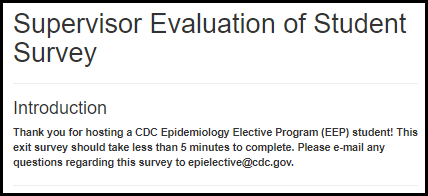
Main Project
Figure 8.1.1.2.a. Main Project Fields
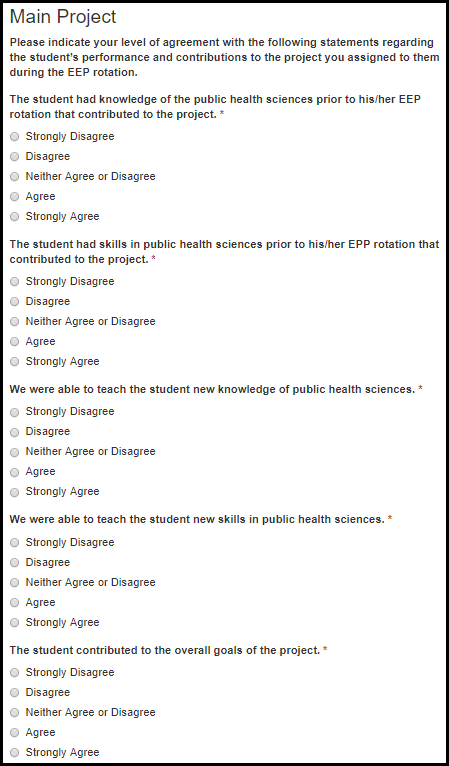
Table 8.1.1.2.a. Main Project Fields
Field Name |
Values |
EIS |
LLS |
FLIGHT |
EEP |
SAF |
PHIFP |
PE |
ELI |
PHAP |
The student had knowledge of the public health sciences prior to his/her EEP rotation that contributed to the project. |
1.
Strongly Disagree |
No |
No |
No |
Yes |
No |
No |
No |
No |
No |
The student had skills in public health sciences prior to his/her EPP rotation that contributed to the project. |
1.
Strongly Disagree |
No |
No |
No |
Yes |
No |
No |
No |
No |
No |
We were able to teach the student new knowledge of public health sciences. |
1.
Strongly Disagree |
No |
No |
No |
Yes |
No |
No |
No |
No |
No |
We were able to teach the student new skills in public health sciences. |
1.
Strongly Disagree |
No |
No |
No |
Yes |
No |
No |
No |
No |
No |
The student contributed to the overall goals of the project. |
1.
Strongly Disagree |
No |
No |
No |
Yes |
No |
No |
No |
No |
No |
Student Professional Skills
Figure 8.1.1.3.a. Student Professional Skills Fields

Table 8.1.1.3.a. Student Professional Skills Fields
Field Name |
Values |
EIS |
LLS |
FLIGHT |
EEP |
SAF |
PHIFP |
PE |
ELI |
PHAP |
Demonstrated the ability to set goals and objectives. |
1.
Strongly Disagree |
No |
No |
No |
Yes |
No |
No |
No |
No |
No |
Accomplished necessary tasks and completed assigned work. |
1.
Strongly Disagree |
No |
No |
No |
Yes |
No |
No |
No |
No |
No |
Organized and used time efficiently. |
1.
Strongly Disagree |
No |
No |
No |
Yes |
No |
No |
No |
No |
No |
Was able to quickly adapt to changing needs and priorities to support the team. |
1.
Strongly Disagree |
No |
No |
No |
Yes |
No |
No |
No |
No |
No |
Developed working relationships with a variety of people. |
1.
Strongly Disagree |
No |
No |
No |
Yes |
No |
No |
No |
No |
No |
Figure 8.1.1.3.b. Student Professional Skills Fields

Table 8.1.1.3.b. Student Professional Skills Fields
Field Name |
Values |
EIS |
LLS |
FLIGHT |
EEP |
SAF |
PHIFP |
PE |
ELI |
PHAP |
Contributed positively to the team dynamic. |
1.
Strongly Disagree |
No |
No |
No |
Yes |
No |
No |
No |
No |
No |
Demonstrated effective oral communication skills. |
1.
Strongly Disagree |
No |
No |
No |
Yes |
No |
No |
No |
No |
No |
Demonstrated effective written communication skills. |
1.
Strongly Disagree |
No |
No |
No |
Yes |
No |
No |
No |
No |
No |
Was effective at solving problems. |
1.
Strongly Disagree |
No |
No |
No |
Yes |
No |
No |
No |
No |
No |
Presented innovative ideas in a professional manner. |
1.
Strongly Disagree |
No |
No |
No |
Yes |
No |
No |
No |
No |
No |
Figure 8.1.1.3.c. Student Professional Skills Fields
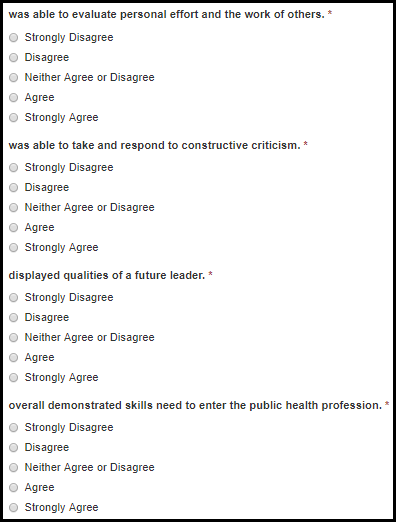
Table 8.1.1.3.c. Student Professional Skills Fields
Field Name |
Values |
EIS |
LLS |
FLIGHT |
EEP |
SAF |
PHIFP |
PE |
ELI |
PHAP |
Was able to evaluate personal effort and the work of others. |
1.
Strongly Disagree |
No |
No |
No |
Yes |
No |
No |
No |
No |
No |
Was able to take and respond to constructive criticism. |
1.
Strongly Disagree |
No |
No |
No |
Yes |
No |
No |
No |
No |
No |
Displayed qualities of a future leader. |
1.
Strongly Disagree |
No |
No |
No |
Yes |
No |
No |
No |
No |
No |
Overall demonstrated skills need to enter the public health profession. |
1.
Strongly Disagree |
No |
No |
No |
Yes |
No |
No |
No |
No |
No |
Future Considerations
Figure 8.1.1.4.a. Future Consideration Fields
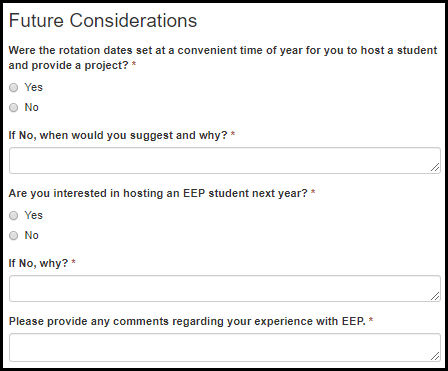
Table 8.1.1.4.a. Future Consideration Fields
Field Name |
Values |
EIS |
LLS |
FLIGHT |
EEP |
SAF |
PHIFP |
PE |
ELI |
PHAP |
Were the rotation dates set at a convenient time of year for you to host a student and provide a project? |
1.
Yes |
No |
No |
No |
Yes |
No |
No |
No |
No |
No |
If No, when would you suggest and why? |
- |
No |
No |
No |
Yes |
No |
No |
No |
No |
No |
Are you interested in hosting an EEP student next year? |
1.
Yes |
No |
No |
No |
Yes |
No |
No |
No |
No |
No |
If No, why? |
- |
No |
No |
No |
Yes |
No |
No |
No |
No |
No |
Please provide any comments regarding your experience with EEP. |
- |
No |
No |
No |
Yes |
No |
No |
No |
No |
No |
Figure 8.1.2.a. Project Review Fields
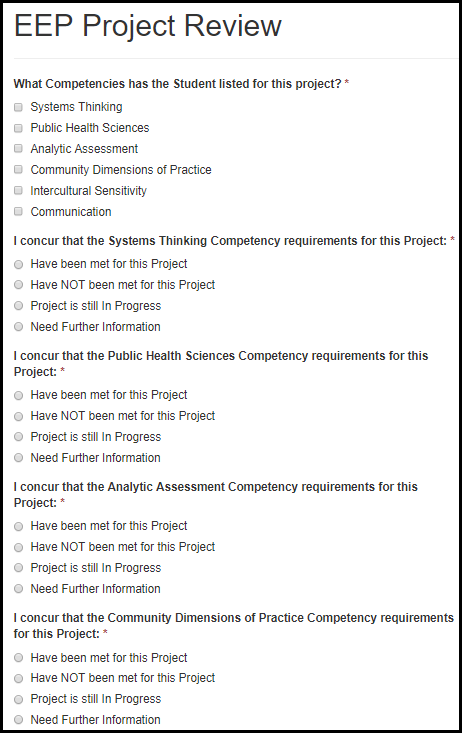
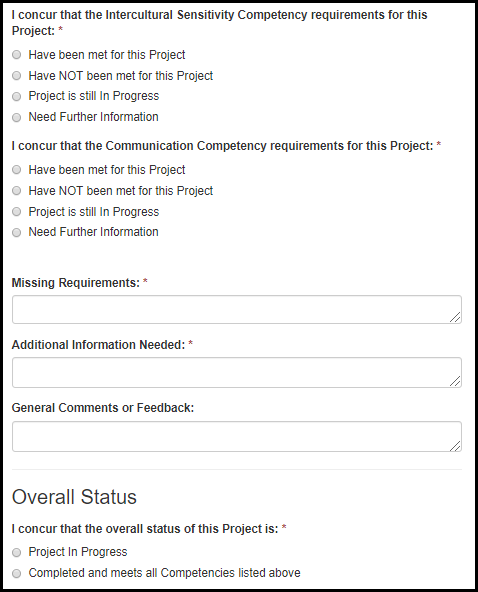
Table 8.1.2.a. Project Review Fields
Field Name |
Values |
EIS |
LLS |
EEP |
SAF |
PHIFP |
PE |
ELI |
PHAP |
What competencies has the student listed for this project? |
1.
Systems Thinking |
No |
No |
Yes |
No |
No |
No |
No |
No |
I concur that the competency requirements for this project: |
1.
Have been met for this Project |
No |
No |
Yes |
No |
No |
No |
No |
No |
Missing requirements: |
- |
Yes |
Yes |
Yes |
Yes |
Yes |
Yes |
Yes |
Yes |
Additional information needed: |
- |
Yes |
Yes |
Yes |
Yes |
Yes |
Yes |
Yes |
Yes |
General comments or feedback: |
- |
Yes |
Yes |
Yes |
Yes |
Yes |
Yes |
Yes |
Yes |
I concur that the overall status of this project is: |
1.
Project in Progress |
No |
No |
Yes |
No |
No |
No |
No |
No |
Figure 8.2.1.a. Fellow Assessment Fields

Table 8.2.1.a. Fellow Assessment Fields
Field Name |
Values |
EIS |
LLS |
FLIGHT |
EEP |
SAF |
PHIFP |
PE |
ELI |
PHAP |
Fellow will meet the Core Activities of Learning (CALs) during this LLS assignment |
1.
Strongly Disagree |
No |
Yes |
No |
No |
No |
No |
No |
No |
No |
If you disagree with any statement listed above, please provide comments for why you disagree: |
- |
No |
Yes |
No |
No |
No |
No |
No |
No |
No |
What concerns do you have or challenges do you anticipate in the next 6 months? |
- |
No |
Yes |
No |
No |
No |
No |
No |
No |
No |
What changes or additions to support would you like to see from the LLS Program? Why? |
- |
No |
Yes |
No |
No |
No |
No |
No |
No |
No |
Figure 8.2.2.1.a. CAL 1 Fields

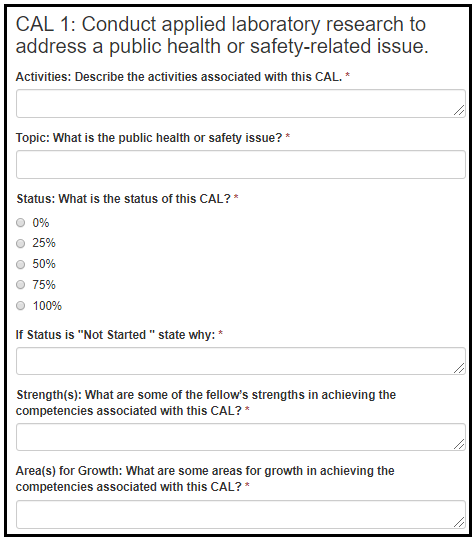
Table 8.2.2.1.a. CAL 1 Fields
Field Name |
Values |
EIS |
LLS |
FLIGHT |
EEP |
SAF |
PHIFP |
PE |
ELI |
PHAP |
Activities: Describe the activities associated with this CAL. |
- |
No |
Yes |
No |
No |
No |
No |
No |
No |
No |
Topic: What is the public health or safety issue? |
- |
No |
Yes |
No |
No |
No |
No |
No |
No |
No |
Status: What is the status of this CAL? |
1.
0% |
No |
Yes |
No |
No |
No |
No |
No |
No |
No |
If Status is "Not Started " state why: |
- |
No |
Yes |
No |
No |
No |
No |
No |
No |
No |
Strength(s): What are some of the fellow’s strengths in achieving the competencies associated with this CAL? |
- |
No |
Yes |
No |
No |
No |
No |
No |
No |
No |
Area(s) for Growth: What are some areas for growth in achieving the competencies associated with this CAL? |
- |
No |
Yes |
No |
No |
No |
No |
No |
No |
No |
Figure 8.2.2.1.b. CAL 2 Fields

Table 8.2.2.1.b. CAL 2 Fields
Field Name |
Values |
EIS |
LLS |
FLIGHT |
EEP |
SAF |
PHIFP |
PE |
ELI |
PHAP |
Activities: Describe the activities associated with this CAL. |
- |
No |
Yes |
No |
No |
No |
No |
No |
No |
No |
Topic: What is the public health or safety issue? |
- |
No |
Yes |
No |
No |
No |
No |
No |
No |
No |
Status: What is the status of this CAL? |
1.
0% |
No |
Yes |
No |
No |
No |
No |
No |
No |
No |
If Status is "Not Started " state why: |
- |
No |
Yes |
No |
No |
No |
No |
No |
No |
No |
Strength(s): What are some of the fellow’s strengths in achieving the competencies associated with this CAL? |
- |
No |
Yes |
No |
No |
No |
No |
No |
No |
No |
Area(s) for Growth: What are some areas for growth in achieving the competencies associated with this CAL? |
- |
No |
Yes |
No |
No |
No |
No |
No |
No |
No |
Figure 8.2.2.1.c. CAL 3 Fields
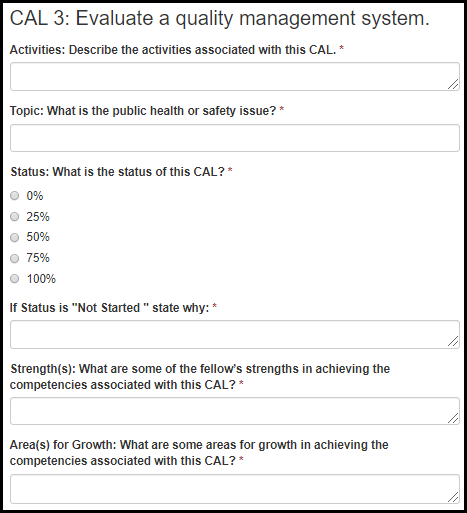
Table 8.2.2.1.c. CAL 3 Fields
Field Name |
Values |
EIS |
LLS |
FLIGHT |
EEP |
SAF |
PHIFP |
PE |
ELI |
PHAP |
Activities: Describe the activities associated with this CAL. |
- |
No |
Yes |
No |
No |
No |
No |
No |
No |
No |
Topic: What is the public health or safety issue? |
- |
No |
Yes |
No |
No |
No |
No |
No |
No |
No |
Status: What is the status of this CAL? |
1.
0% |
No |
Yes |
No |
No |
No |
No |
No |
No |
No |
If Status is "Not Started " state why: |
- |
No |
Yes |
No |
No |
No |
No |
No |
No |
No |
Strength(s): What are some of the fellow’s strengths in achieving the competencies associated with this CAL? |
- |
No |
Yes |
No |
No |
No |
No |
No |
No |
No |
Area(s) for Growth: What are some areas for growth in achieving the competencies associated with this CAL? |
- |
No |
Yes |
No |
No |
No |
No |
No |
No |
No |
Figure 8.2.2.1.d. CAL 4 Fields
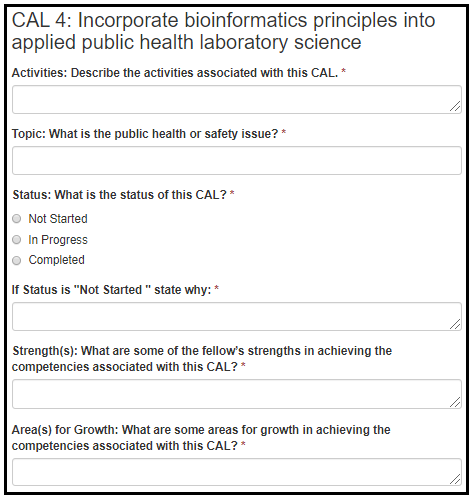
Table 8.2.2.1.d. CAL 4 Fields
Field Name |
Values |
EIS |
LLS |
FLIGHT |
EEP |
SAF |
PHIFP |
PE |
ELI |
PHAP |
Activities: Describe the activities associated with this CAL. |
- |
No |
Yes |
No |
No |
No |
No |
No |
No |
No |
Topic: What is the public health or safety issue? |
- |
No |
Yes |
No |
No |
No |
No |
No |
No |
No |
Status: What is the status of this CAL? |
1. Not Started 2.
In Progress |
No |
Yes |
No |
No |
No |
No |
No |
No |
No |
If Status is "Not Started " state why: |
- |
No |
Yes |
No |
No |
No |
No |
No |
No |
No |
Strength(s): What are some of the fellow’s strengths in achieving the competencies associated with this CAL? |
- |
No |
Yes |
No |
No |
No |
No |
No |
No |
No |
Area(s) for Growth: What are some areas for growth in achieving the competencies associated with this CAL? |
- |
No |
Yes |
No |
No |
No |
No |
No |
No |
No |
Figure 8.2.2.1.e. CAL 5 Fields
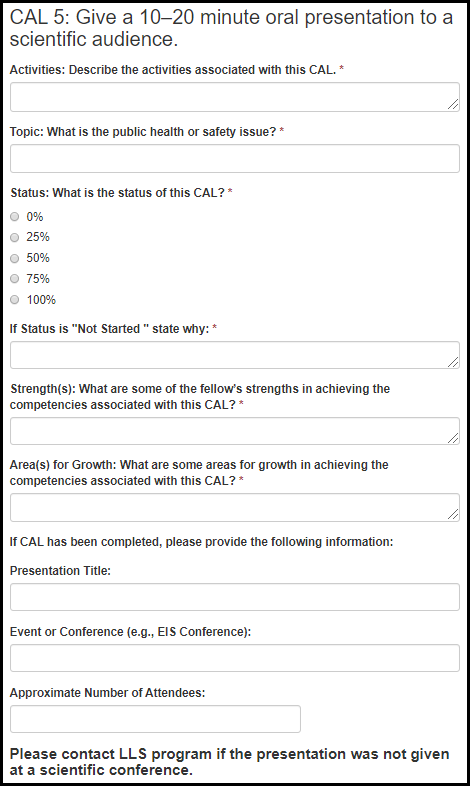
Table 8.2.2.1.e. CAL 5 Fields
Field Name |
Values |
EIS |
LLS |
FLIGHT |
EEP |
SAF |
PHIFP |
PE |
ELI |
PHAP |
Activities: Describe the activities associated with this CAL. |
- |
No |
Yes |
No |
No |
No |
No |
No |
No |
No |
Topic: What is the public health or safety issue? |
- |
No |
Yes |
No |
No |
No |
No |
No |
No |
No |
Status: What is the status of this CAL? |
1.
0% |
No |
Yes |
No |
No |
No |
No |
No |
No |
No |
If Status is "Not Started " state why: |
- |
No |
Yes |
No |
No |
No |
No |
No |
No |
No |
Strength(s): What are some of the fellow’s strengths in achieving the competencies associated with this CAL? |
- |
No |
Yes |
No |
No |
No |
No |
No |
No |
No |
Area(s) for Growth: What are some areas for growth in achieving the competencies associated with this CAL? |
- |
No |
Yes |
No |
No |
No |
No |
No |
No |
No |
Presentation Title: |
- |
No |
Yes |
No |
No |
No |
No |
No |
No |
No |
Event or Conference (e.g., EIS Conference): |
- |
No |
Yes |
No |
No |
No |
No |
No |
No |
No |
Approximate Number of Attendees: |
- |
No |
Yes |
No |
No |
No |
No |
No |
No |
No |
Figure 8.2.2.1.f. CAL 6 Fields
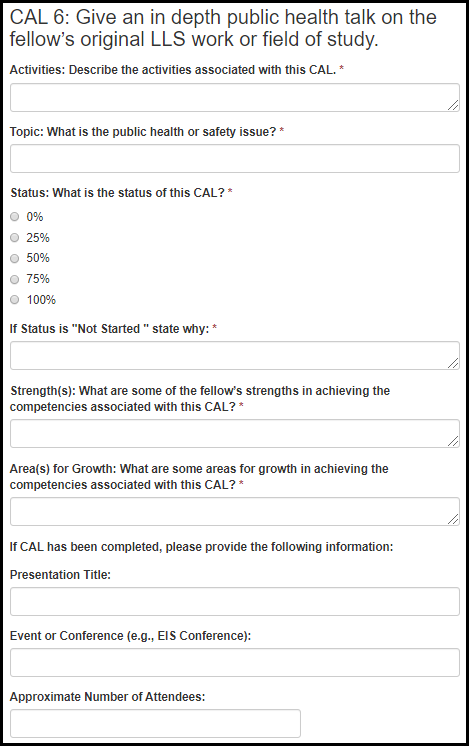
Table 8.2.2.1.f. CAL 6 Fields
Field Name |
Values |
EIS |
LLS |
FLIGHT |
EEP |
SAF |
PHIFP |
PE |
ELI |
PHAP |
Activities: Describe the activities associated with this CAL. |
- |
No |
Yes |
No |
No |
No |
No |
No |
No |
No |
Topic: What is the public health or safety issue? |
- |
No |
Yes |
No |
No |
No |
No |
No |
No |
No |
Status: What is the status of this CAL? |
1.
0% |
No |
Yes |
No |
No |
No |
No |
No |
No |
No |
If Status is "Not Started " state why: |
- |
No |
Yes |
No |
No |
No |
No |
No |
No |
No |
Strength(s): What are some of the fellow’s strengths in achieving the competencies associated with this CAL? |
- |
No |
Yes |
No |
No |
No |
No |
No |
No |
No |
Area(s) for Growth: What are some areas for growth in achieving the competencies associated with this CAL? |
- |
No |
Yes |
No |
No |
No |
No |
No |
No |
No |
Presentation Title: |
- |
No |
Yes |
No |
No |
No |
No |
No |
No |
No |
Event or Conference (e.g., EIS conference): |
- |
No |
Yes |
No |
No |
No |
No |
No |
No |
No |
Approximate Number of Attendees |
- |
No |
Yes |
No |
No |
No |
No |
No |
No |
No |
Figure 8.2.2.1.g. CAL 7 Fields
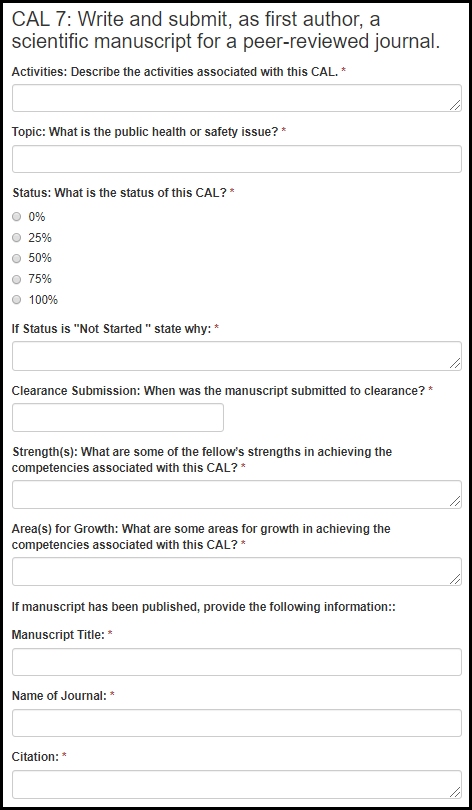
Table 8.2.2.1.g. CAL 7 Fields
Field Name |
Values |
EIS |
LLS |
FLIGHT |
EEP |
SAF |
PHIFP |
PE |
ELI |
PHAP |
Activities: Describe the activities associated with this CAL. |
- |
No |
Yes |
No |
No |
No |
No |
No |
No |
No |
Topic: What is the public health or safety issue? |
- |
No |
Yes |
No |
No |
No |
No |
No |
No |
No |
Status: What is the status of this CAL? |
1.
0% |
No |
Yes |
No |
No |
No |
No |
No |
No |
No |
If Status is "Not Started " state why: |
- |
No |
Yes |
No |
No |
No |
No |
No |
No |
No |
Clearance Submission: When was the manuscript submitted to clearance? |
- |
No |
Yes |
No |
No |
No |
No |
No |
No |
No |
Strength(s): What are some of the fellow’s strengths in achieving the competencies associated with this CAL? |
- |
No |
Yes |
No |
No |
No |
No |
No |
No |
No |
Area(s) for Growth: What are some areas for growth in achieving the competencies associated with this CAL? |
- |
No |
Yes |
No |
No |
No |
No |
No |
No |
No |
Manuscript Title: |
- |
No |
Yes |
No |
No |
No |
No |
No |
No |
No |
Name of Journal: |
- |
No |
Yes |
No |
No |
No |
No |
No |
No |
No |
Citation: |
- |
No |
Yes |
No |
No |
No |
No |
No |
No |
No |
Figure 8.2.2.1.h. CAL 8 Fields
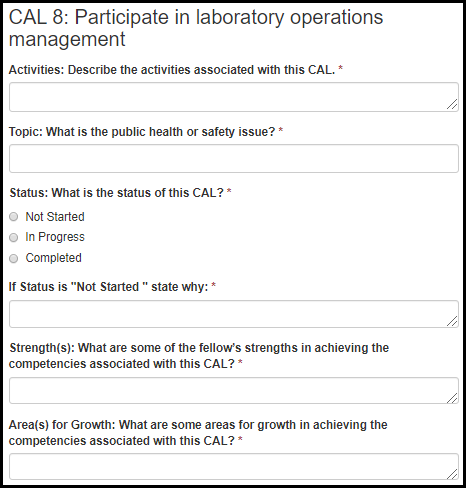
Figure 8.2.2.1.h. CAL 8 Fields
Field Name |
Values |
EIS |
LLS |
FLIGHT |
EEP |
SAF |
PHIFP |
PE |
ELI |
PHAP |
Activities: Describe the activities associated with this CAL. |
- |
No |
Yes |
No |
No |
No |
No |
No |
No |
No |
Topic: What is the public health or safety issue? |
- |
No |
Yes |
No |
No |
No |
No |
No |
No |
No |
Status: What is the status of this CAL? |
1. Not Started 2.
In Progress |
No |
Yes |
No |
No |
No |
No |
No |
No |
No |
If Status is "Not Started " state why: |
- |
No |
Yes |
No |
No |
No |
No |
No |
No |
No |
Strength(s): What are some of the fellow’s strengths in achieving the competencies associated with this CAL? |
- |
No |
Yes |
No |
No |
No |
No |
No |
No |
No |
Area(s) for Growth: What are some areas for growth in achieving the competencies associated with this CAL? |
- |
No |
Yes |
No |
No |
No |
No |
No |
No |
No |
Figure 8.2.2.1.i. CAL 9 Fields
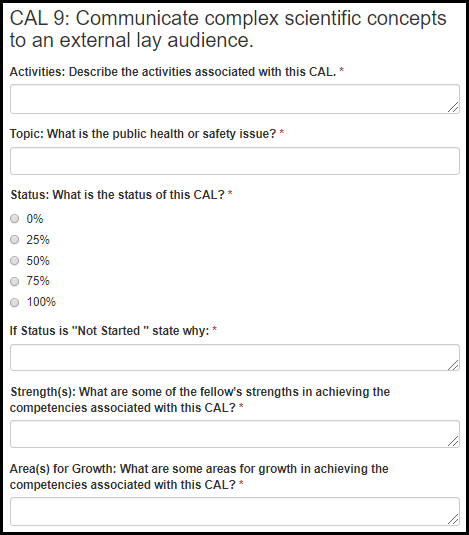
Table 8.2.2.1.i. CAL 9 Fields
Field Name |
Values |
EIS |
LLS |
FLIGHT |
EEP |
SAF |
PHIFP |
PE |
ELI |
PHAP |
Activities: Describe the activities associated with this CAL. |
- |
No |
Yes |
No |
No |
No |
No |
No |
No |
No |
Topic: What is the public health or safety issue? |
- |
No |
Yes |
No |
No |
No |
No |
No |
No |
No |
Status: What is the status of this CAL? |
1.
0% |
No |
Yes |
No |
No |
No |
No |
No |
No |
No |
If Status is "Not Started " state why: |
- |
No |
Yes |
No |
No |
No |
No |
No |
No |
No |
Strength(s): What are some of the fellow’s strengths in achieving the competencies associated with this CAL? |
- |
No |
Yes |
No |
No |
No |
No |
No |
No |
No |
Area(s) for Growth: What are some areas for growth in achieving the competencies associated with this CAL? |
- |
No |
Yes |
No |
No |
No |
No |
No |
No |
No |
Figure 8.2.2.1.j. CAL 10 Fields
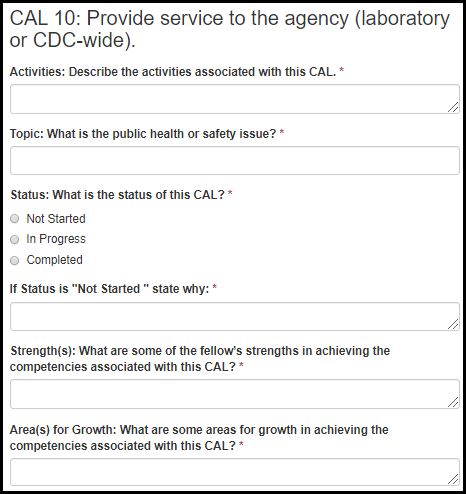
Table 8.2.2.1.j. CAL 10 Fields
Field Name |
Values |
EIS |
LLS |
FLIGHT |
EEP |
SAF |
PHIFP |
PE |
ELI |
PHAP |
Activities: Describe the activities associated with this CAL. |
- |
No |
Yes |
No |
No |
No |
No |
No |
No |
No |
Topic: What is the public health or safety issue? |
- |
No |
Yes |
No |
No |
No |
No |
No |
No |
No |
Status: What is the status of this CAL? |
1. Not Started 2.
In Progress |
No |
Yes |
No |
No |
No |
No |
No |
No |
No |
If Status is "Not Started " state why: |
- |
No |
Yes |
No |
No |
No |
No |
No |
No |
No |
Strength(s): What are some of the fellow’s strengths in achieving the competencies associated with this CAL? |
- |
No |
Yes |
No |
No |
No |
No |
No |
No |
No |
Area(s) for Growth: What are some areas for growth in achieving the competencies associated with this CAL? |
- |
No |
Yes |
No |
No |
No |
No |
No |
No |
No |
Figure 8.2.2.2.a. Project 1 Fields
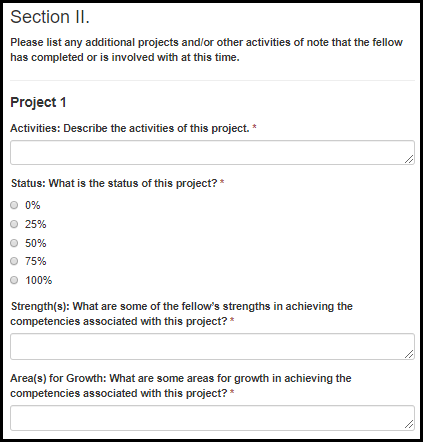
Table 8.2.2.2.a. Project 1 Fields
Field Name |
Values |
EIS |
LLS |
FLIGHT |
EEP |
SAF |
PHIFP |
PE |
ELI |
PHAP |
Activities: Describe the activities of this project. |
- |
No |
Yes |
No |
No |
No |
No |
No |
No |
No |
Status: What is the status of this project? |
1.
0% |
No |
Yes |
No |
No |
No |
No |
No |
No |
No |
Strength(s): What are some of the fellow’s strengths in achieving the competencies associated with this project? |
- |
No |
Yes |
No |
No |
No |
No |
No |
No |
No |
Area(s) for Growth: What are some areas for growth in achieving the competencies associated with this project? |
- |
No |
Yes |
No |
No |
No |
No |
No |
No |
No |
Figure 8.2.2.2.b. Project 2 Fields

Table 8.2.2.2.b. Project 2 Fields
Field Name |
Values |
EIS |
LLS |
FLIGHT |
EEP |
SAF |
PHIFP |
PE |
ELI |
PHAP |
Activities: Describe the activities of this project. |
- |
No |
Yes |
No |
No |
No |
No |
No |
No |
No |
Status: What is the status of this project? |
1.
0% |
No |
Yes |
No |
No |
No |
No |
No |
No |
No |
Strength(s): What are some of the fellow’s strengths in achieving the competencies associated with this project? |
- |
No |
Yes |
No |
No |
No |
No |
No |
No |
No |
Area(s) for Growth: What are some areas for growth in achieving the competencies associated with this project? |
- |
No |
Yes |
No |
No |
No |
No |
No |
No |
No |
Figure 8.2.2.2.c. Project 3 Fields
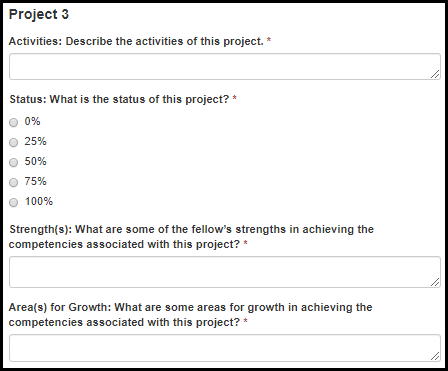
Table 8.2.2.2.c. Project 3 Fields
Field Name |
Values |
EIS |
LLS |
FLIGHT |
EEP |
SAF |
PHIFP |
PE |
ELI |
PHAP |
Activities: Describe the activities of this project. |
- |
No |
Yes |
No |
No |
No |
No |
No |
No |
No |
Status: What is the status of this project? |
1.
0% |
No |
Yes |
No |
No |
No |
No |
No |
No |
No |
Strength(s): What are some of the fellow’s strengths in achieving the competencies associated with this project? |
- |
No |
Yes |
No |
No |
No |
No |
No |
No |
No |
Area(s) for Growth: What are some areas for growth in achieving the competencies associated with this project? |
- |
No |
Yes |
No |
No |
No |
No |
No |
No |
No |
Figure 8.2.3.a. Activity Review Fields


Figure 8.2.3.b. Activity Review Fields
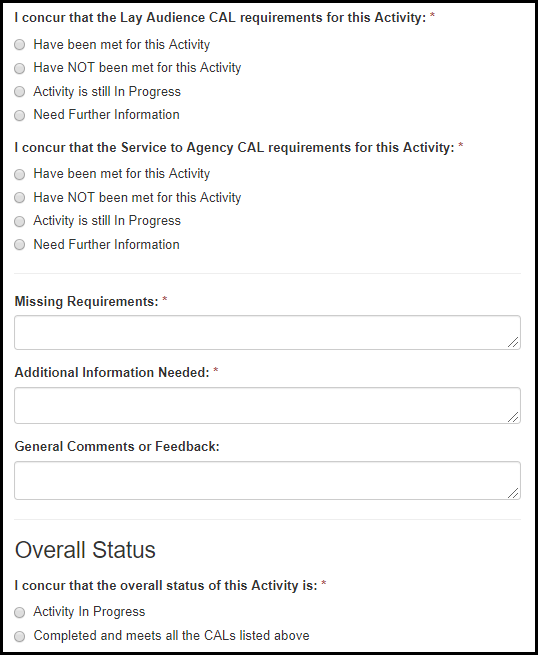
Table 8.2.3.a. Activity Review Fields
Field Name |
Values |
EIS |
LLS |
EEP |
SAF |
PHIFP |
PE |
ELI |
PHAP |
What CALs has the Fellow listed for this activity? |
1.
Applied Laboratory Research |
No |
Yes |
No |
No |
No |
No |
No |
No |
I concur that the CAL requirements for this Activity: |
1.
Have been met for this Activity |
No |
Yes |
No |
No |
No |
No |
No |
No |
Missing Requirements: |
- |
Yes |
Yes |
Yes |
Yes |
Yes |
Yes |
Yes |
Yes |
Additional Information Needed: |
- |
Yes |
Yes |
Yes |
Yes |
Yes |
Yes |
Yes |
Yes |
General Comments or Feedback: |
- |
Yes |
Yes |
Yes |
Yes |
Yes |
Yes |
Yes |
Yes |
I concur that the overall status of this Activity is: |
1.
Activity in Progress |
No |
Yes |
No |
No |
No |
No |
No |
No |
Figure 8.3.1.1.a. Introduction Fields

Table 8.3.1.1.a. Introduction Fields
Field Name |
Values |
EIS |
LLS |
FLIGHT |
EEP |
SAF |
PHIFP |
PE |
ELI |
PHAP |
Supervisor: |
- |
No |
No |
No |
No |
No |
No |
Yes |
No |
No |
Assignment CIO: |
- |
No |
No |
No |
No |
No |
No |
Yes |
No |
No |
Development of Competencies
Figure 8.3.1.2.a. Analytic / Assessment Skills Fields
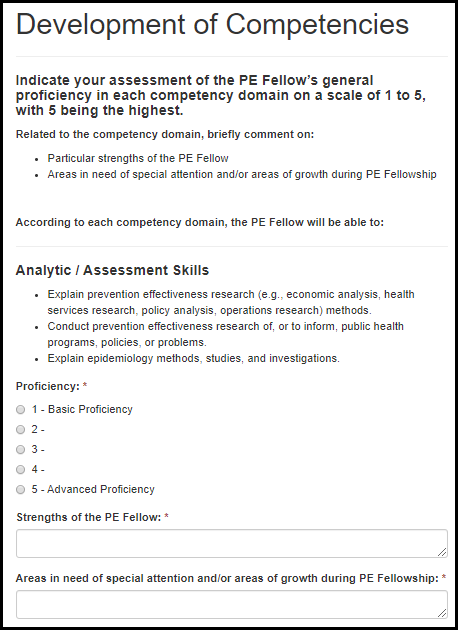
Table 8.3.1.2.a. Analytic / Assessment Skills Fields
Field Name |
Values |
EIS |
LLS |
FLIGHT |
EEP |
SAF |
PHIFP |
PE |
ELI |
PHAP |
Proficiency: |
1.
1 - Basic Proficiency |
No |
No |
No |
No |
No |
No |
Yes |
No |
No |
Strengths of the PE Fellow: |
- |
No |
No |
No |
No |
No |
No |
Yes |
No |
No |
Areas in need of special attention and/or areas of growth during PE Fellowship: |
- |
No |
No |
No |
No |
No |
No |
Yes |
No |
No |
Figure 8.3.1.2.b. Policy Assessment and Communication Fields
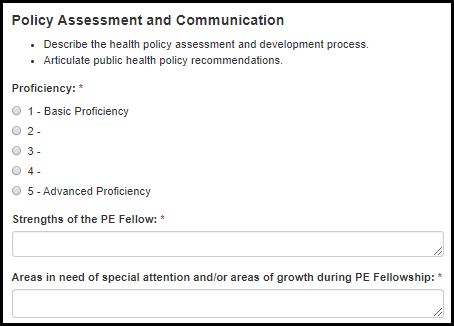
Figure 8.3.1.2.b. Policy Assessment and Communication Fields
Field Name |
Values |
EIS |
LLS |
FLIGHT |
EEP |
SAF |
PHIFP |
PE |
ELI |
PHAP |
Proficiency: |
1.
1 - Basic Proficiency |
No |
No |
No |
No |
No |
No |
Yes |
No |
No |
Strengths of the PE Fellow: |
- |
No |
No |
No |
No |
No |
No |
Yes |
No |
No |
Areas in need of special attention and/or areas of growth during PE Fellowship: |
- |
No |
No |
No |
No |
No |
No |
Yes |
No |
No |
Figure 8.3.1.2.c. Interpersonal and Professional Communication Fields

Table 8.3.1.2.c. Interpersonal and Professional Communication Fields
Field Name |
Values |
EIS |
LLS |
FLIGHT |
EEP |
SAF |
PHIFP |
PE |
ELI |
PHAP |
Proficiency: |
1.
1 - Basic Proficiency |
No |
No |
No |
No |
No |
No |
Yes |
No |
No |
Strengths of the PE Fellow: |
- |
No |
No |
No |
No |
No |
No |
Yes |
No |
No |
Areas in need of special attention and/or areas of growth during PE Fellowship: |
- |
No |
No |
No |
No |
No |
No |
Yes |
No |
No |
Figure 8.3.1.2.d. Foundations for Leadership Fields

Table 8.3.1.2.d. Foundations for Leadership Fields
Field Name |
Values |
EIS |
LLS |
FLIGHT |
EEP |
SAF |
PHIFP |
PE |
ELI |
PHAP |
Proficiency: |
1.
1 - Basic Proficiency |
No |
No |
No |
No |
No |
No |
Yes |
No |
No |
Strengths of the PE Fellow: |
- |
No |
No |
No |
No |
No |
No |
Yes |
No |
No |
Areas in need of special attention and/or areas of growth during PE Fellowship: |
- |
No |
No |
No |
No |
No |
No |
Yes |
No |
No |
Leadership Inventory
Figure 8.3.1.3.a. Leadership Inventory Fields
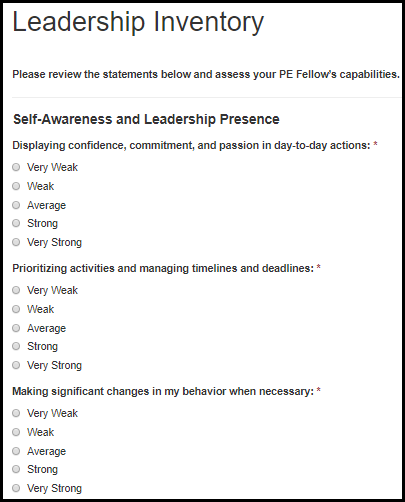
Table 8.3.1.3.a. Leadership Inventory Fields
Field Name |
Values |
EIS |
LLS |
FLIGHT |
EEP |
SAF |
PHIFP |
PE |
ELI |
PHAP |
Displaying confidence, commitment, and passion in day-to-day actions: |
1.
Very Weak |
No |
No |
No |
No |
No |
No |
Yes |
No |
No |
Prioritizing activities and managing timelines and deadlines: |
1.
Very Weak |
No |
No |
No |
No |
No |
No |
Yes |
No |
No |
Making significant changes in my behavior when necessary: |
1.
Very Weak |
No |
No |
No |
No |
No |
No |
Yes |
No |
No |
Figure 8.3.1.3.b. Leadership Inventory Fields

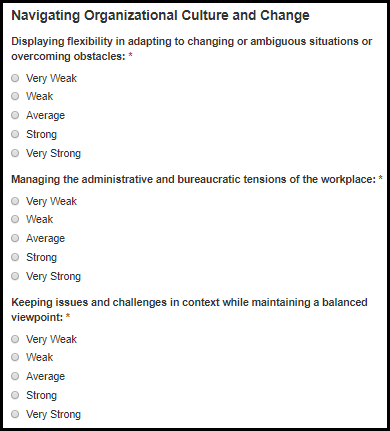
Table 8.3.1.3.b. Leadership Inventory Fields
Field Name |
Values |
EIS |
LLS |
FLIGHT |
EEP |
SAF |
PHIFP |
PE |
ELI |
PHAP |
Listening and communicating clearly and effectively: |
1.
Very Weak |
No |
No |
No |
No |
No |
No |
Yes |
No |
No |
Managing conflict and differences of opinion between myself and others or among others: |
1.
Very Weak |
No |
No |
No |
No |
No |
No |
Yes |
No |
No |
Working effectively as a team member: |
1.
Very Weak |
No |
No |
No |
No |
No |
No |
Yes |
No |
No |
Displaying flexibility in adapting to changing or ambiguous situations or overcoming obstacles: |
1.
Very Weak |
No |
No |
No |
No |
No |
No |
Yes |
No |
No |
Managing the administrative and bureaucratic tensions of the workplace: |
1.
Very Weak |
No |
No |
No |
No |
No |
No |
Yes |
No |
No |
Keeping issues and challenges in context while maintaining a balanced viewpoint: |
1.
Very Weak |
No |
No |
No |
No |
No |
No |
Yes |
No |
No |
Progress on Performance Requirements
Figure 8.3.1.4.a. Progress on Performance Requirements Fields
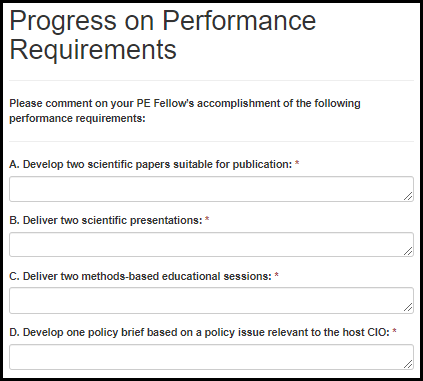
Table 8.3.1.4.a. Progress on Performance Requirements Fields
Field Name |
Values |
EIS |
LLS |
FLIGHT |
EEP |
SAF |
PHIFP |
PE |
ELI |
PHAP |
A. Develop two scientific papers suitable for publication: |
- |
No |
No |
No |
No |
No |
No |
Yes |
No |
No |
B. Deliver two scientific presentations: |
- |
No |
No |
No |
No |
No |
No |
Yes |
No |
No |
C. Deliver two methods-based educational sessions: |
- |
No |
No |
No |
No |
No |
No |
Yes |
No |
No |
D. Develop one policy brief based on a policy issue relevant to the host CIO: |
- |
No |
No |
No |
No |
No |
No |
Yes |
No |
No |
Overall Performance
Figure 8.3.1.5.a. Overall Performance Fields
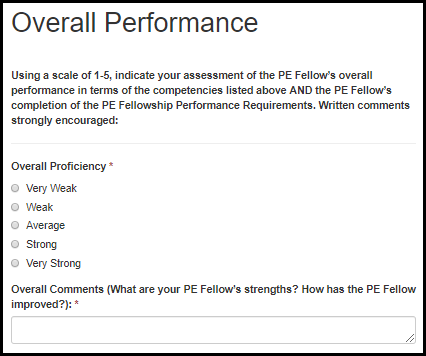
Table 8.3.1.5.a. Overall Performance Fields
Field Name |
Values |
EIS |
LLS |
FLIGHT |
EEP |
SAF |
PHIFP |
PE |
ELI |
PHAP |
Overall Proficiency: |
1.
Very Weak |
No |
No |
No |
No |
No |
No |
Yes |
No |
No |
Overall Comments (What are your PE Fellow’s strengths? How has the PE Fellow improved?): |
- |
No |
No |
No |
No |
No |
No |
Yes |
No |
No |
Statement of Value
Figure 8.3.1.6.a. Statement of Value Fields
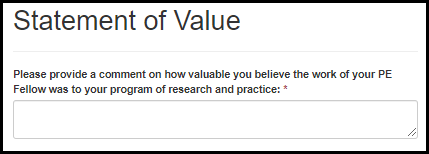
Table 8.3.1.6.a. Statement of Value Fields
Field Name |
Values |
EIS |
LLS |
FLIGHT |
EEP |
SAF |
PHIFP |
PE |
ELI |
PHAP |
Please provide a comment on how valuable you believe the work of your PE Fellow was to your program of research and practice: |
- |
No |
No |
No |
No |
No |
No |
Yes |
No |
No |
Figure 8.3.2.a. Accomplishment Review Fields
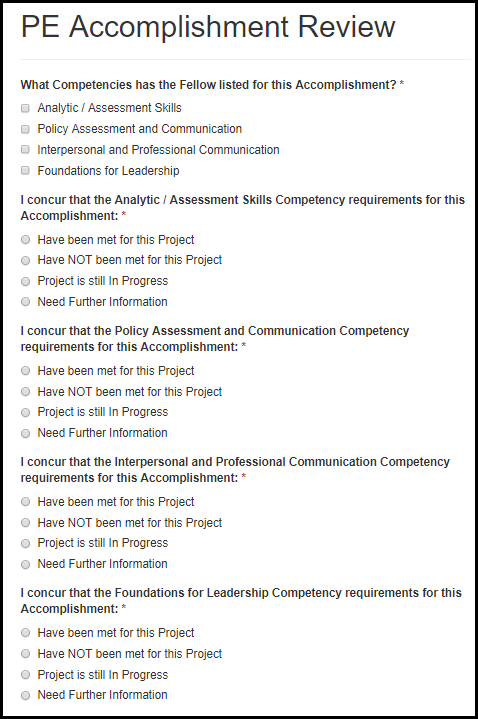

Table 8.3.2.a. Accomplishment Review Fields
Field Name |
Values |
EIS |
LLS |
EEP |
SAF |
PHIFP |
PE |
ELI |
PHAP |
What Competencies has the Fellow listed for this Accomplishment? |
1.
Analytic / Assessment Skills |
No |
No |
No |
No |
No |
Yes |
No |
No |
I concur that the Competency requirements for this Accomplishment: |
1.
Have been met for this Accomplishment |
No |
No |
No |
No |
No |
Yes |
No |
No |
Missing Requirements: |
- |
Yes |
Yes |
Yes |
Yes |
Yes |
Yes |
Yes |
Yes |
Additional Information Needed: |
- |
Yes |
Yes |
Yes |
Yes |
Yes |
Yes |
Yes |
Yes |
General Comments or Feedback: |
- |
Yes |
Yes |
Yes |
Yes |
Yes |
Yes |
Yes |
Yes |
I concur that the overall status of this Accomplishment is: |
1.
Accomplishment in Progress |
No |
No |
No |
No |
No |
Yes |
No |
No |
Figure 8.4.1.1.a. Section 1: Associate Activity Fields
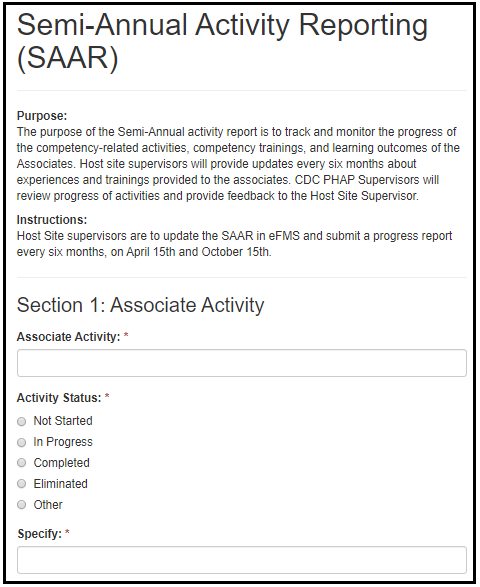
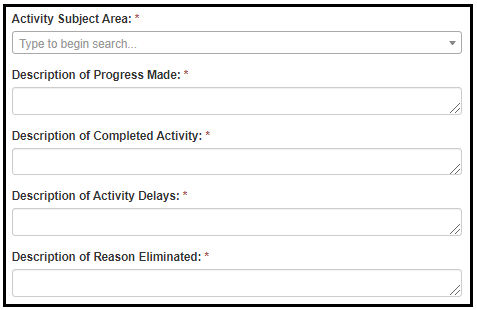
Table 8.4.1.1.a. Section 1: Associate Activity Fields
Field Name |
Values |
EIS |
LLS |
FLIGHT |
EEP |
SAF |
PHIFP |
PE |
ELI |
PHAP |
Associate Activity: |
- |
No |
No |
No |
No |
No |
No |
No |
No |
Yes |
Activity Status: |
1.
Not Started 4. Eliminated 5. Other |
No |
No |
No |
No |
No |
No |
No |
No |
Yes |
Specify: |
- |
No |
No |
No |
No |
No |
No |
No |
No |
Yes |
Activity Subject Area: |
No |
No |
No |
No |
No |
No |
No |
No |
Yes |
|
Description of Progress Made: |
- |
No |
No |
No |
No |
No |
No |
No |
No |
Yes |
Description of Completed Activity: |
- |
No |
No |
No |
No |
No |
No |
No |
No |
Yes |
Description of Activity Delays: |
- |
No |
No |
No |
No |
No |
No |
No |
No |
Yes |
Description of Reason Eliminated: |
- |
No |
No |
No |
No |
No |
No |
No |
No |
Yes |
Section 2: Competency Training
Figure 8.4.1.2.a. Section 2: Competency Training Fields

Table 8.4.1.2.a. Section 2: Competency Training Fields
Field Name |
Values |
EIS |
LLS |
FLIGHT |
EEP |
SAF |
PHIFP |
PE |
ELI |
PHAP |
Select Competency: |
- |
No |
No |
No |
No |
No |
No |
No |
No |
Yes |
Competency Training Status: |
1.
Not Started |
No |
No |
No |
No |
No |
No |
No |
No |
Yes |
Description of Progress Made: |
- |
No |
No |
No |
No |
No |
No |
No |
No |
Yes |
Description of Delays / Challenges: |
- |
No |
No |
No |
No |
No |
No |
No |
No |
Yes |
Description of Completed Competency Training: |
- |
No |
No |
No |
No |
No |
No |
No |
No |
Yes |
Section 3: Learning Outcome
Figure 8.4.1.3.a. Section 3: Learning Outcome Fields
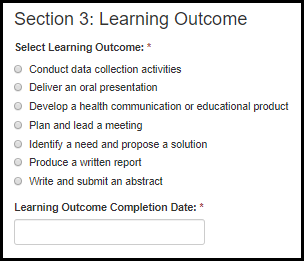
Table 8.4.1.3.a. Section 3: Learning Outcome Fields
Field Name |
Values |
EIS |
LLS |
FLIGHT |
EEP |
SAF |
PHIFP |
PE |
ELI |
PHAP |
Select Learning Outcome: |
1.
Conduct data collection activities |
No |
No |
No |
No |
No |
No |
No |
No |
Yes |
Learning Outcome Completion Date: |
- |
No |
No |
No |
No |
No |
No |
No |
No |
Yes |
Section 4: Priority Training Needs
Figure 8.4.1.4.a. Section 3: Learning Outcome Fields

Table 8.4.1.4.a. Section 3: Learning Outcome Fields
Field Name |
Values |
EIS |
LLS |
FLIGHT |
EEP |
SAF |
PHIFP |
PE |
ELI |
PHAP |
Top Three Recommended Trainings: |
- |
No |
No |
No |
No |
No |
No |
No |
No |
Yes |
Figure 8.4.2.a. Project Review Fields
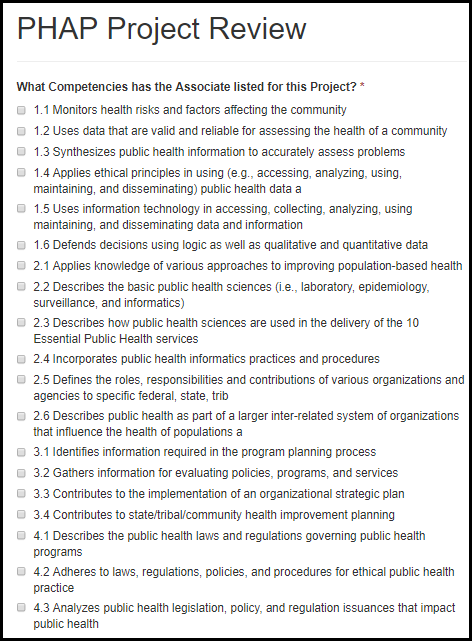
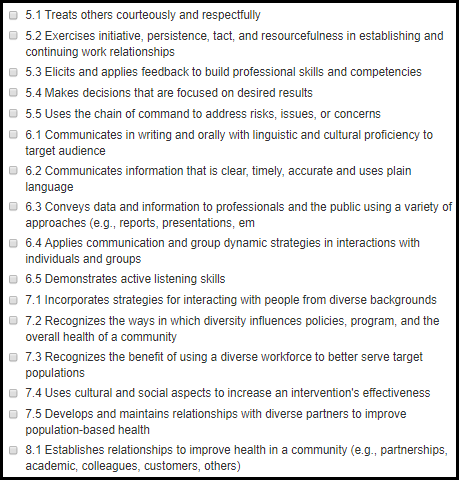
Figure 8.4.2.b. Project Review Fields
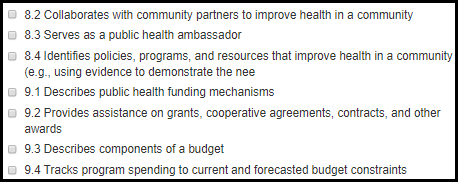
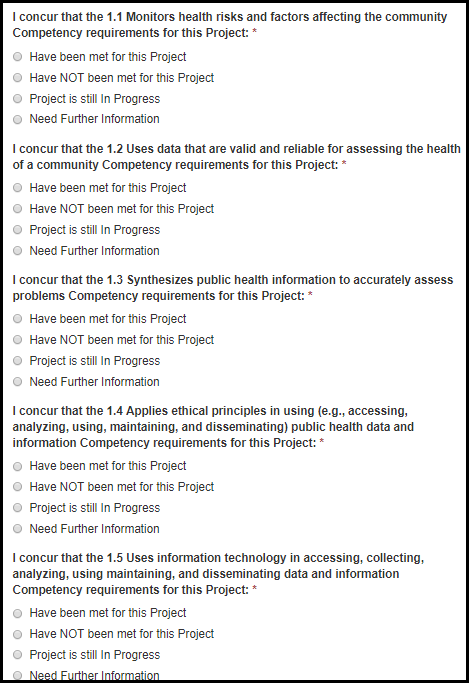
Figure 8.4.2.c. Project Review Fields
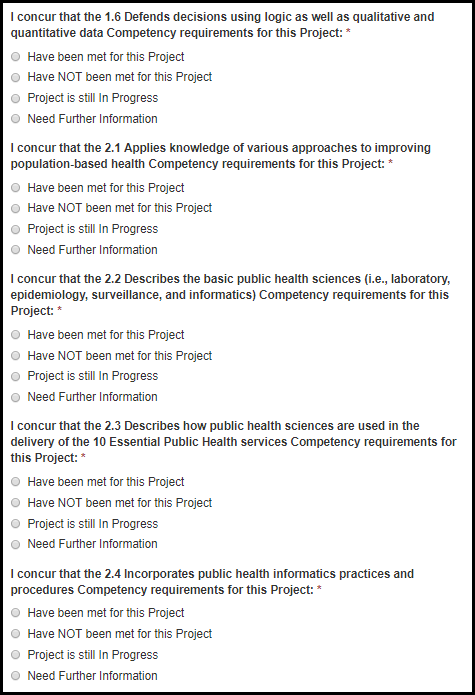
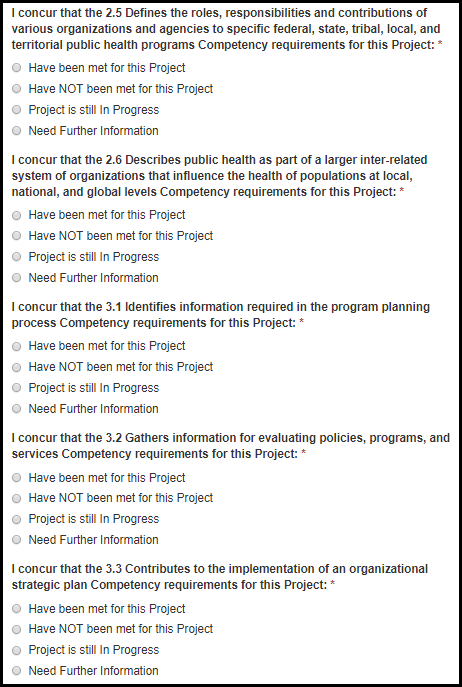
Figure 8.4.2.d. Project Review Fields
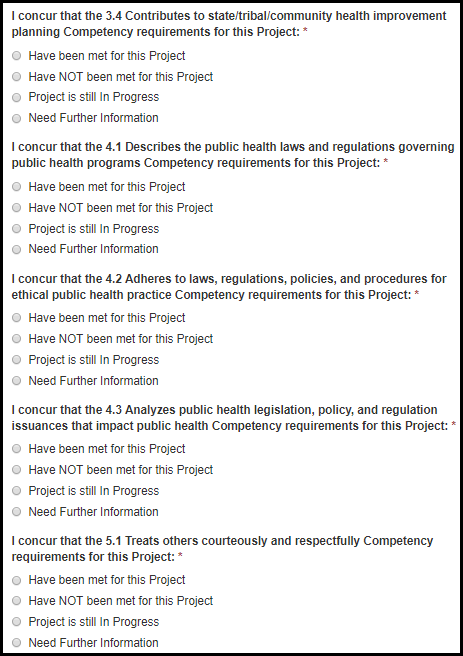
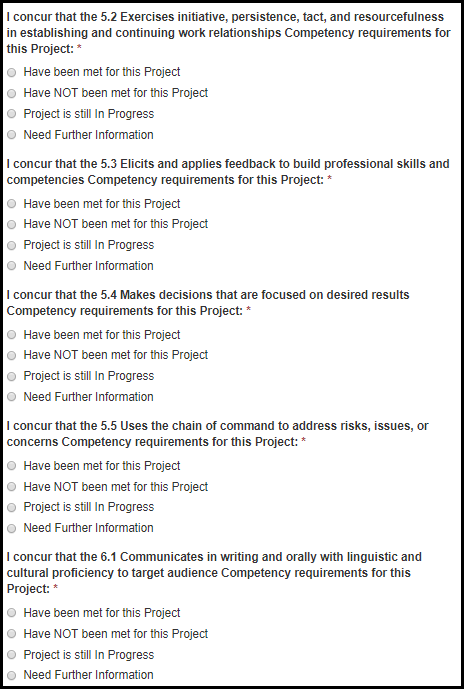
Figure 8.4.2.d. Project Review Fields
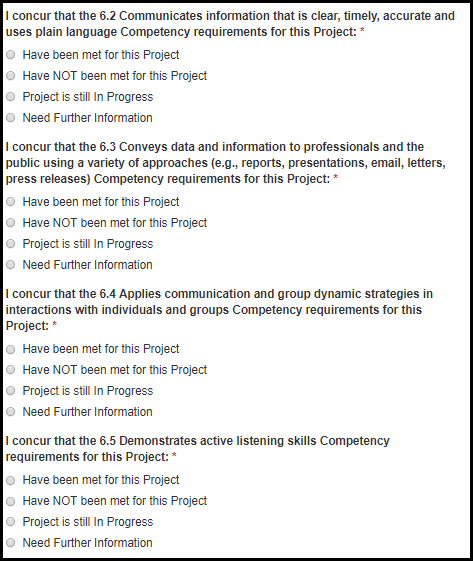

Figure 8.4.2.e. Project Review Fields

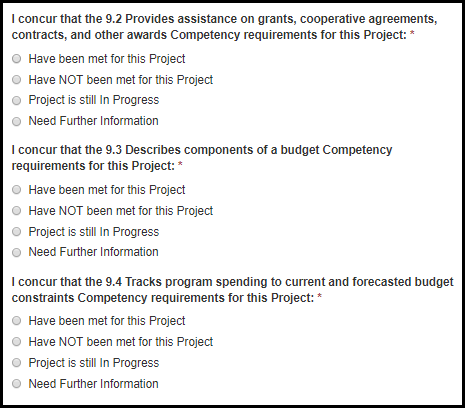
Figure 8.4.2.f. Project Review Fields

Table 8.4.2.a. Project Review Fields
Field Name |
Values |
EIS |
LLS |
EEP |
SAF |
PHIFP |
PE |
ELI |
PHAP |
What Competencies has the Associate listed for this Project? |
1.
1.1 Monitors health risks and factors affecting the community |
No |
No |
No |
No |
No |
No |
No |
Yes |
Table 8.4.2.b. Project Review Fields
Field Name |
Values |
EIS |
LLS |
EEP |
SAF |
PHIFP |
PE |
ELI |
PHAP |
I concur that the Competency requirements for this Project: |
1.
Have been met for this Project |
No |
No |
No |
No |
No |
No |
No |
Yes |
Missing Requirements: |
- |
Yes |
Yes |
Yes |
Yes |
Yes |
Yes |
Yes |
Yes |
Additional Information Needed: |
- |
Yes |
Yes |
Yes |
Yes |
Yes |
Yes |
Yes |
Yes |
General Comments or Feedback: |
- |
Yes |
Yes |
Yes |
Yes |
Yes |
Yes |
Yes |
Yes |
I concur that the overall status of this Project is: |
1.
Project in Progress |
No |
No |
No |
No |
No |
No |
No |
Yes |
Figure 8.5.1.1.a. Introduction Fields
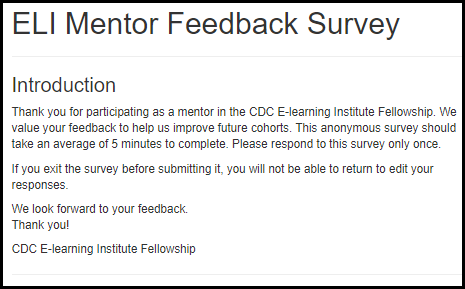
Figure 8.5.1.2.a. Instructional Design Competencies and Program Design Fields

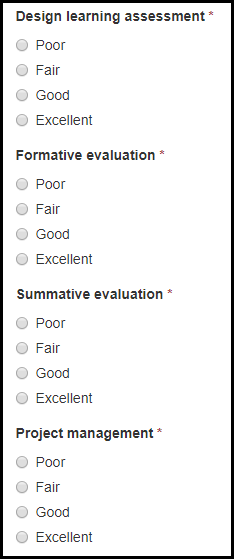

Table 8.5.1.2.a. Instructional Design Competencies and Program Design Fields
Field Name |
Values |
EIS |
LLS |
FLIGHT |
EEP |
SAF |
PHIFP |
PE |
ELI |
PHAP |
Instructional Design (process and application) |
1.
Poor |
No |
No |
No |
No |
No |
No |
No |
Yes |
No |
Data collection and analysis |
1.
Poor |
No |
No |
No |
No |
No |
No |
No |
Yes |
No |
Needs assessment |
1.
Poor |
No |
No |
No |
No |
No |
No |
No |
Yes |
No |
Design of instructional interventions |
1.
Poor |
No |
No |
No |
No |
No |
No |
No |
Yes |
No |
Design learning assessment |
1.
Poor |
No |
No |
No |
No |
No |
No |
No |
Yes |
No |
Formative evaluation |
1.
Poor |
No |
No |
No |
No |
No |
No |
No |
Yes |
No |
Summative evaluation |
1.
Poor |
No |
No |
No |
No |
No |
No |
No |
Yes |
No |
Project management |
1.
Poor |
No |
No |
No |
No |
No |
No |
No |
Yes |
No |
Table 8.5.1.2.b. Instructional Design Competencies and Program Design Fields
Field Name |
Values |
EIS |
LLS |
FLIGHT |
EEP |
SAF |
PHIFP |
PE |
ELI |
PHAP |
2. What is your opinion of the balance of written material, webinars, and interactivity in this fellowship? |
1.
Too much written materials and webinars, and not enough
interactive learning |
No |
No |
No |
No |
No |
No |
No |
Yes |
No |
3. Rate your level of agreement with the following statement about the design of the fellowship.
Content provided in the fellowship reflect current best practices in e-learning and development. |
1.
Strongly Disagree |
No |
No |
No |
No |
No |
No |
No |
Yes |
No |
4. How could the design of this fellowship be improved to make it a more effective learning experience? |
- |
No |
No |
No |
No |
No |
No |
No |
Yes |
No |
Your Mentoring Experience
Figure 8.5.1.3.a. Your Mentoring Experience Fields
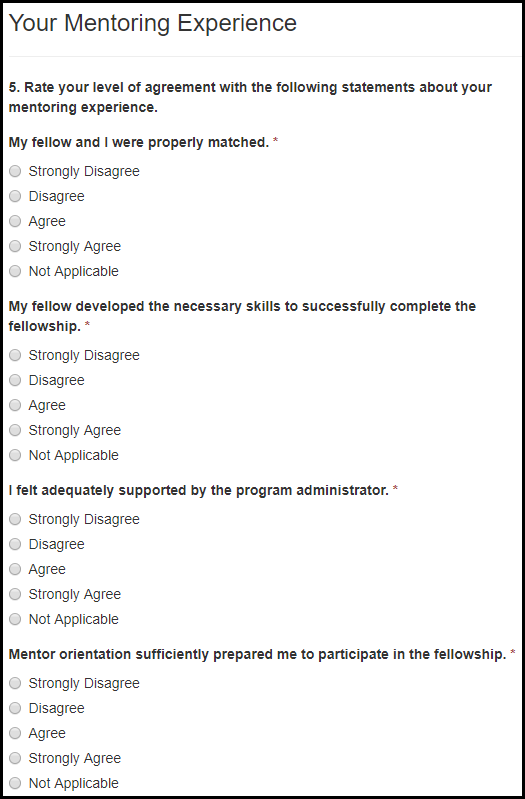

Table 8.5.1.3.a. Your Mentoring Experience Fields
Field Name |
Values |
EIS |
LLS |
FLIGHT |
EEP |
SAF |
PHIFP |
PE |
ELI |
PHAP |
My fellow and I were properly matched. |
1.
Strongly Disagree |
No |
No |
No |
No |
No |
No |
No |
Yes |
No |
My fellow developed the necessary skills to successfully complete the fellowship. |
1.
Strongly Disagree |
No |
No |
No |
No |
No |
No |
No |
Yes |
No |
I felt adequately supported by the program administrator. |
1.
Strongly Disagree |
No |
No |
No |
No |
No |
No |
No |
Yes |
No |
Mentor orientation sufficiently prepared me to participate in the fellowship. |
1.
Strongly Disagree |
No |
No |
No |
No |
No |
No |
No |
Yes |
No |
The time commitment required for mentoring matched my expectations. |
1.
Strongly Disagree |
No |
No |
No |
No |
No |
No |
No |
Yes |
No |
Table 8.5.1.3.b. Your Mentoring Experience Fields
Field Name |
Values |
EIS |
LLS |
FLIGHT |
EEP |
SAF |
PHIFP |
PE |
ELI |
PHAP |
Other mentors were available to assist me when I needed help. |
1.
Strongly Disagree |
No |
No |
No |
No |
No |
No |
No |
Yes |
No |
I would recommend becoming an ELI mentor to others. |
1.
Strongly Disagree |
No |
No |
No |
No |
No |
No |
No |
Yes |
No |
6. How many individuals (peers and fellows) have you developed and plan to maintain a professional relationship with beyond the fellowship? For what purposes? |
- |
No |
No |
No |
No |
No |
No |
No |
Yes |
No |
7. How could the mentoring experience be improved to make it more effective? |
- |
No |
No |
No |
No |
No |
No |
No |
Yes |
No |
8. Is there anything else you want to tell us? |
- |
No |
No |
No |
No |
No |
No |
No |
Yes |
No |
Figure 8.6.1.a. EIS Progress Assessment Fields
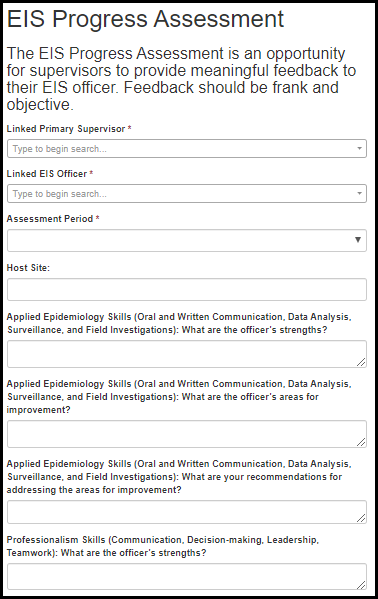
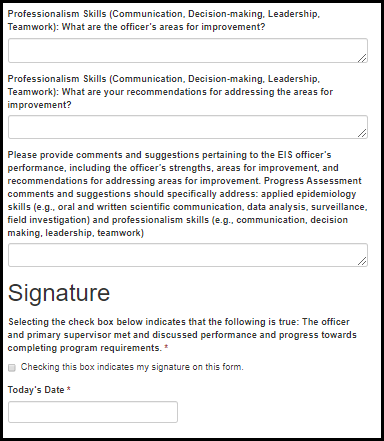
Table 8.6.1.a. EIS Progress Assessment Fields
Field Name |
Values |
EIS |
LLS |
FLIGHT |
EEP |
SAF |
PHIFP |
PE |
ELI |
PHAP |
Primary Supervisor Name: |
Supervisor Lookup |
Yes |
No |
No |
No |
No |
No |
No |
No |
No |
EIS Officer Name: |
Officer Lookup |
Yes |
No |
No |
No |
No |
No |
No |
No |
No |
Assessment Period: |
1.
6 Month |
Yes |
No |
No |
No |
No |
No |
No |
No |
No |
Host Site: |
- |
Yes |
No |
No |
No |
No |
No |
No |
No |
No |
Applied Epidemiology Skills (Oral and Written Communication, Data Analysis, Surveillance, and Field Investigations): What are the officer’s strengths? |
- |
Yes |
No |
No |
No |
No |
No |
No |
No |
No |
Applied Epidemiology Skills (Oral and Written Communication, Data Analysis, Surveillance, and Field Investigations): What are the officer’s areas for improvement? |
- |
Yes |
No |
No |
No |
No |
No |
No |
No |
No |
Applied Epidemiology Skills (Oral and Written Communication, Data Analysis, Surveillance, and Field Investigations): What are your recommendations for addressing the areas for improvement? |
- |
Yes |
No |
No |
No |
No |
No |
No |
No |
No |
Professionalism Skills (Communication, Decision-making, Leadership, Teamwork): What are the officer’s strengths? |
- |
Yes |
No |
No |
No |
No |
No |
No |
No |
No |
Professionalism Skills (Communication, Decision-making, Leadership, Teamwork): What are the officer’s areas for improvement?
|
- |
Yes |
No |
No |
No |
No |
No |
No |
No |
No |
Professionalism Skills (Communication, Decision-making, Leadership, Teamwork): What are your recommendations for addressing the areas for improvement? |
- |
Yes |
No |
No |
No |
No |
No |
No |
No |
No |
Comments and Suggestions: |
- |
Yes |
No |
No |
No |
No |
No |
No |
No |
No |
Signature: |
1. Checking this box indicates my signature on this form. |
Yes |
No |
No |
No |
No |
No |
No |
No |
No |
Today's Date: |
|
Yes |
No |
No |
No |
No |
No |
No |
No |
No |
8.6.2 Activity Review
Figure 8.6.2.a. Activity Review Fields

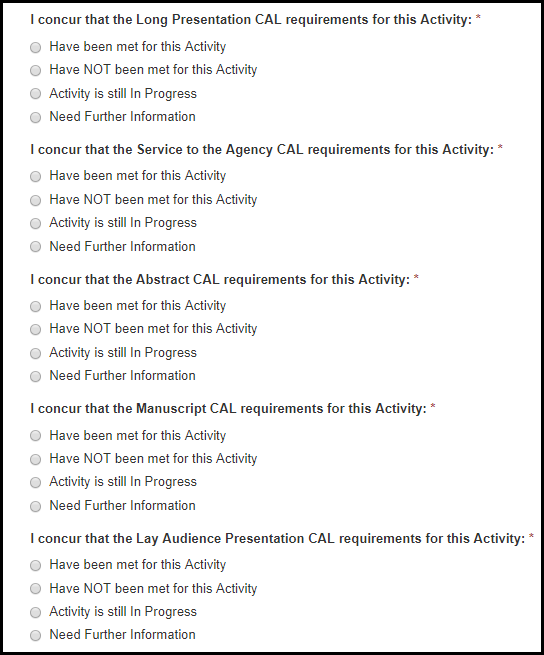
Figure 8.6.2.b. Activity Review Fields
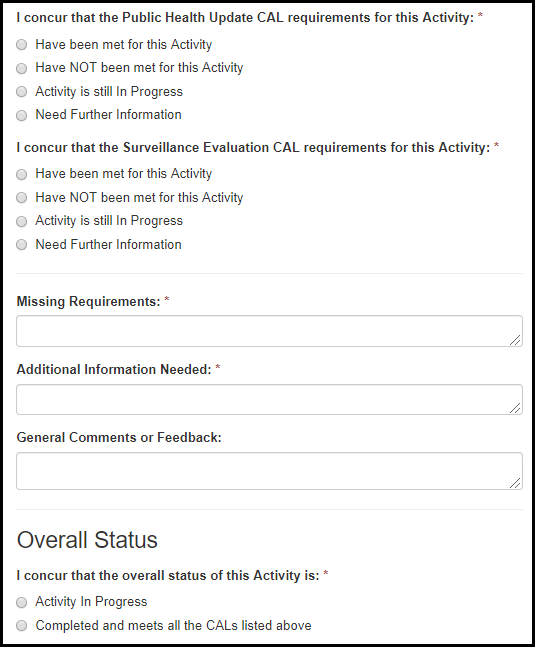
Table 8.6.2.a. Activity Review Fields
Field Name |
Values |
EIS |
LLS |
EEP |
SAF |
PHIFP |
PE |
ELI |
What CALs has the Officer listed for this activity?
|
1.
Field Investigation |
Yes |
No |
No |
No |
No |
No |
No |
I concur that the CAL requirements for this Activity: |
1.
Have been met for this Activity |
Yes |
No |
No |
No |
No |
No |
No |
Missing Requirements: |
- |
Yes |
Yes |
Yes |
Yes |
Yes |
Yes |
Yes |
Additional Information Needed: |
- |
Yes |
Yes |
Yes |
Yes |
Yes |
Yes |
Yes |
General Comments or Feedback: |
- |
Yes |
Yes |
Yes |
Yes |
Yes |
Yes |
Yes |
I concur that the overall status of this Activity is: |
1.
Activity in Progress |
Yes |
No |
No |
No |
No |
No |
No |
Figure 8.7.1.a. Project Review Fields

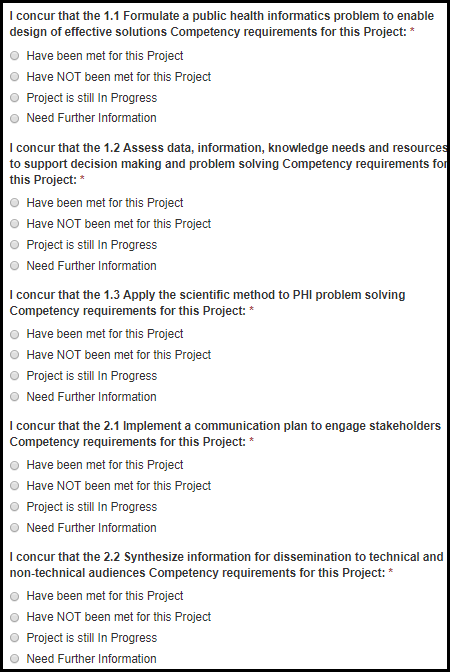
Figure 8.7.1.b. Project Review Fields

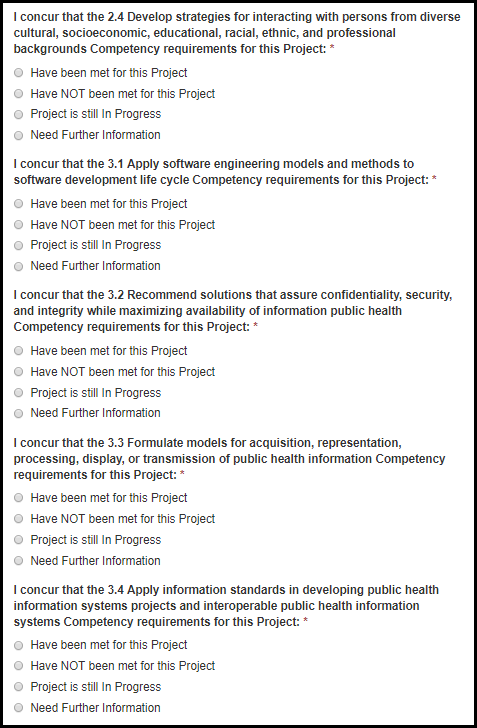
Figure 8.7.1.c. Project Review Fields
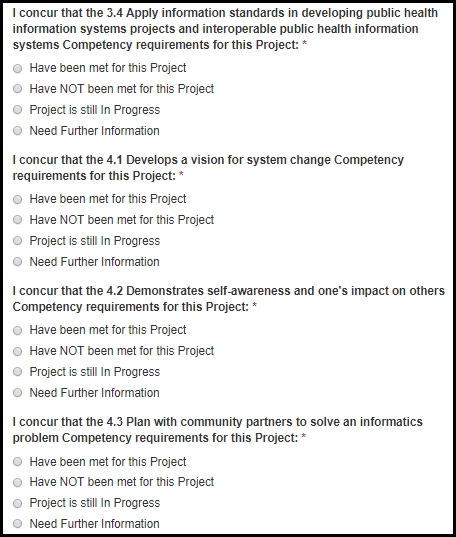
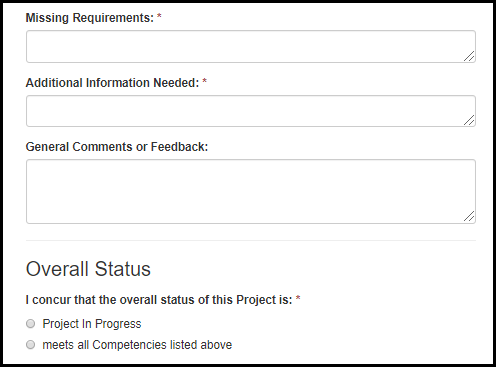
Table 8.7.1.a. Project Review Fields
Field Name |
Values |
EIS |
LLS |
EEP |
SAF |
PHIFP |
PE |
ELI |
PHAP |
What Competencies has the Fellow listed for this project? |
1.
1.1 Formulate a public health informatics problem to enable design
of effective solutions |
No |
No |
No |
No |
Yes |
No |
No |
No |
I concur that the Competency requirements for this Project: |
1.
Have been met for this Project |
No |
No |
No |
No |
Yes |
No |
No |
No |
Missing Requirements: |
- |
Yes |
Yes |
Yes |
Yes |
Yes |
Yes |
Yes |
Yes |
Additional Information Needed: |
- |
Yes |
Yes |
Yes |
Yes |
Yes |
Yes |
Yes |
Yes |
General Comments or Feedback: |
- |
Yes |
Yes |
Yes |
Yes |
Yes |
Yes |
Yes |
Yes |
I concur that the overall status of this Project is: |
1.
Project in Progress |
No |
No |
No |
No |
Yes |
No |
No |
No |
I. Field Value Tables
Appendix of Field Value Tables
Field Name |
Application Locations |
Values 1 |
Values 2 |
Values 3 |
Values 4 |
Approved Country List |
United States Anguilla Antigua Australia Bahamas Barbados Barbuda Belize Bermuda British Virgin Islands Canada Dominica Grand Cayman Islands
|
Grenada Guyana Irish Republic Jamaica Montserrat New Zealand Saint Kitts and Nevis St. Lucia St. Vincent & the Grenadine Tabago Trinidad Turks and Caicos Islands United Kingdom |
|
|
II. Lookup Tables
Appendix of Lookup Tables
Lookup Table Name |
Application Locations |
Values 1 |
Values 2 |
Values 3 |
Values 4 |
Values 5 |
Fellowship Lookup |
CDC E-learning Institute Fellowship Program (ELI) CDC Steven M. Teutsch Prevention Effectiveness (PE) Fellowship Epidemic Intelligence Service (EIS) Epidemiology Elective Program (EEP) Future Leaders in Infections and Global Health Threats (FLIGHT) Laboratory Leadership Service (LLS) Population Health Training in Place Program (PH-TIPP) Population Health Workforce Initiative (PHWI) Preventive Medicine Residency and Fellowship (PMR/F) Public Health Associate Program (PHAP) Public Health Informatics Fellowship Program (PHIFP) Science Ambassador Fellowship (SAF) |
|
|
|
|
|
State/Territory Lookup |
Alabama Alaska Arizona Arkansas California Colorado Connecticut Delaware Washington, DC Florida Georgia Hawaii Idaho Illinois Indiana Iowa Kansas Kentucky Louisiana Maine Maryland Massachusetts Michigan Minnesota Mississippi Missouri Montana Nebraska
|
Nevada New Hampshire New Jersey New Mexico New York North Carolina North Dakota Ohio Oklahoma Oregon Pennsylvania Rhode Island South Carolina South Dakota Tennessee Texas Utah Vermont Virginia Washington West Virginia Wisconsin Wyoming Puerto Rico Pacific Islands U.S. Virgin Islands Guam Northern Mariana Islands |
|
|
|
|
Center/Division/Branch Lookup |
NIOSH / Office of the Director / Administrative Svcs Branch (Cincinnati) NIOSH / Office of the Director / Administrative Svcs Branch (Morgantown) NIOSH / Office of the Director / Administrative Svcs Branch (Spokane) NIOSH / Office of the Director / Administrative Svrcs Branch (Pittsburgh) NCHS / Office of Analysis & Epidemiology / Aging & Chronic Disease Statistics Branch NIOSH / Health Effects Laboratory Division / Allergy & Clinical Immunology Branch NCHS / Division of Health Care Statistics / Ambulatory and Hospital Care Statistics Branch NIOSH / Division of Safety Research / Analysis & Field Branch NCHS / Division of Health & Nutrition Examination Surveys / Analysis Branch NCHS / Office of Analysis & Epidemiology / Analytic Studies Branch NCEZID / Division of Scientific Resources / Animal Resources Branch NCCDPHP / Division for Heart Disease and Stroke Prevention / Applied Research and Evaluation Branch NCCDPHP / Division of Population Health / Applied Research and Translation Branch CPR / Division of State and Local Readiness / Applied Science and Evaluation Branch NCCDPHP / Division of Reproductive Health / Applied Sciences Branch NCEZID / Division of Vector-Borne Diseases / Arboviral Diseases Branch NCEZID / Division of Preparedness and Emerging Infections / Arctic Investigations Program NCCDPHP / Division of Population Health / Arthritis, Epilepsy and Well-Being Branch NCIRD / Immunization Services Division / Assessment Branch NCEH / Division of Environmental Health Science and Practice / Asthma and Community Health Branch NCEZID / Division of Vector-Borne Diseases / Bacterial Diseases Branch NCEZID / Division of High Consequence Pathogens & Pathology / Bacterial Special Pathogens Branch NCHHSTP / Division of HIV/AIDS Prevention Surveillance & Epidemiology / Behavioral And Clinical S... NIOSH / Division of Applied Research & Technology / Biomonitoring & Health Assessment Branch NIOSH / Health Effects Laboratory Division / Biostatistics & Epidemiology Branch NCEZID / Division of Foodborne, Waterborne and Environmental Diseases / Biostatistics and Informa... NCEZID / Division of Scientific Resources / Biotechnology Core Facility Branch NCBDDD / Division of Congenital and Developmental Disorders / Birth Defects Branch NCHS / Office of Management & Operations / Building Operations & Services Staff NCHS / Office of Management & Operations / Business Logistics Staff NCCDPHP / Division of Cancer Prevention and Control / Cancer Surveillance Branch NCHHSTP / Division of HIV/AIDS Prevention-Intervention & Support / Capacity Building Branch CPR / Division of State and Local Readiness / Capacity Building Branch ATSDR / Division of Community Health Investigations / Central Branch NIOSH / Division of Applied Research & Technology / Chemical Exposure & Monitoring NCBDDD / Division of Human Development and Disability / Child Development and Disability Branch NCEZID / Division of High Consequence Pathogens & Pathology / Chronic Viral Diseases Branch NCHS / Classification & Public Health Data Standards Staff / Classification & Public Health Data ... NCEZID / Division of Healthcare Quality Promotion / Clinical & Environmental Microbiology Branch NCEH / Division of Laboratory Science / Clinical chemistry branch NCHHSTP / Division of Tuberculosis Elimination / Clinical Research Branch NCHS / Division of Research & Methodology / Collaborating Center for Questionnaire Design & Evalu... NCHS / Division of Research & Methodology / Collaborating Center for Statistical Research & Surve... NCIRD / Immunization Services Division / Communication and Education Branch NCHHSTP / Division of Tuberculosis Elimination / Communications, Education, and Behavioral Studie... CSELS / Division of Public Health Information and Dissemination / Community Guide Branch NCCDPHP / Division of Cancer Prevention and Control / Comprehensive Cancer Control Branch ATSDR / Division of Toxicology and Human Health Sciences / Computational Toxicology and Methods D... NIOSH / Education & Information Division / Document Development Branch NIOSH / National Personal Protective Technology Laboratory / Conformity Verification & Standards ... NCCDPHP / Division of Population Health / Coordinated State Support Branch NIOSH / Pittsburgh Mining Research Division / Dust, Ventilation & Toxic Substances Branch CGH / Division of Global Health Protection / Country Strategy and Implementation Branch ATSDR / Division of Community Health Investigations / Eastern Branch NCHS / Division of Vital Statistics / Data Acquisition, Classification & Evaluation Branch CGH / Division of Global HIV and TB / Economics and Health Services Research Branch
|
NCHS / Division of Health Interview Statistics / Data Analysis & Quality Assurance Branch CSELS / Division of Scientific Education and Professional Development / Education and Training Se... NCHHSTP / Division of Tuberculosis Elimination / Data Management and Statistics Branch NIOSH / Pittsburgh Mining Research Division / Electrical & Mechanical Systems Safety Branch NCHS / Division of Health Interview Statistics / Data Production & Systems Branch CPR / Division of Emergency Operations / Emergency and Risk Communications Branch NCEZID / Division of Vector-Borne Diseases / Dengue Branch NCEH / Division of Environmental Health Science and Practice / Emergency Management, Radiation, a... NCBDDD / Division of Congenital and Developmental Disorders / Developmental Disabilities Branch NCEZID / Division of Preparedness and Emerging Infections / Emergency Preparedness and Response B... NCBDDD / Division of Human Development and Disability / Disability and Health Branch CGH / Division of Global Health Protection / Emergency Response and Recovery Branch NIOSH / Division of Compensation Analysis & Support / Division of Compensation Analysis & Support NCEH / Division of Laboratory Science / Emergency response branch NCCDPHP / Division of Oral Health / Division of Oral Health ATSDR / Division of Toxicology and Human Health Sciences / Emergency Response Program NIOSH / Health Effects Laboratory Division / Engineering & Control Branch NIOSH / Division of Applied Research & Technology / Engineering & Physical Hazards Branch NCEZID / Division of Foodborne, Waterborne and Environmental Diseases / Enteric Diseases Epidemio... NCEZID / Division of Foodborne, Waterborne and Environmental Diseases / Enteric Diseases Laborato... CGH / Division of Parasitic Diseases and Malaria / Entomology Branch ATSDR / Division of Toxicology and Human Health Sciences / Environmental Epidemiology Branch NCCDPHP / Division of Population Health / Epidemiology and Surveillance Branch NCEH / Division of Emergency and Environmental Health Services / Environmental Health Services Br... ATSDR / Division of Toxicology and Human Health Sciences / Environmental Health Surveillance Branch NCHHSTP / Division of Viral Hepatitis / Epidemiology and Surveillance Branch ATSDR / Division of Toxicology and Human Health Sciences / Environmental Medicine Branch NCHHSTP / Division of HIV/AIDS Prevention Surveillance & Epidemiology / Epidemiology Branch NCEH / Division of Emergency and Environmental Health Services / Environmental Public Health Read... NCCDPHP / Office on Smoking and Health / Epidemiology Branch ATSDR / Division of Toxicology and Human Health Sciences / Environmental Toxicology Branch NCEZID / Division of Healthcare Quality Promotion / Epidemiology Research and Innovations Branch NCCDPHP / Division of Cancer Prevention and Control / Epidemiology and Applied Research Branch CSELS / Division of Scientific Education and Professional Development / Epidemiology Workforce Br... NCIRD / Influenza Division / Epidemiology and Prevention Branch CGH / Division of Global Health Protection / Epidemiology, Informatics, Surveillance and Lab Branch NCCDPHP / Division of Diabetes Translation / Epidemiology and Statistics Branch NIOSH / National Personal Protective Technology Laboratory / Evaluation & Testing Branch NCHHSTP / Division of Sexually Transmitted Disease Prevention / Epidemiology and Statistics Branch NIOSH / Health Effects Laboratory Division / Exposure Assessment Branch NCCDPHP / Division for Heart Disease and Stroke Prevention / Epidemiology and Surveillance Branch NCHHSTP / Division of Sexually Transmitted Disease Prevention / Field Services Branch NCBDDD / Division of Blood Disorders / Epidemiology and Surveillance Branch CPR / Division of State and Local Readiness / Field Services Branch CGH / Division of Global HIV and TB / Epidemiology and Surveillance Branch NCHHSTP / Division of Tuberculosis Elimination / Field Services Branch NIOSH / Respiratory Health Division / Field Studies Branch NCCDPHP / Division of Reproductive Health / Field Support Branch
|
NIOSH / Pittsburgh Mining Research Division / Fires and Explosions Branch NCEZID / Division of Foodborne, Waterborne and Environmental Diseases / Food Safety Office NCEZID / Division of Global Migration and Quarantine / Geographic Medicine and Health Promotion B... NCHS / Office of Analysis & Epidemiology / Health Promotion Statistics Branch ATSDR / Division of Toxicology and Human Health Sciences / Geospatial Research, Analysis, and Ser... CGH / Division of Global Health Protection / Global Non-communicable Disease Branch NCCDPHP / Office on Smoking and Health / Global Tobacco Control Branch NCHHSTP / Division of Sexually Transmitted Disease Prevention / Health Services Research and Eval... CGH / Division of Global HIV and TB / Global Tuberculosis Branch NCIPC / Division of Unintentional Injury Prevention / Health Systems and Trauma Systems Branch NIOSH / Pittsburgh Mining Research Division / Ground Control Branch NCEH / Division of Emergency and Environmental Health Services / Healthy Community Design Initiative NIOSH / Division of Surveillance, Hazard Evaluations & Field Studies / Hazard Evaluations & Techn... NCEH / Division of Emergency and Environmental Health Services / Healthy Homes and Lead Poisoning... NIOSH / Health Effects Laboratory Division / Health Communication Research Branch NCBDDD / Division of Blood Disorders / Hemostasis Laboratory Branch NCCDPHP / Office of the Director / Health Communication Science Office NCHHSTP / Office of the Director / Health Communication Science Office CGH / Division of Global HIV and TB / HIV Care and Treatment Branch NCBDDD / Office of the Director / Health Communication Science Office NCHHSTP / Division of HIV/AIDS Prevention Surveillance & Epidemiology / HIV Incidence and Case Su... NIOSH / Pittsburgh Mining Research Division / Health Communication, Surveillance, Research Suppor... CGH / Division of Global HIV and TB / HIV Prevention Branch NCCDPHP / Office on Smoking and Health / Health Communications Branch NCIPC / Division of Unintentional Injury Prevention / Home, Recreation, and Transportation Branch CGH / Division of Global HIV and TB / Health Informatics, Data Management, and Statistics Branch NIOSH / Pittsburgh Mining Research Division / Human Factors Branch NCEZID / Division of Global Migration and Quarantine / Immigrant, Refugee, and Migrant Health Branch NCIRD / Immunization Services Division / Immunization Information System Support Branch NCEZID / Division of Healthcare Quality Promotion / Immunization Safety Office CGH / Global Immunization Division / Immunization System Branch NCIRD / Influenza Division / Immunology and Pathogenesis Branch NIOSH / Division of Surveillance, Hazard Evaluations & Field Studies / Industrywide Studies Branch NCHS / Office of Analysis & Epidemiology / Infant, Child, & Women?s Health Statistics Branch NCEZID / Division of High Consequence Pathogens & Pathology / Infectious Diseases Pathology Branch NCIRD / Office of the Director / Influenza Coordination Unit CGH / Division of Global HIV and TB / International Laboratory Branch NCHS / Division of Health & Nutrition Examination Surveys / Informatics Branch CSELS / Division of Public Health Information and Dissemination / Informatics Innovation Unit NCHHSTP / Division of HIV/AIDS Prevention Surveillance & Epidemiology / Laboratory Branch NCHHSTP / Office of the Director / Informatics Office NCHHSTP / Division of Tuberculosis Elimination / Laboratory Branch NCHS / Office of Information Services / Information Design & Publishing Staff NCHHSTP / Division of Viral Hepatitis / Laboratory Branch NCHS / Office of Information Services / Information Dissemination Staff NIOSH / Education & Information Division / Information Resources and Dissemination Branch CSELS / Division of Laboratory Systems / Laboratory Practice Standards Branch NCEZID / Division of Preparedness and Emerging Infections / Laboratory Preparedness and Response ... CSELS / Division of Health Informatics and Surveillance Systems / Information Systems Branch NCHHSTP / Division of Sexually Transmitted Disease Prevention / Laboratory Reference and Research... NCHS / Division of Vital Statistics / Information Technology Branch NCHS / Office of Information Technology / Information Technology Solutions & Services Staff CSELS / Division of Laboratory Systems / Laboratory
|
Research and Evaluation Branch NCEH / Division of Laboratory Science / Inorganic and radiation analytical toxicology branch CSELS / Division of Laboratory Systems / Laboratory Training and Services Branch NCEH / Division of Environmental Health Science and Practice / Lead Poisoning Prevention and Envi... CSELS / Division of Public Health Information and Dissemination / Library Science Branch CPR / Division of Strategic National Stockpile / Logistics Branch CPR / Division of Emergency Operations / Logistics Support Branch NCHS / Division of Health Care Statistics / Long-Term Care Statistics Branch CGH / Division of Parasitic Diseases and Malaria / Malaria Branch CGH / Division of Global HIV and TB / Management and Operations Branch NIOSH / Office of the Director / Management Systems Branch CGH / Division of Global HIV and TB / Maternal and Child Health Branch NCCDPHP / Division of Reproductive Health / Maternal and Infant Health Branch NCIRD / Division of Bacterial Branch / Meningitis and Vaccine Preventable Diseases Branch CGH / Division of Global HIV and TB / Monitoring, Evaluation, and Data Analysis Branch NIOSH / Office of the Director / Office of Extramural Coordination & Special Projects NCHS / Division of Vital Statistics / Mortality Statistics Branch NCEZID / Division of Foodborne, Waterborne and Environmental Diseases / Mycotic Diseases Branch NCEH / Office of the Director / Office of Financial, Administrative, and Information Services NCEH / Division of Laboratory Science / Newborn screening and molecular biology branch NCIRD / Office of the Director / Office of Health Communication Science NCCDPHP / Division of Nutrition, Physical Activity, & Obesity / Nutrition Branch NCHHSTP / Office of the Director / Office of Health Equity NCEH / Division of Laboratory Science / Nutritional biomarkers branch NCIRD / Office of the Director / Office of Informatics NCCDPHP / Division of Nutrition, Physical Activity, & Obesity / Obesity Prevention and Control Br... NCIRD / Office of the Director / Office of Laboratory Science NIOSH / Office of the Director / Office of Administrative & Management Svcs NCIRD / Office of the Director / Office of Management and Operations NCEH / Office of the Director / Office of Communication NCHHSTP / Office of the Director / Office of Management and Program Support NCIPC / Office of the Director / Office of Communication NCHS / Office of Planning Budget and Legislation / Office of Planning Budget and Legislation NCIRD / Office of the Director / Office of Policy NCIPC / Office of the Director / Office of Policy and Partnerships NCEH / Office of the Director / Office of Policy, Planning, and Evaluation NCIPC / Office of the Director / Office of Program Management and Operations NCHHSTP / Office of the Director / Office of Program Planning & Policy Coordination CSELS / Division of Public Health Information and Dissemination / Office of Public Health Genomics NCCDPHP / Office of the Director / Office of Public Health Practice NCIRD / Office of the Director / Office of Science and Integrated Programs NCHHSTP / Office of the Director / Office of the Associate Director for Laboratory Science NCHHSTP / Office of the Director / Office of the Associate Director for Science NCIPC / Office of the Director / Office of the Associate Director for Science NCHS / Office of the Director / Office of the Director NCHS / Division of Health & Nutrition Examination Surveys / Office of the Director NCHS / Division of Health Care Statistics / Office of the Director CPR / Office of the Director / Office of the Director NCHS / Division of Health Interview Statistics / Office of the Director NCEZID / Division of Healthcare Quality Promotion / Office of the Director/International Infectio... NCCDPHP / Division of Reproductive Health / Office of the Director NCCDPHP / Division of Cancer Prevention and Control / Office of the Director/Office of Internatio... NCHS / Division of Vital Statistics / Office of the Director NCEZID / Office of the Director / One Health Office NCHS / Office of Analysis & Epidemiology / Office of the Director CPR / Division of Emergency Operations / Operations Branch CGH / Office of the Director / Office of the Director NCHS / Division of Health & Nutrition Examination Surveys / Operations Branch CSELS / Office of the Director / Office of the Director
|
CPR / Division of Select Agents and Toxins / Operations Branch NCEZID / Office of the Director / Office of the Director NCEH / Division of Laboratory Science / Organic analytical toxicology branch NCHS / Office of the Director / Office of the Director NIOSH / Division of Applied Research & Technology / Organizational Science & Human Factors Branch NCEZID / Division of Foodborne, Waterborne and Environmental Diseases / Outbreak Response and Pre... CGH / Division of Global Health Protection / Overseas Business Operations Branch CGH / Division of Global HIV and TB / Overseas Strategy and Management Branch CGH / Division of Parasitic Diseases and Malaria / Parasitic Diseases Branch CSELS / Division of Health Informatics and Surveillance Systems / Partnerships and Evaluation Branch NIOSH / Health Effects Laboratory Division / Pathology & Physiological Research Branch NCCDPHP / Division of Nutrition, Physical Activity, & Obesity / Physical Activity and Health Branch CPR / Division of Strategic National Stockpile / Planning and Analysis Branch NCHS / Division of Health & Nutrition Examination Surveys / Planning Branch CPR / Division of Emergency Operations / Plans, Training, Exercise and Evaluation Branch NCIPC / Division of Violence Prevention / Prevention Practice and Translation Branch NCBDDD / Office of the Director / Policy, Planning, and Evaluation Team NCHHSTP / Division of HIV/AIDS Prevention-Intervention & Support / Prevention Program Branch NCIRD / Division of Viral Diseases / Polio and Picornavirus Laboratory Branch NCBDDD / Division of Congenital and Developmental Disorders / Prevention Research and Translation... CGH / Global Immunization Division / Polio Eradication NCCDPHP / Division of Population Health / Population Health Surveillance Branch NCHHSTP / Division of HIV/AIDS Prevention-Intervention & Support / Prevention Research Branch CSELS / Division of Scientific Education and Professional Development / Population Health Workfor... NCEZID / Division of High Consequence Pathogens & Pathology / Prion & Public Health Office NCEZID / Division of High Consequence Pathogens & Pathology / Poxvirus and Rabies Branch NCHHSTP / Office of the Director / Program and Performance Improvement Office NCIPC / Division of Analysis, Research, and Practice Integration / Practice Integration and Evalu... CGH / Division of Global HIV and TB / Program Budget and Extramural Management Branch NCEZID / Division of Healthcare Quality Promotion / Prevention & Response Branch NCCDPHP / Division of Nutrition, Physical Activity, & Obesity / Program Development and Evaluatio... NCHHSTP / Division of Viral Hepatitis / Prevention Branch NCCDPHP / Division for Heart Disease and Stroke Prevention / Program Development and Services Branch NCHHSTP / Division of HIV/AIDS Prevention-Intervention & Support / Prevention Communications Branch NCHHSTP / Division of Adolescent and School Health / Program Development and Services Branch NCHHSTP / Division of HIV/AIDS Prevention-Intervention & Support / Program Evaluation Branch NCCDPHP / Division of Diabetes Translation / Program Implementation Branch CPR / Division of Select Agents and Toxins / Program Management and Operations Branch NCIRD / Immunization Services Division / Program Operations Branch NCCDPHP / Division of Cancer Prevention and Control / Program Services Branch CPR / Division of Select Agents and Toxins / Program Services Branch CPR / Division of State and Local Readiness / Program Services Branch NCCDPHP / Office of the Director / Program Services Branch NCCDPHP / Office on Smoking and Health / Program Services Branch NCHHSTP / Division of Sexually Transmitted Disease Prevention / Programs Development and Quality ... NIOSH / Division of Safety Research / Protective Technology Branch NCIRD / Division of Viral Diseases / Respiratory Viruses Branch NCHHSTP / Division of HIV/AIDS Prevention Surveillance & Epidemiology / Quantitative Sciences and... NCEZID / Division of Global Migration and Quarantine / Quarantine and Border Health Services Branch CPR / Division of Strategic National Stockpile / Response Branch NCHS / Division of Vital Statistics / Reproductive Statistics Branch NCEZID / Division of Vector-Borne Diseases / Rickettsial Zoonoses Branch NCIPC / Division of Violence Prevention / Research and Evaluation Branch NIOSH / Education & Information Division / Risk Evaluation Branch NCHHSTP / Division of Adolescent and School Health / Research Application and Evaluation Branch NCCDPHP / Division of Population Health / School Health Branch NIOSH / National Personal Protective Technology Laboratory / Research Branch NCHS / Division of Research & Methodology / Research Data Center NCHHSTP / Division of Adolescent and School Health / School-Based Surveillance Branch NCBDDD / Office of the Director / Resource Management Office NCBDDD / Office of the Director / Science and Public Health Team NCIRD / Division of Bacterial Branch / Respiratory Diseases Branch CGH / Division of Global HIV and TB / Science Integrity Branch ATSDR / Division of Community Health Investigations / Science Support Branch NCEZID / Division of Preparedness and Emerging Infections / Scientific and Program Services Branch NCEZID / Division of Scientific Resources / Scientific Products and Support Branch CSELS / Division of Public Health Information and Dissemination / Scientific Publications Branch NCHHSTP / Division of Sexually Transmitted Disease Prevention / Social and Behavioral Research an... CGH / Division of Global HIV and TB / Special Initiatives Branch NCHS / Office of Analysis & Epidemiology / Special Projects Branch NCIPC / Division of Violence Prevention / Special Surveys & Prevention Initiatives Branch (proposed) NCEZID / Division of Scientific Resources / Specimen Management Branch NIOSH / Spokane Mining Research Division / Spokane Mining Research Division NIOSH / Division of Surveillance, Hazard Evaluations & Field Studies / Statistical Support Most E... NCIPC / Division of Analysis, Research, and Practice Integration / Statistics, Programming, and E... CGH / Global Immunization Division / Strategic Information and Workforce Development Branch NCHS / Division of Health Interview Statistics / Survey Planning & Special Surveys Branch CGH / Division of Global HIV and TB / Strategy, Policy, and Communication Branch CSELS / Division of Health Informatics and Surveillance Systems / Surveillance and Data Branch NCHS / Division of Health Care Statistics / Technical Services Branch NCHHSTP / Division of Sexually Transmitted Disease Prevention / Surveillance and Data Management ... NCEH / Division of Laboratory Science / Tobacco and volatiles branch NIOSH / Health Effects Laboratory Division / Toxicology & Molecular Biology Branch NIOSH / Division of Safety Research / Surveillance and Field Investigations Branch NIOSH / Education & Information Division / Training Research & Evaluation Branch NCEZID / Division of Healthcare Quality Promotion / Surveillance Branch NCCDPHP / Division of Diabetes Translation / Translation, Health Education and Evaluation Branch NIOSH / Division of Surveillance, Hazard Evaluations & Field Studies / Surveillance Branch NCEZID / Division of Global Migration and Quarantine / U.S. - Mexico Unit NCIPC / Division of Violence Prevention / Surveillance Branch NCIRD / Immunization Services Division / Vaccine Supply and Assurance Branch NIOSH / Respiratory Health Division / Surveillance Branch NCIRD / Division of Viral Diseases / Viral Gastroenteritis Branch NCHHSTP / Division of Tuberculosis Elimination / Surveillance, Epidemiology, & Outbreak Investiga... NCEZID / Division of High Consequence Pathogens & Pathology / Viral Special Pathogens Branch NCIRD / Division of Viral Diseases / Viral Vaccine Preventable Diseases Branch NCIRD / Influenza Division / Virology, Surveillance and Diagnosis Branch NCEH / Division of Environmental Health Science and Practice / Water, Food, and Environmental Hea... NCEZID / Division of Foodborne, Waterborne and Environmental Diseases / Waterborne Diseases Preve... ATSDR / Division of Community Health Investigations / Western Branch NIOSH / Western States Division / Western States Division NCCDPHP / Division of Reproductive Health / Women?s Health and Fertility Branch NCHS / Office of Management & Operations / Workforce & Career Development Staff CGH / Division of Global Health Protection / Workforce and Institute Development Branch NIOSH / Pittsburgh Mining Research Division / Workplace Health Branch NIOSH / World Trade Center Health Program / World Trade Center Health Program NCBDDD / Division of Congenital and Developmental Disorders / Zika Transition Unit CGH / Global Immunization Division / Accelerated Disease Control and Vaccine Preventable Diseases... NCCDPHP / Office on Smoking and Health / Office of the Director |
|
Subject Area Lookup |
Adolescent & School Health (non-STI) Community Health Improvement Planning (CHIP)/Community Health Assessments (CHA) Chronic Disease Emergency/Disaster Preparedness and Response Environmental Health Genomics Health Equity/Access to Care Health Department Improvement/Accreditation Immunizations/Vaccine Preventable Disease Investigation Sexually Transmitted Disease Prevention Tuberculosis Prevention HIV Prevention Viral Hepatitis Prevention Adolescent/school-based Sexually Transmitted Disease prevention Other Infectious Disease Injury Prevention Maternal & Infant Health Public Health Policy & Law Public Health Surveillance Oral Health |
|
|
|
|

| File Type | application/vnd.openxmlformats-officedocument.wordprocessingml.document |
| File Modified | 0000-00-00 |
| File Created | 0000-00-00 |
© 2025 OMB.report | Privacy Policy